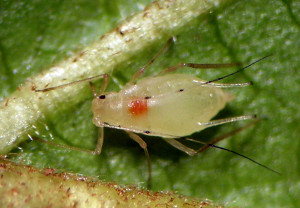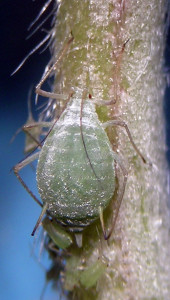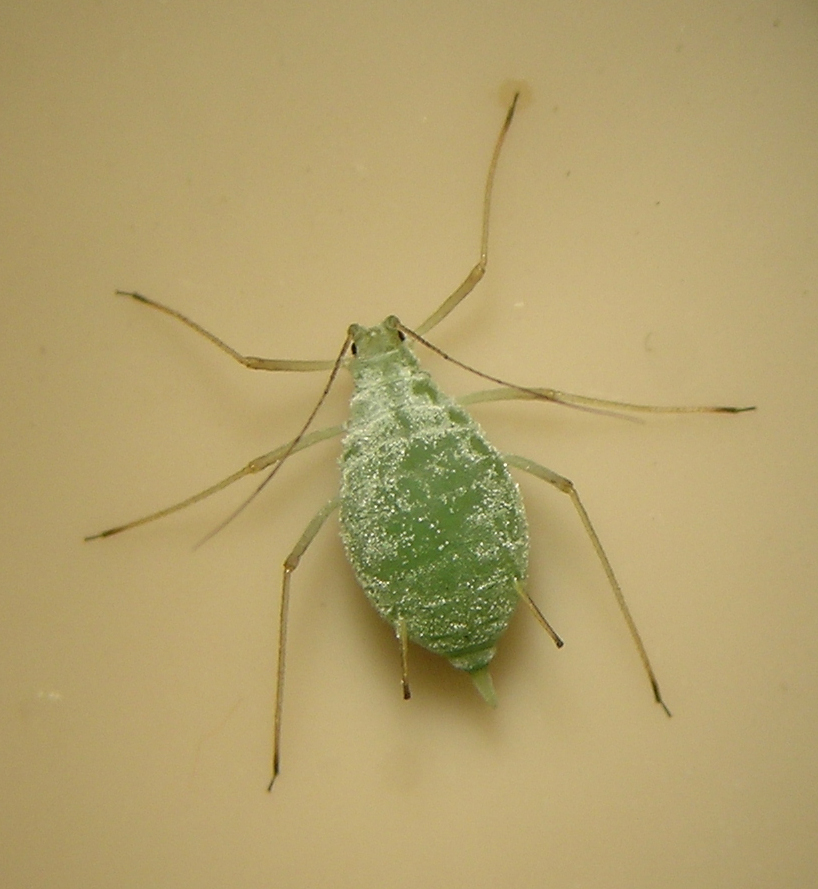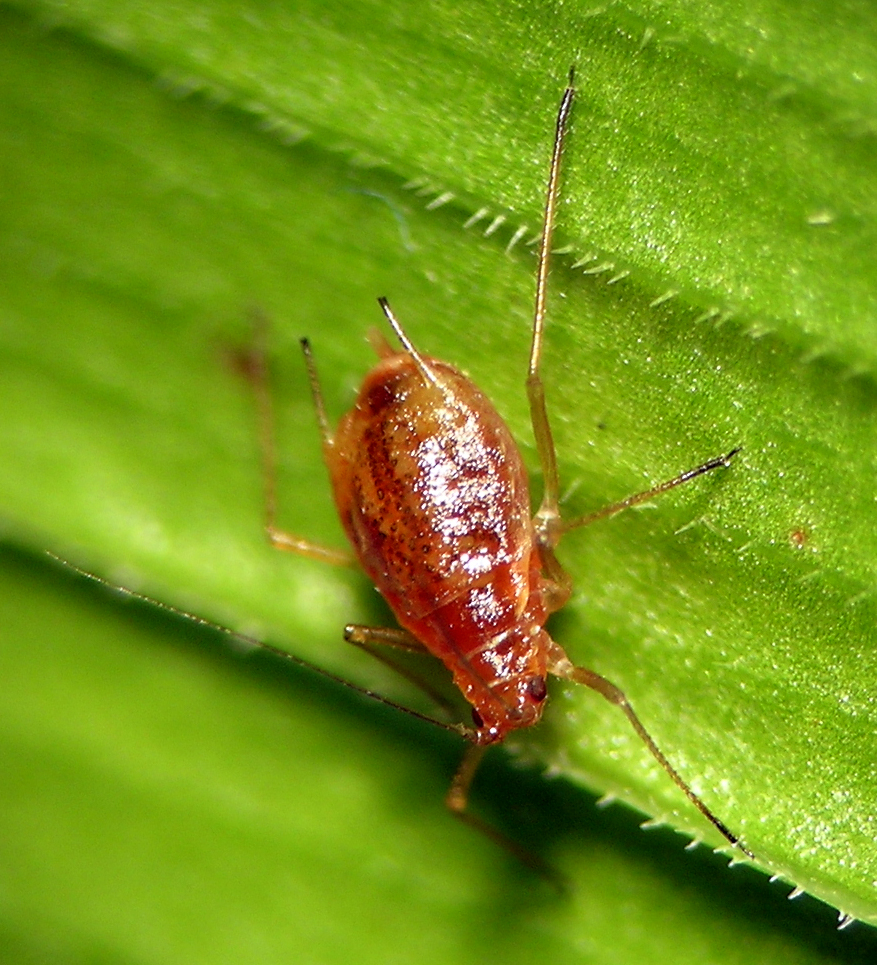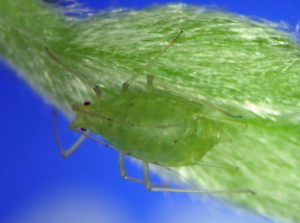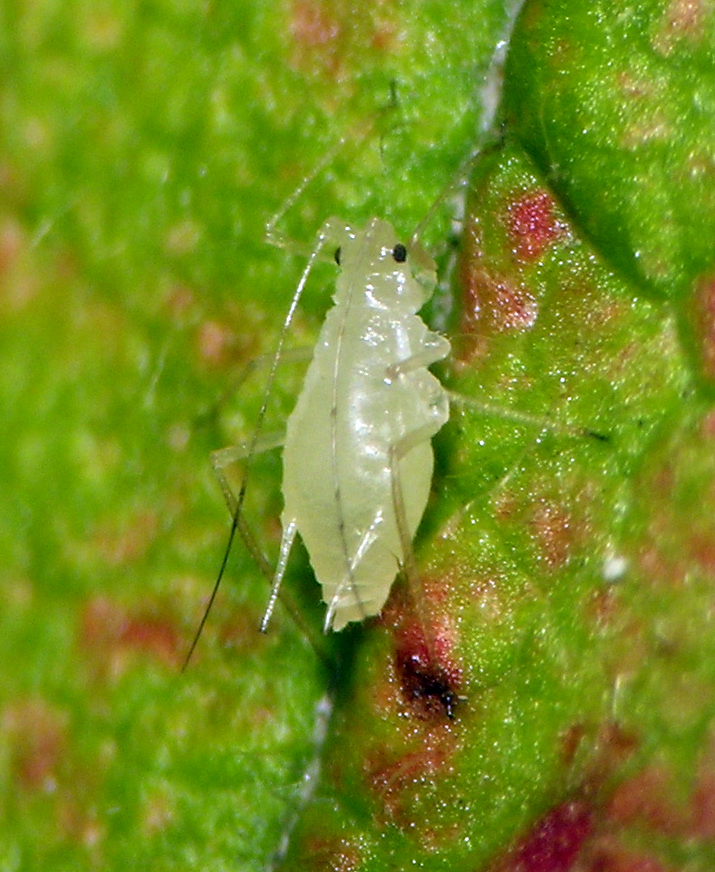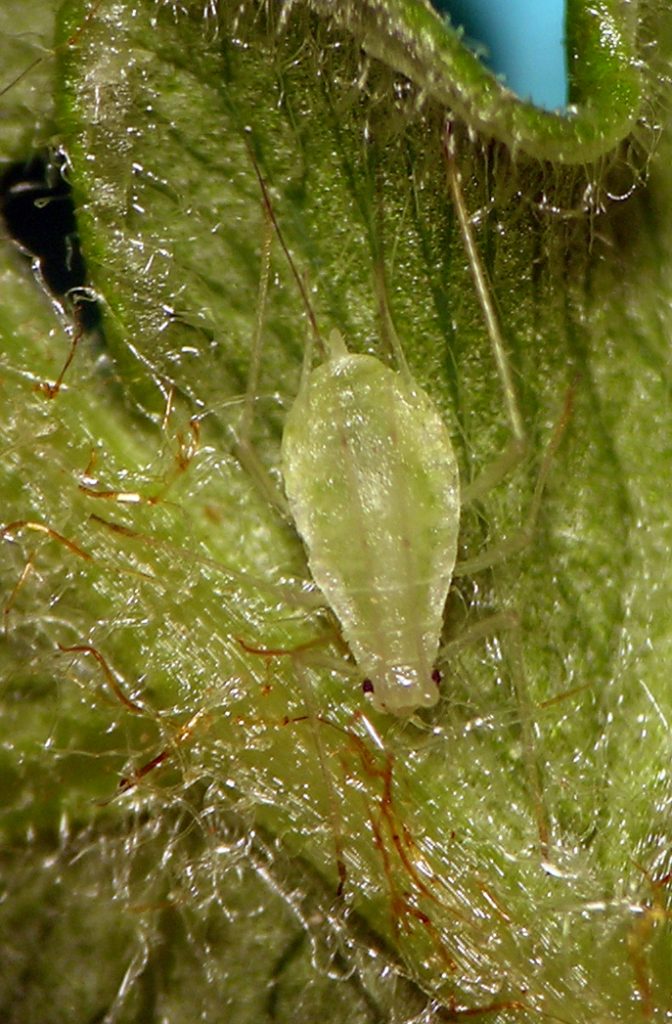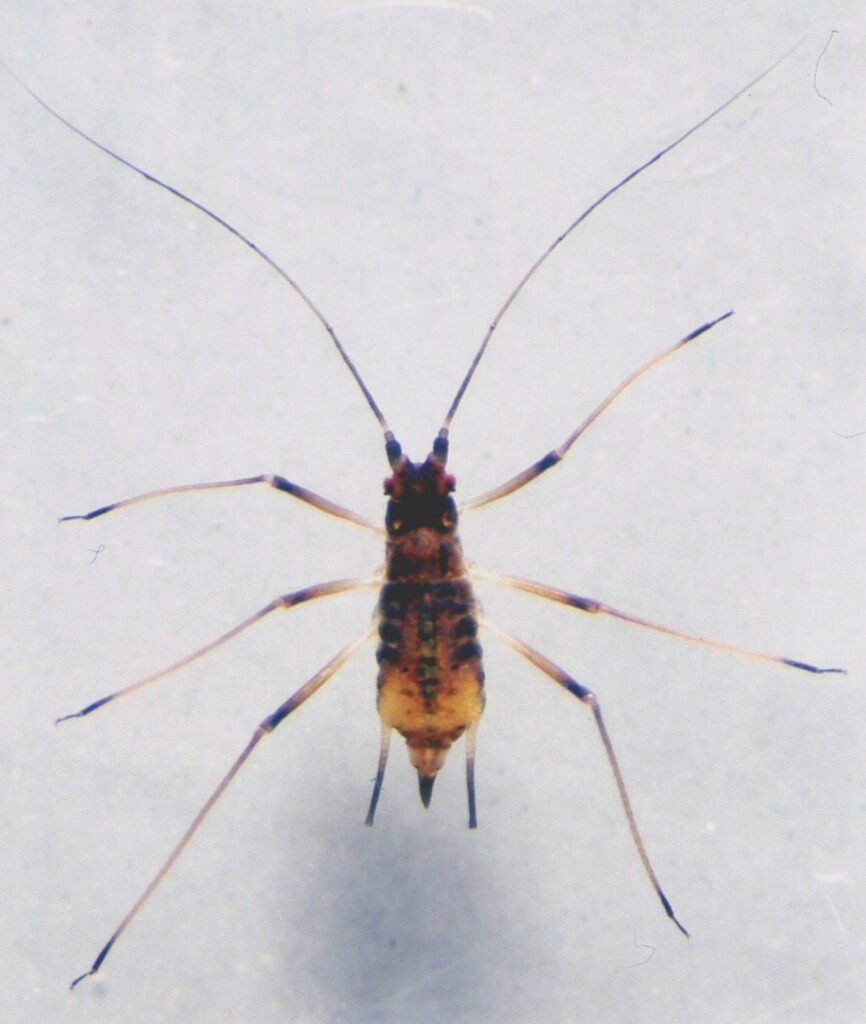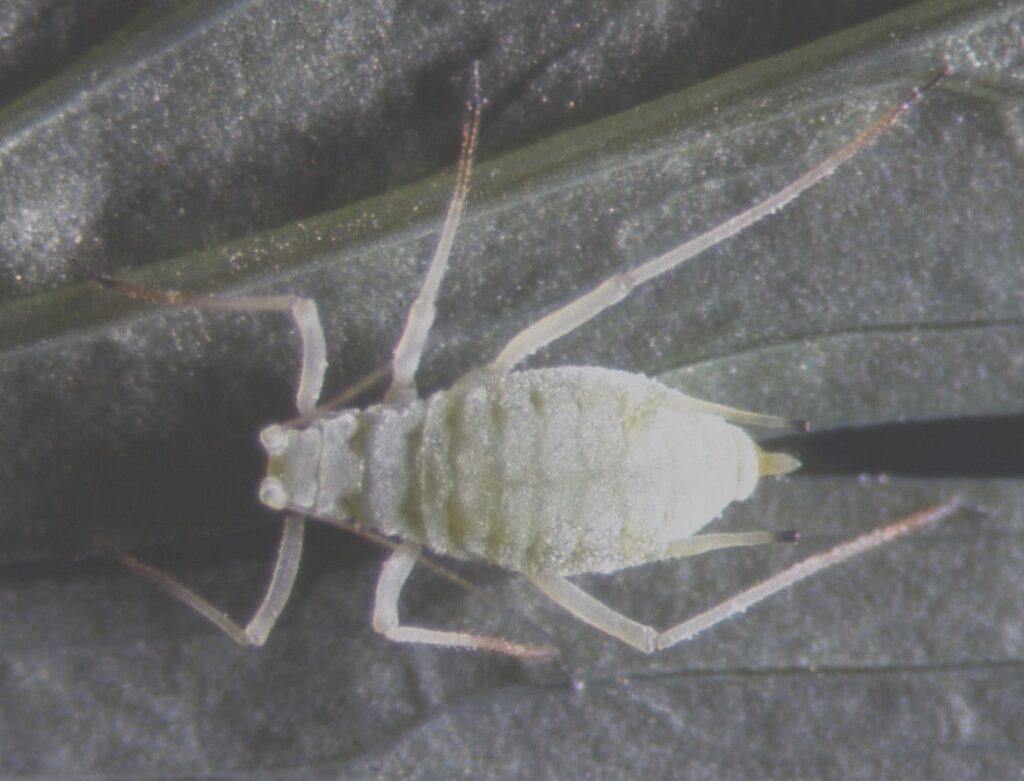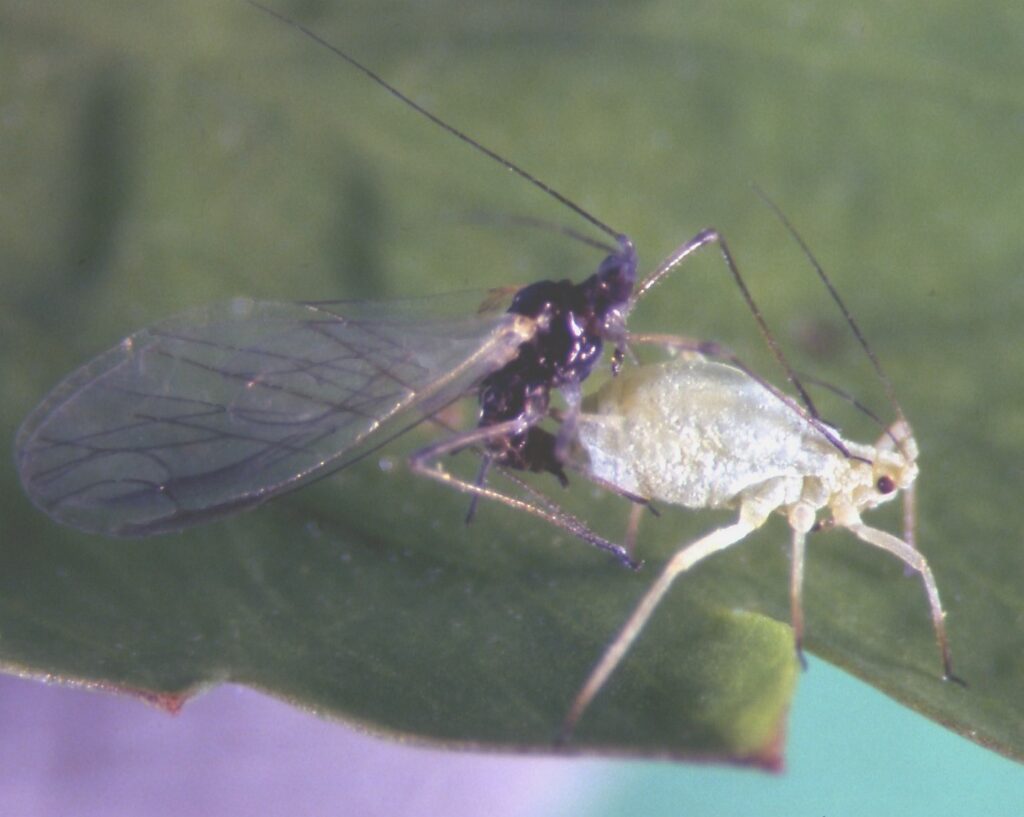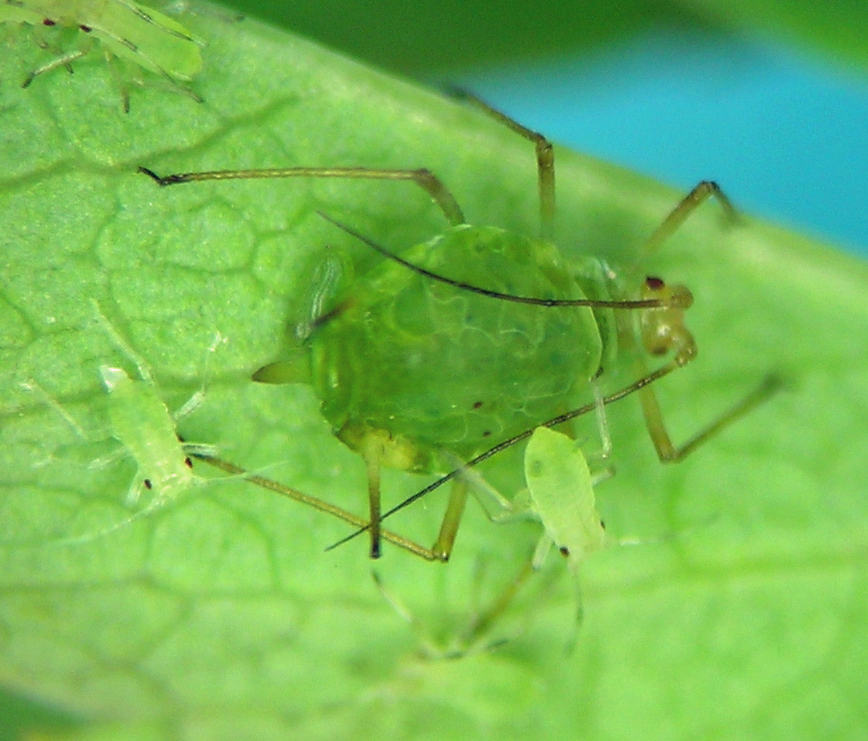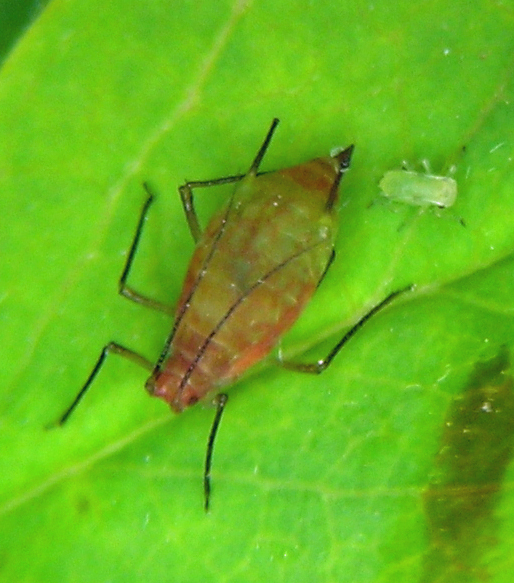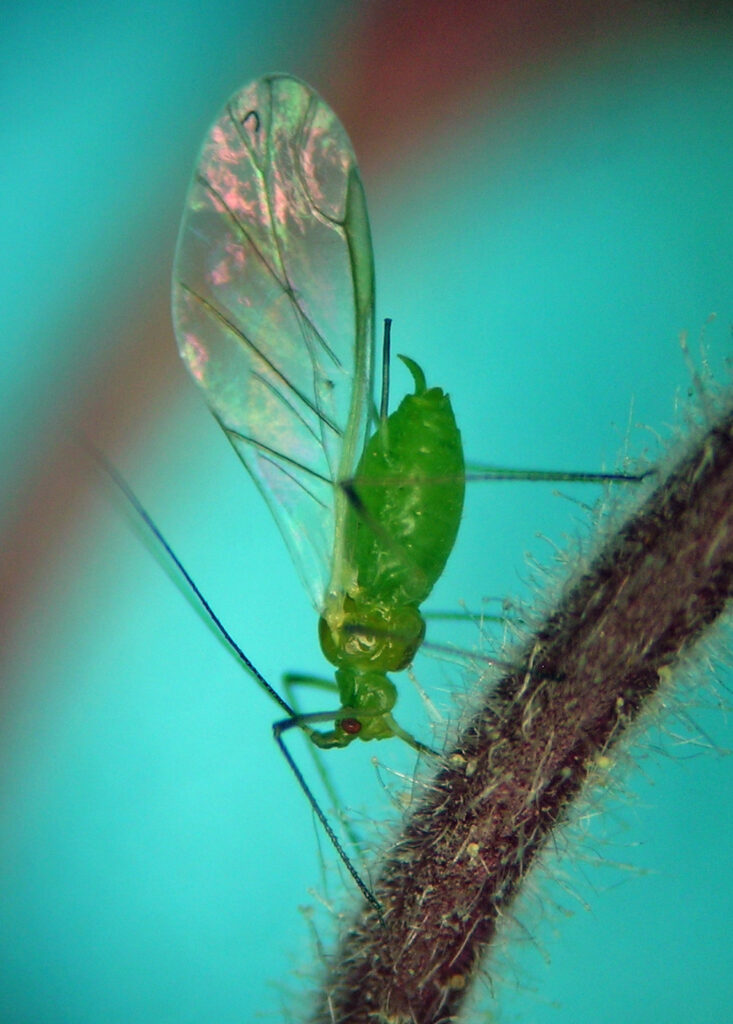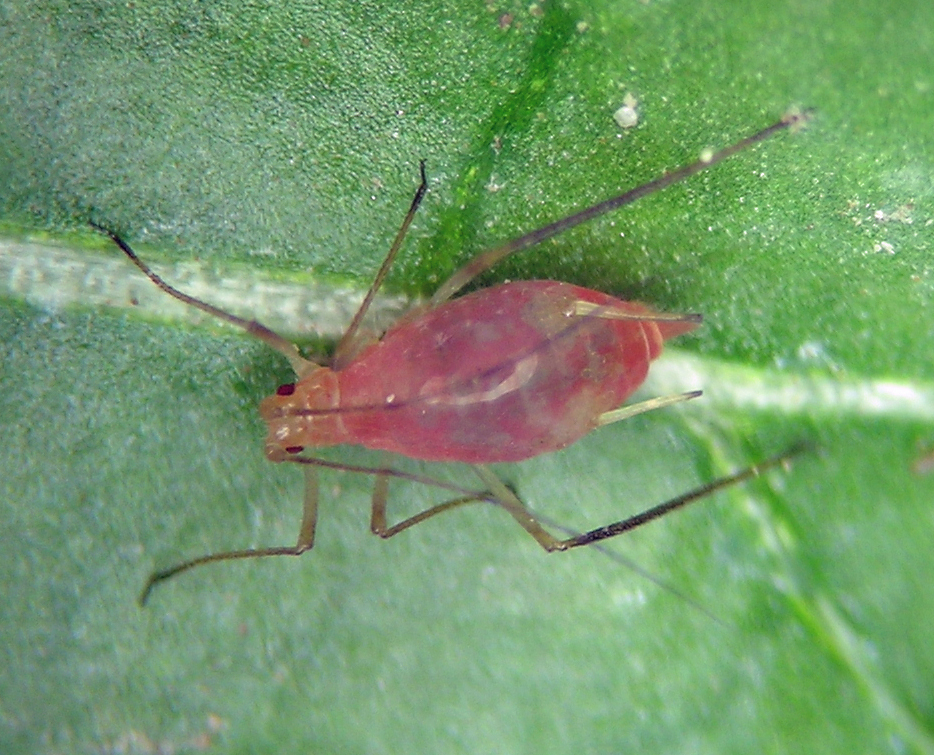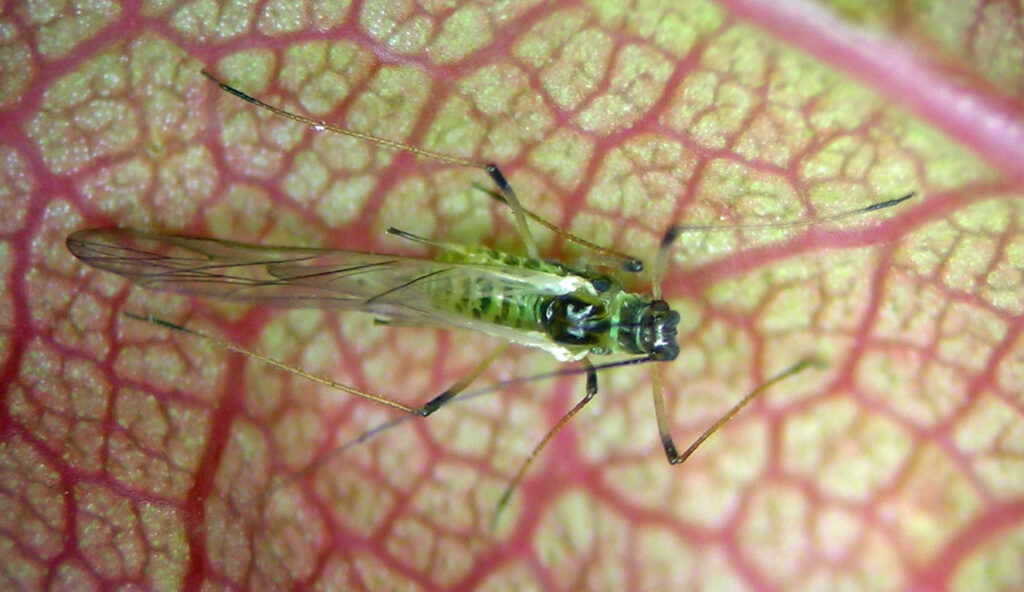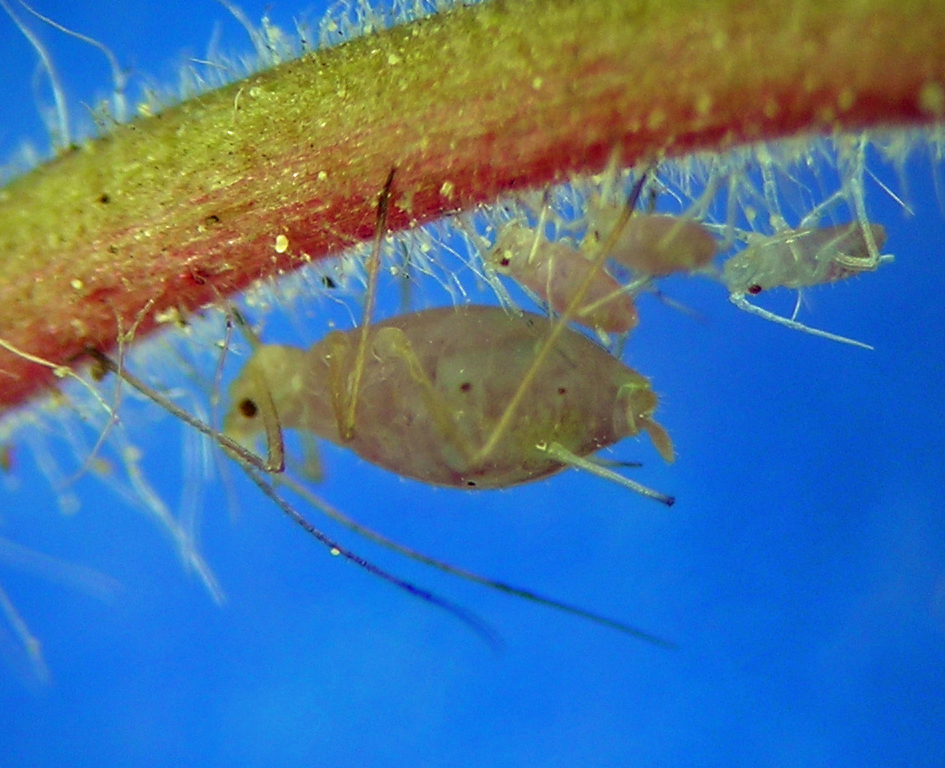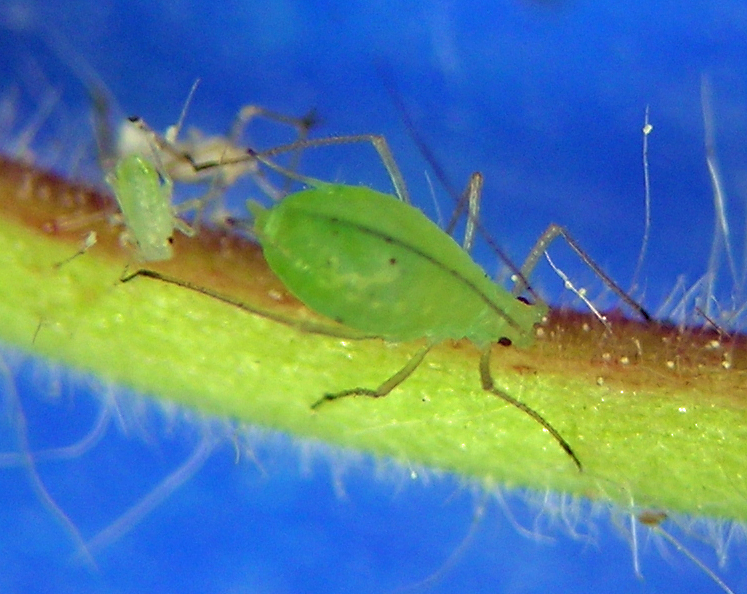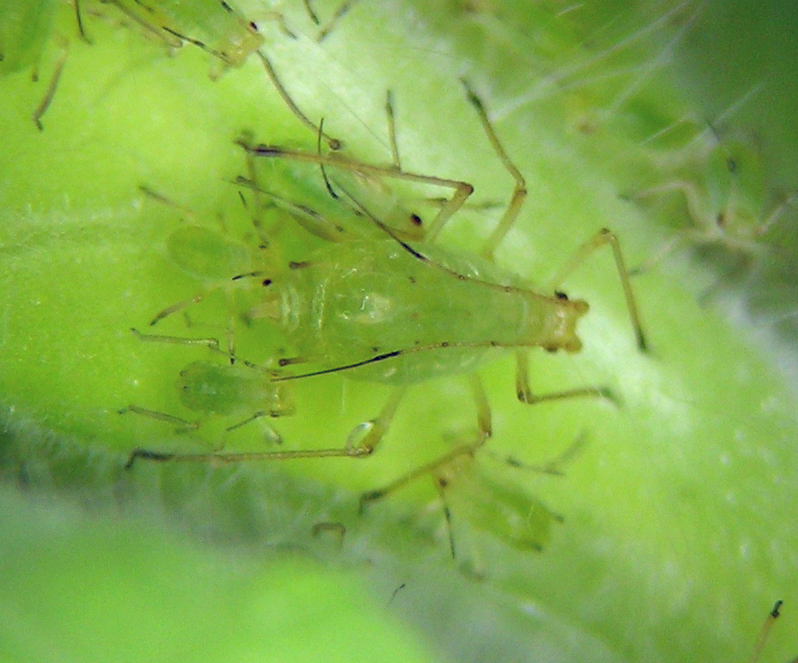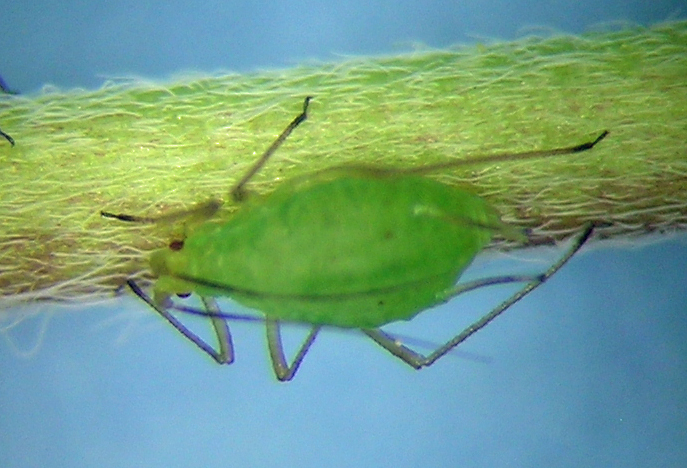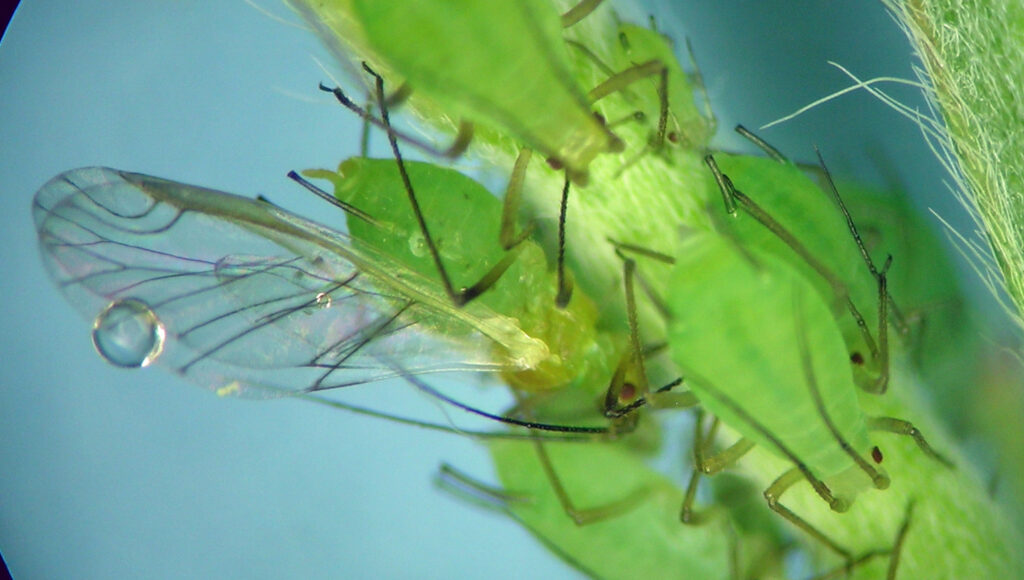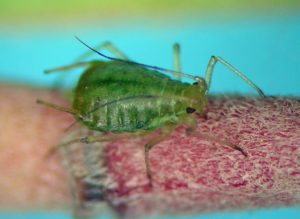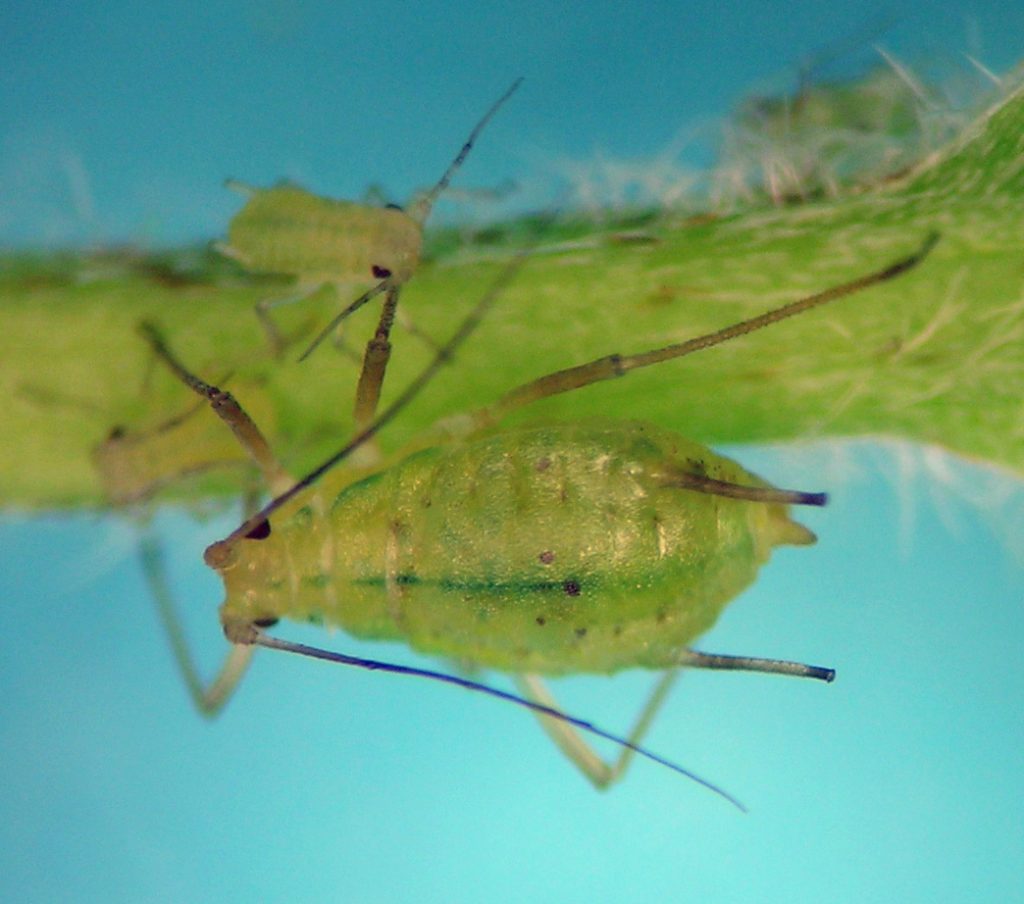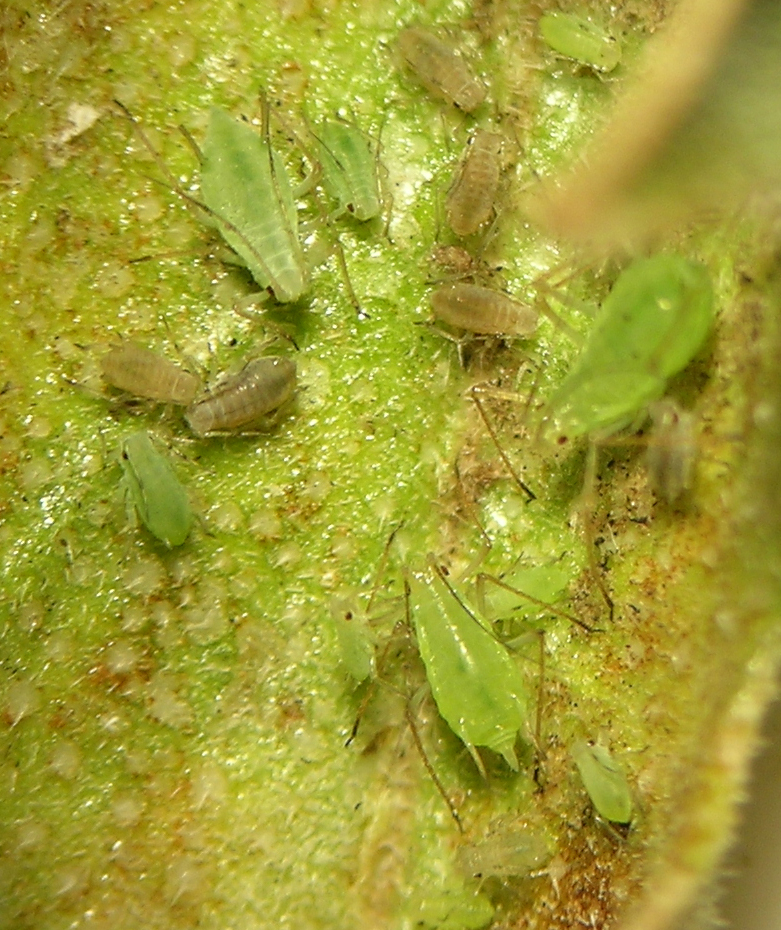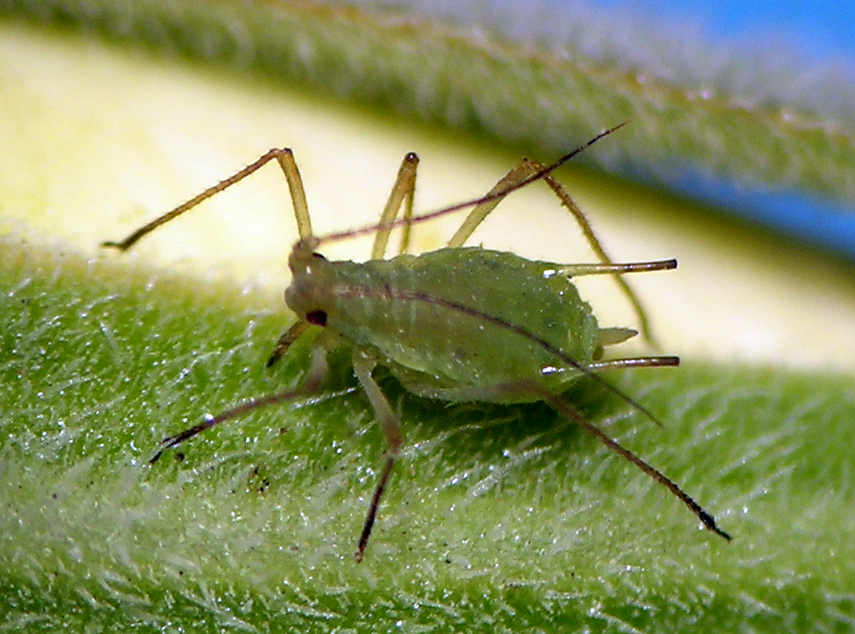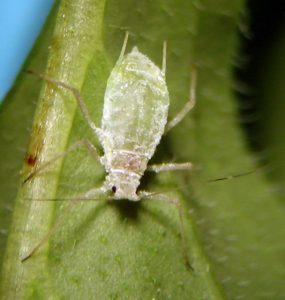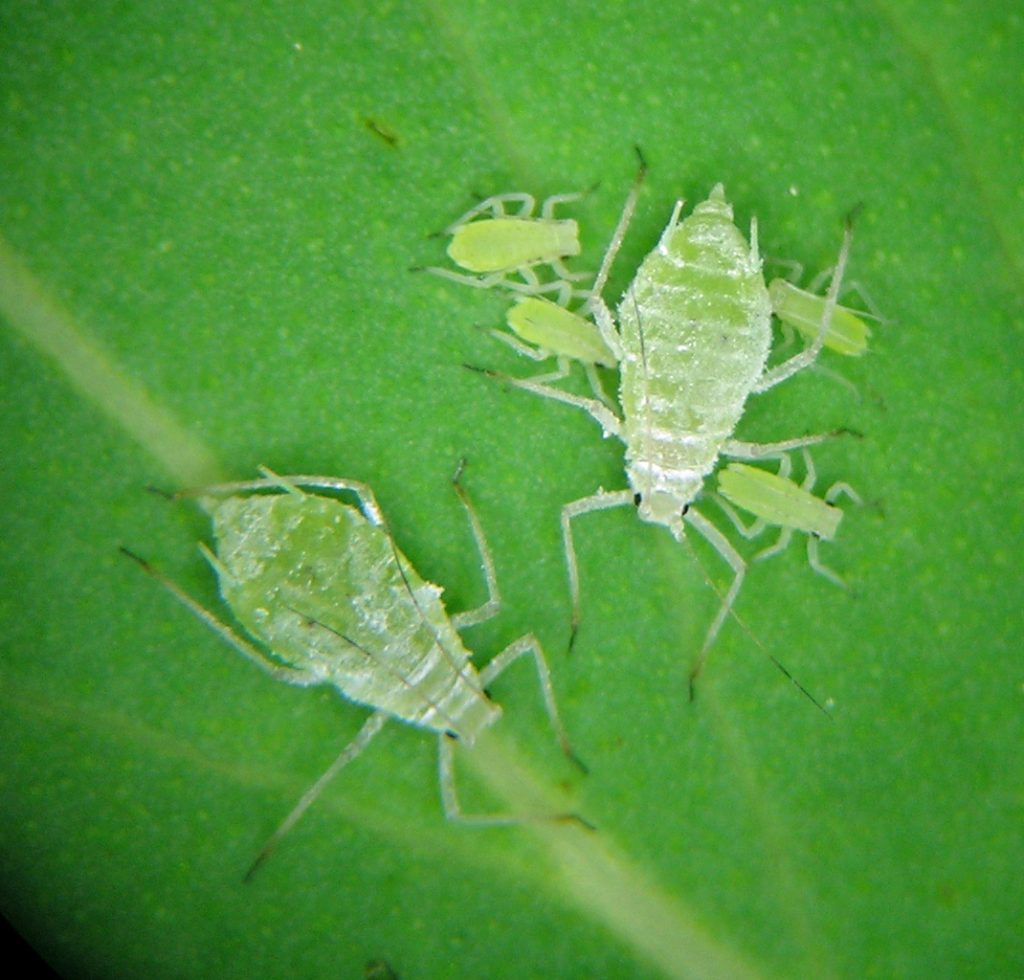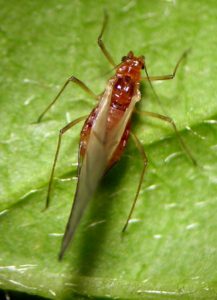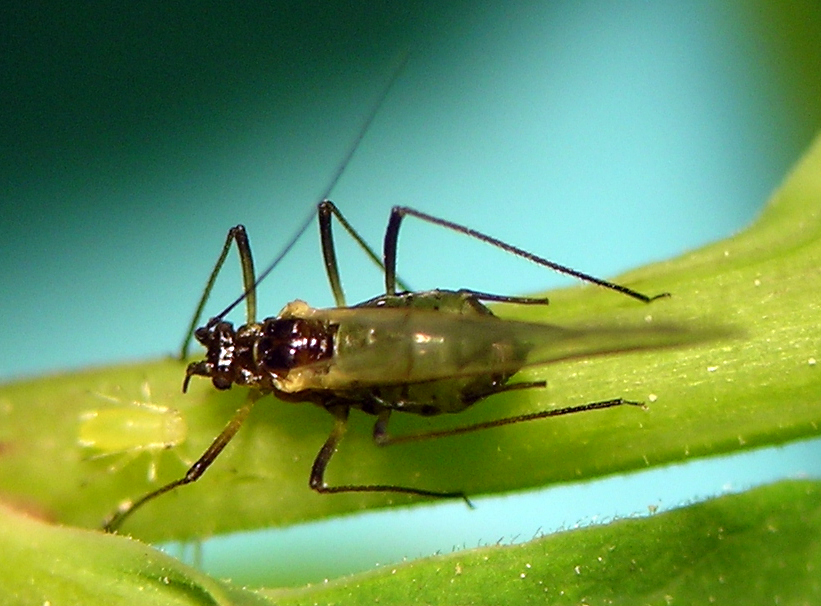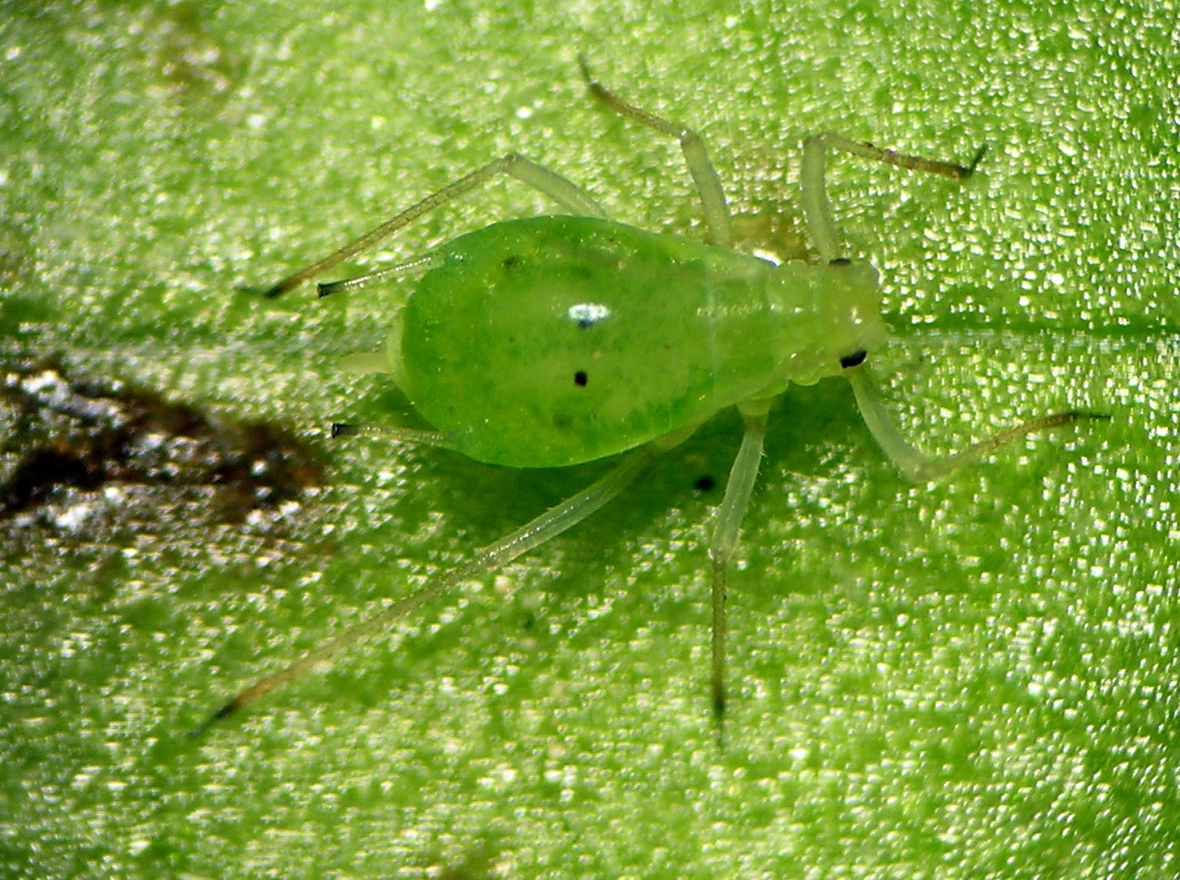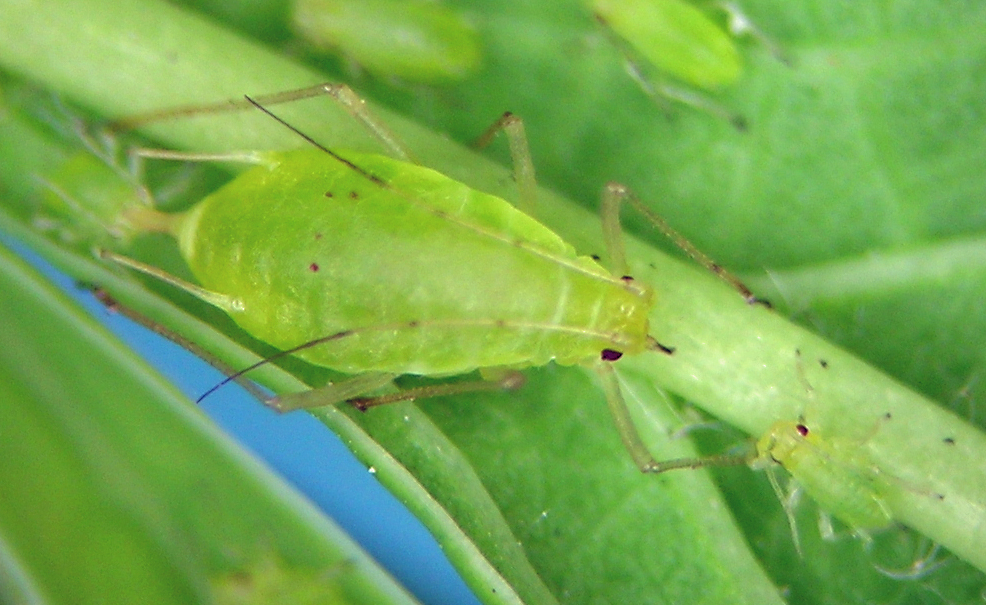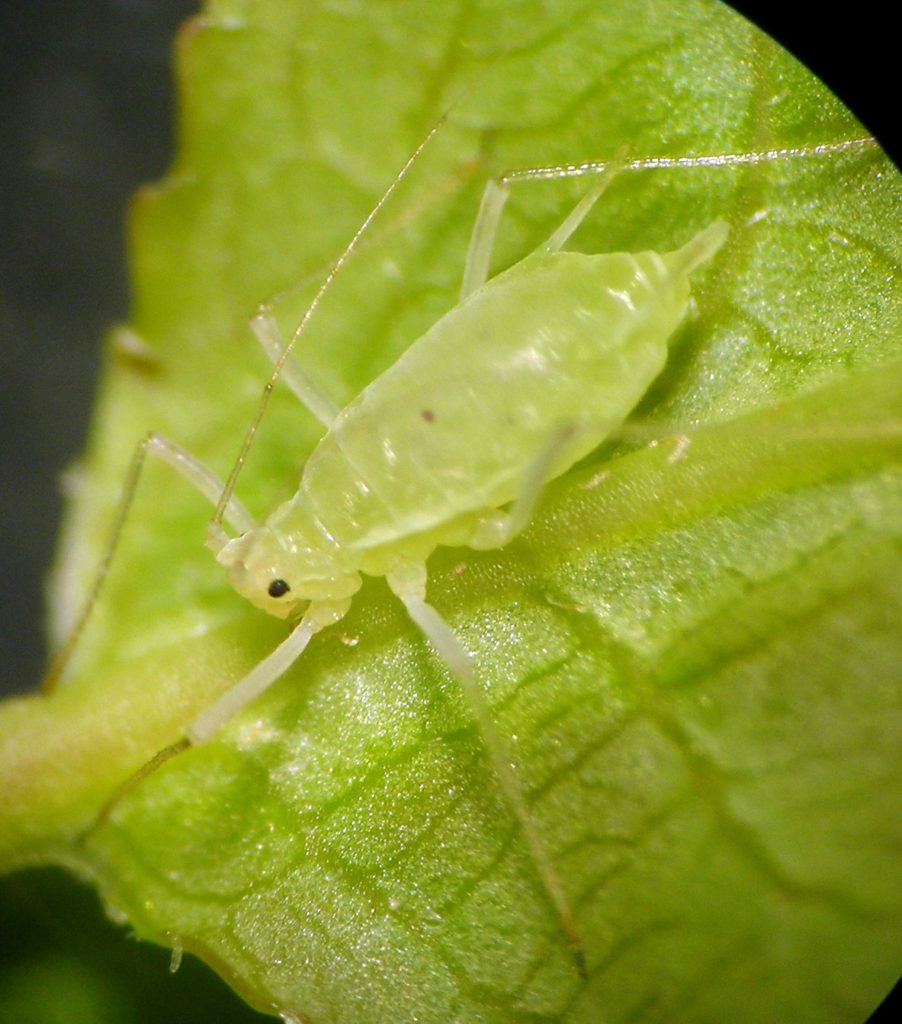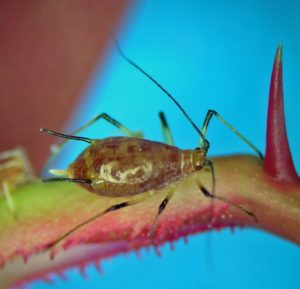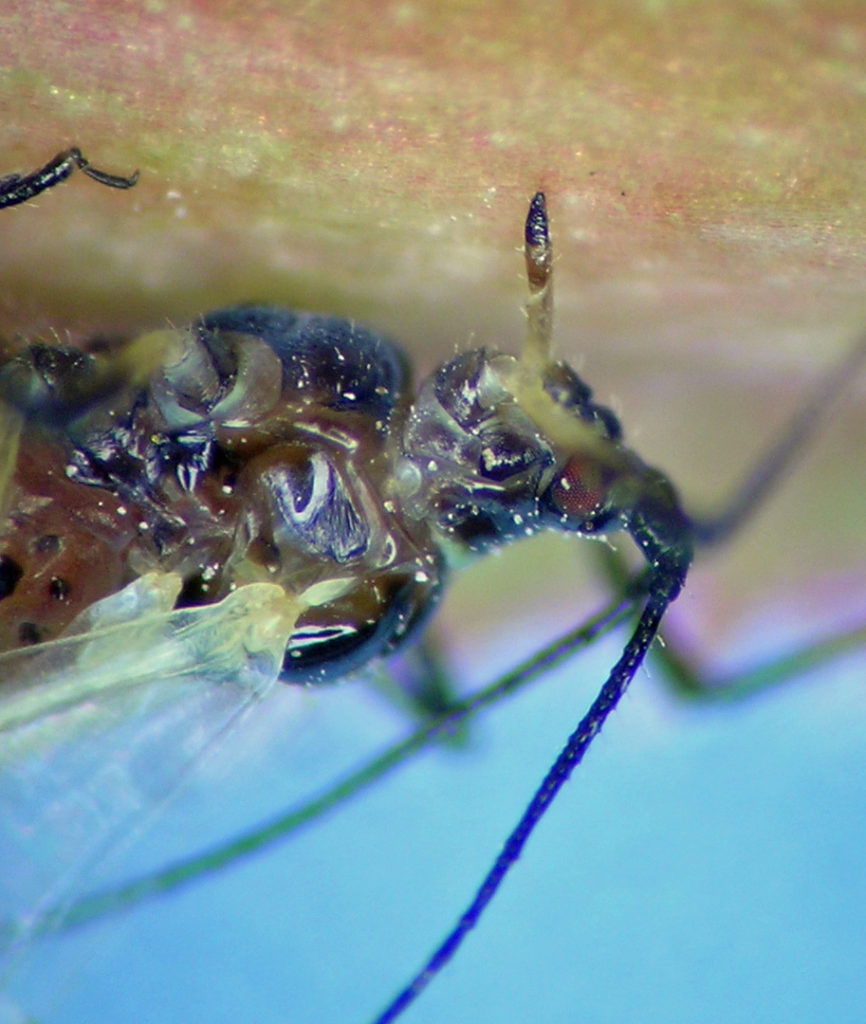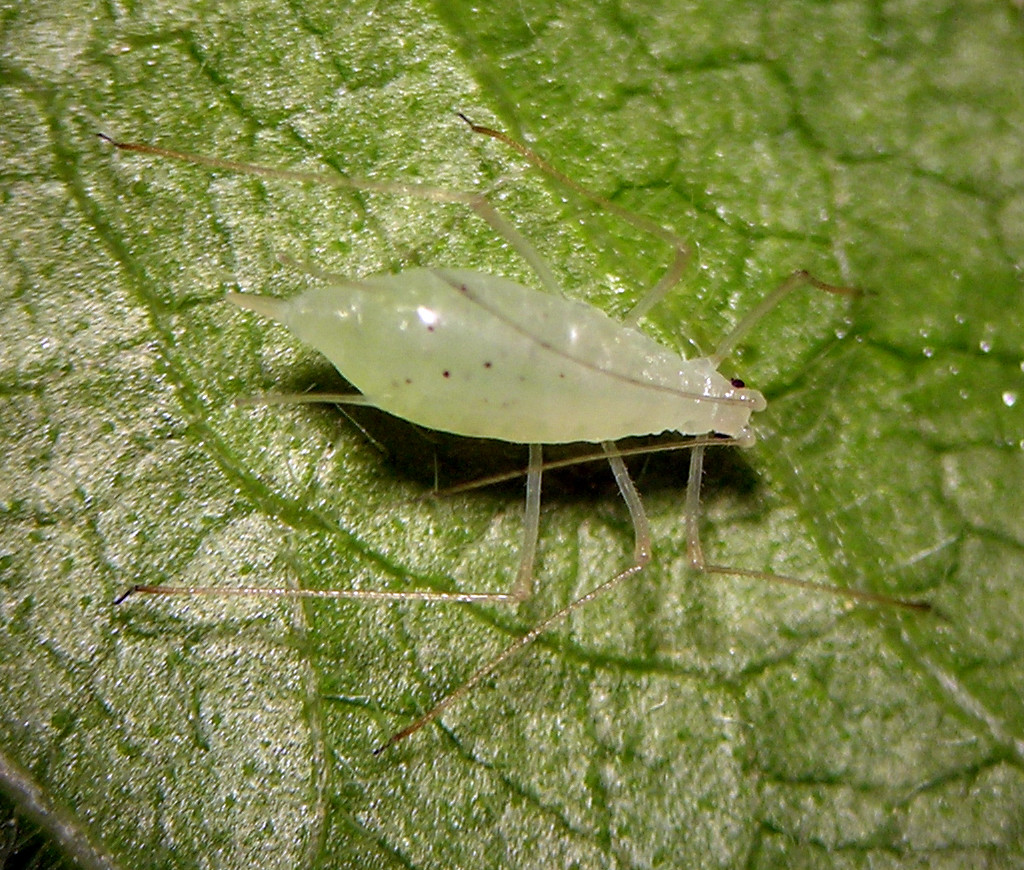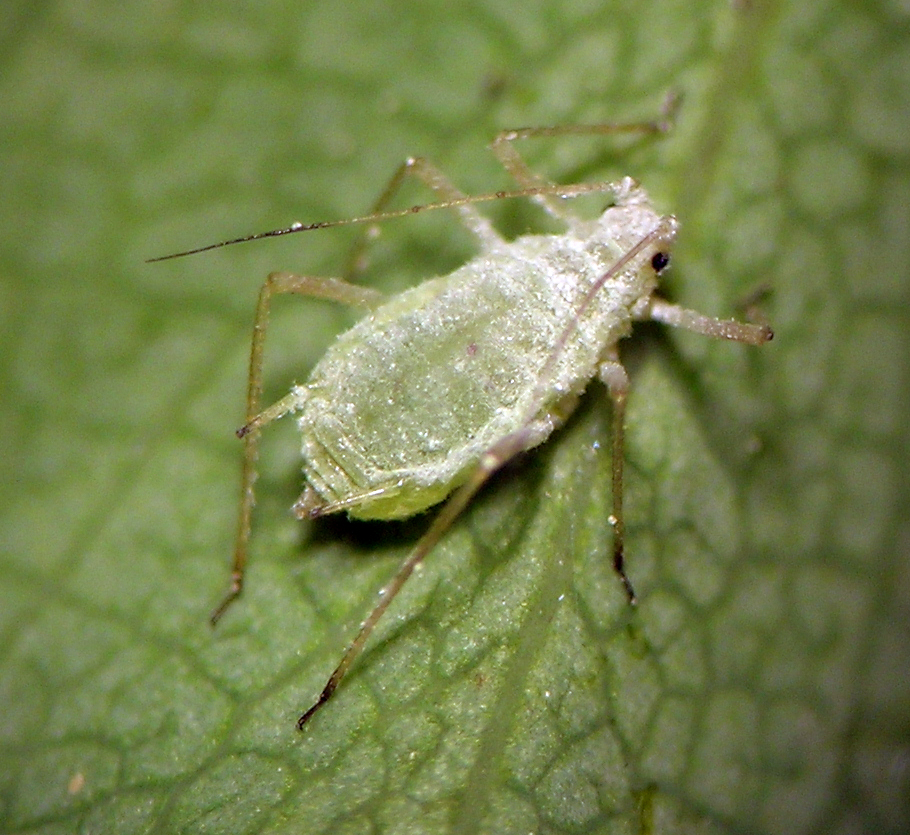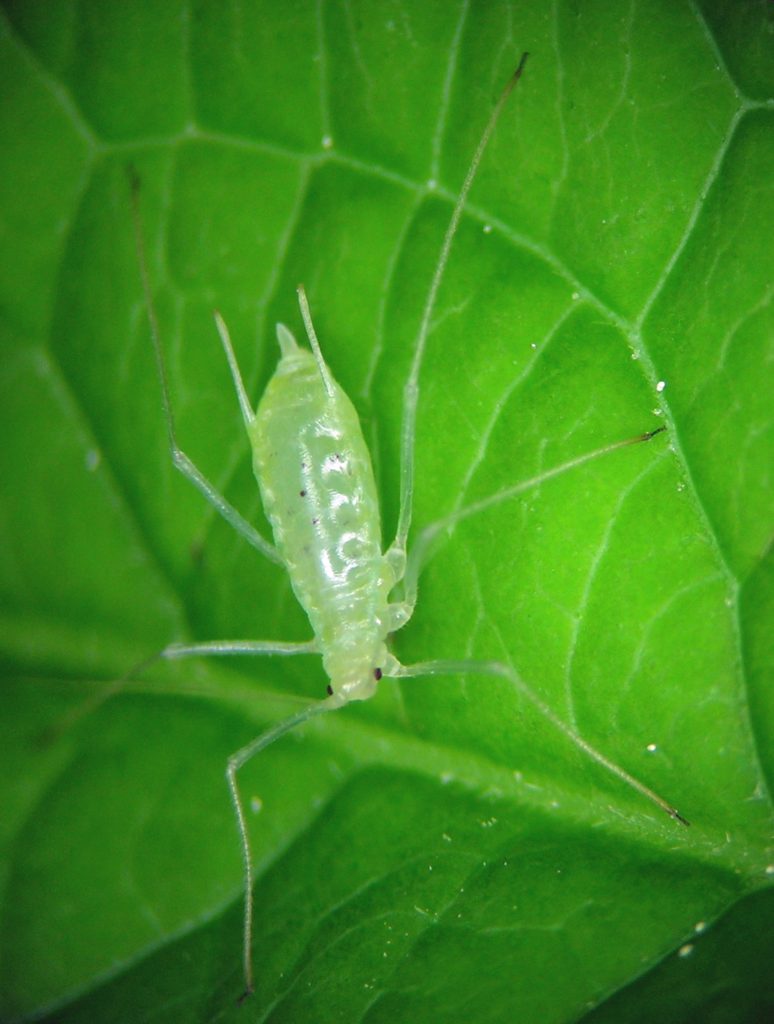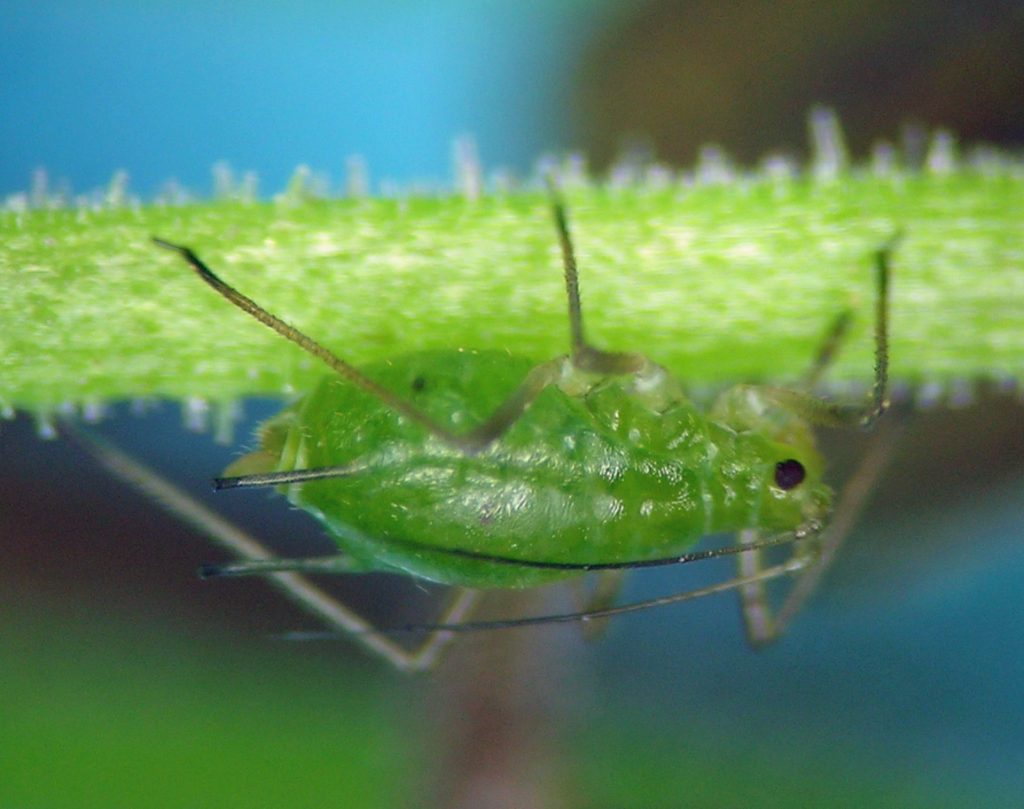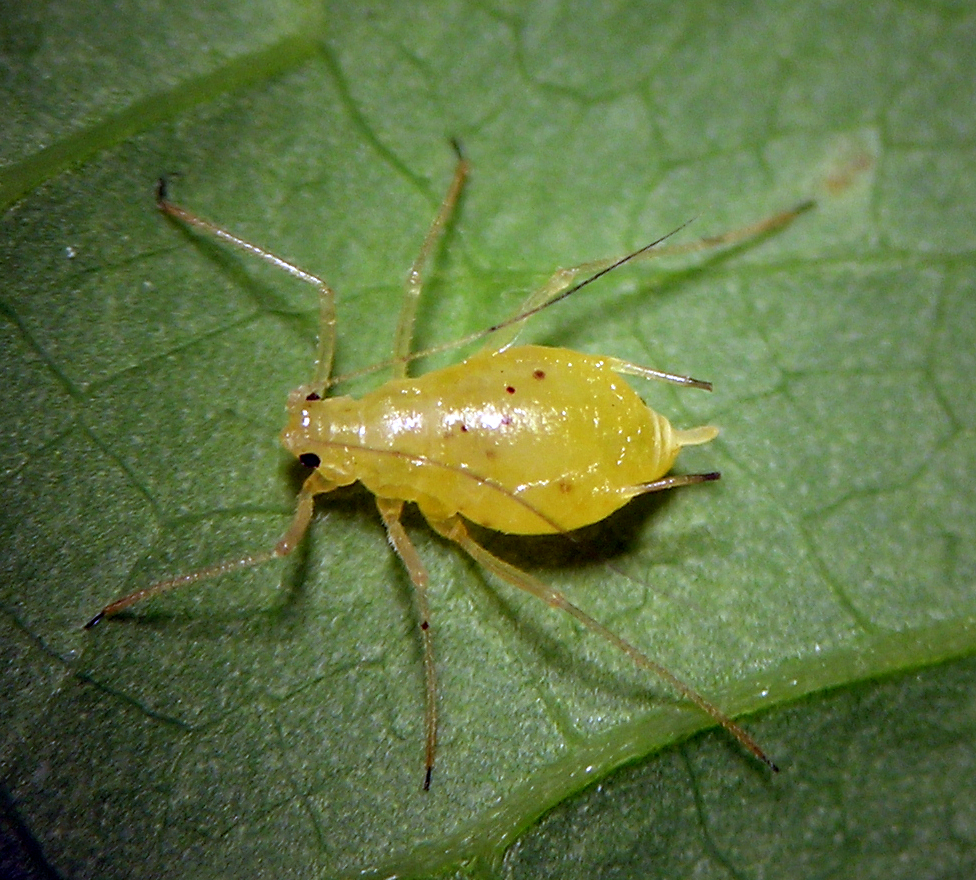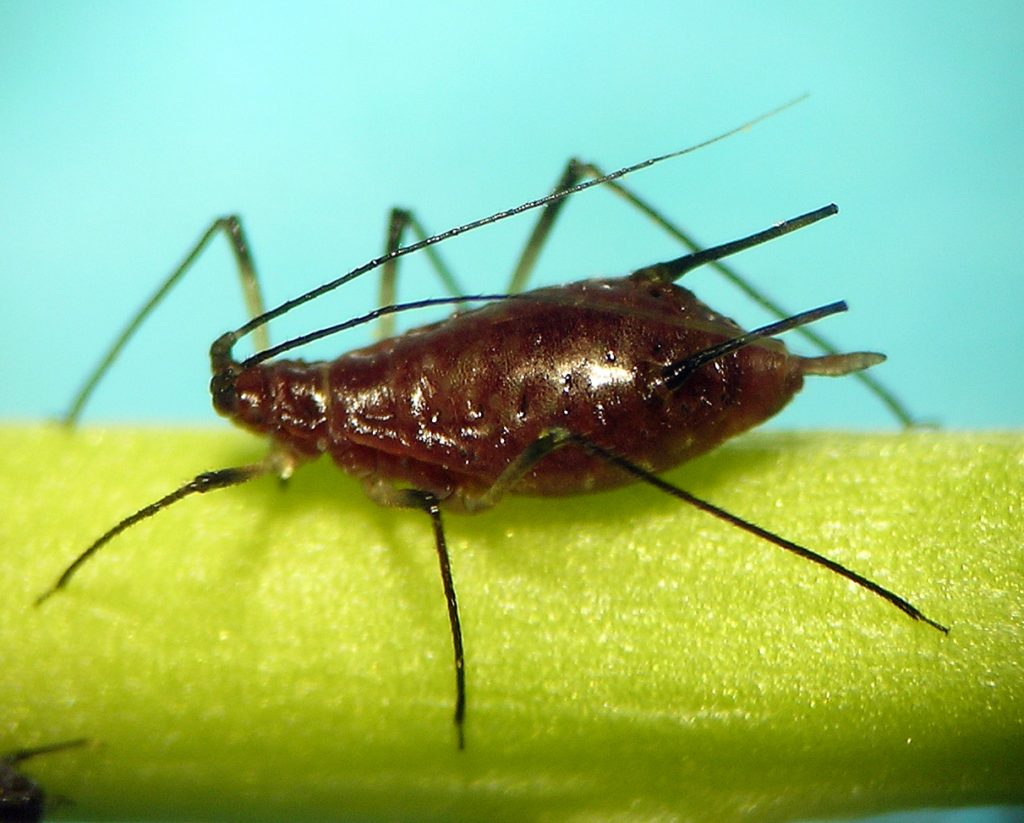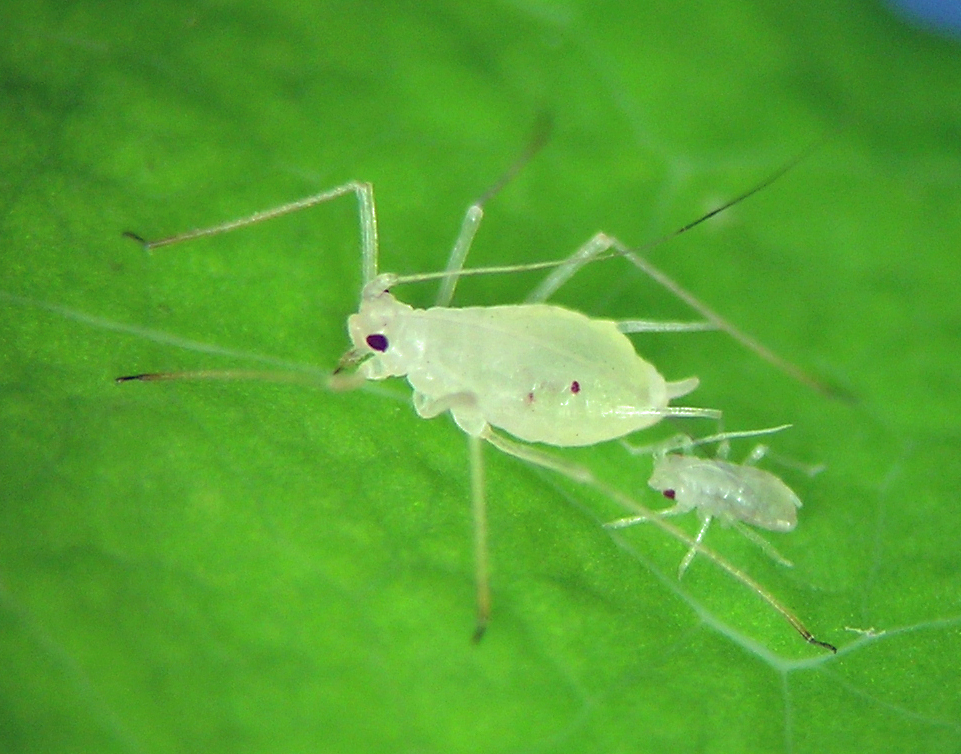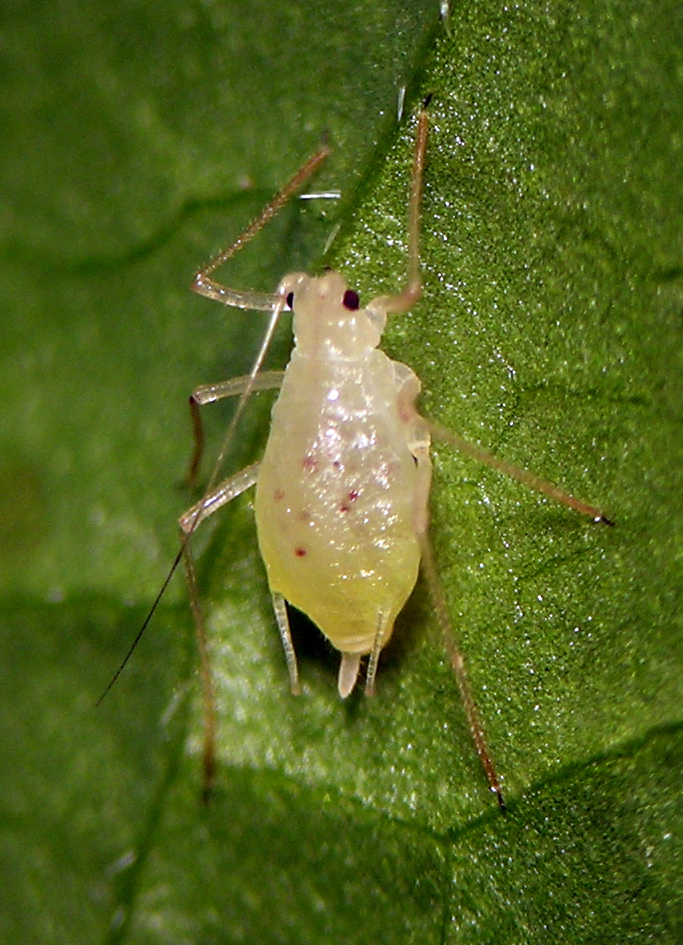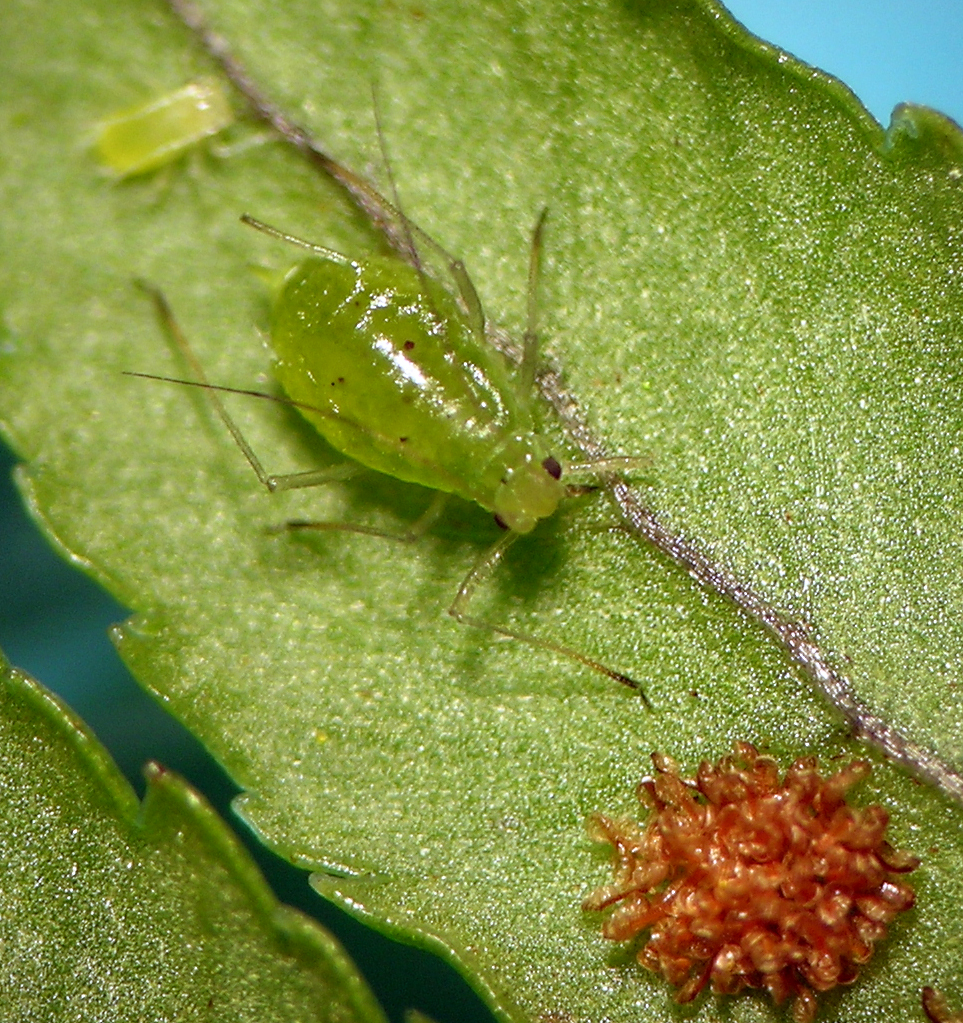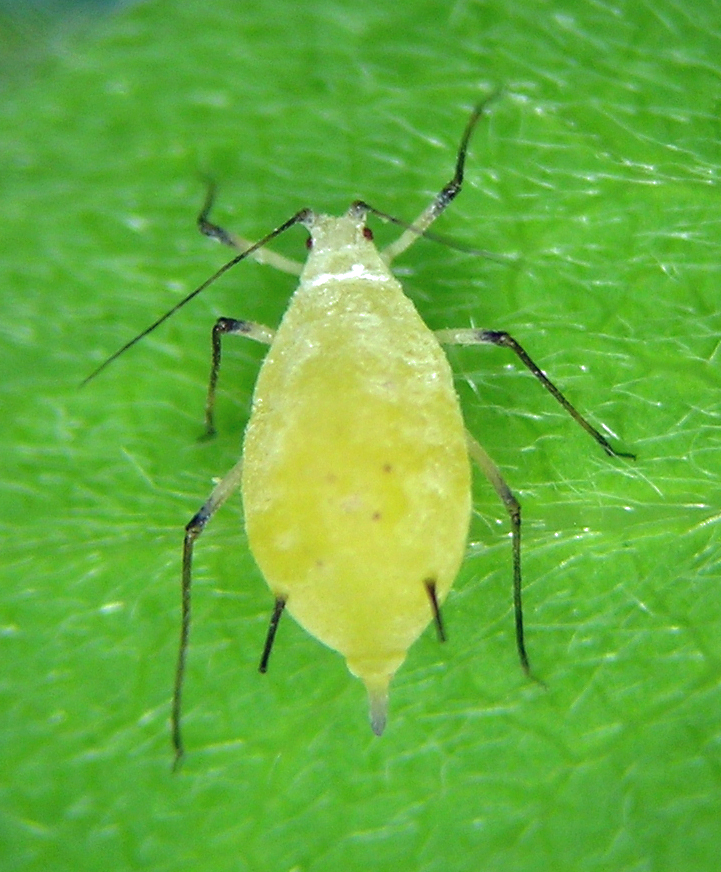Macrosiphum Passerini
This page updated: February 2025.
Macrosiphum is my favorite aphid group, getting my start on its diversity and field biology way back in undergraduate years with exploration of the first host alternation of a fern-feeding species. In those days Sitobion was still used for some of the species now considered Macrosiphum; this brings up the point that the name Macrosiphum is now used for what is likely a polyphyletic assemblage of species. Some day it might turn out to be better thought of as 2, 3, or more genera.
Jensen, A.S., J.D. Lattin and G.L. Reed. 1993. Host plant alternation in two fern-feeding Sitobion Mordvilko. in: Critical Issues in Aphid Biology: Proceedings of the 4th International Symposium on Aphids. P. Kindlmann and A.F.G. Dixon, eds. 142 pp.
Since then I finished a Ph.D. studying this group, and published 20 new species (so far, more to come). My impression of this group is that there has been recent and rapid diversification, especially so in western North America. There are many tightly host-specific species that are morphologically similar. But you should be able to see from the coverage of species here on AphidTrek that Macrosiphum species come in many beautiful colors and live in some fabulous ecosystems.
Jensen, A.S. 2022. A new species of Macrosiphum (Hemiptera: Aphididae) living on Silene (Caryophyllaceae). Zootaxa, 5183 (1): 75–89.
Jensen, A.S. and J. Rorabaugh. 2020. New Macrosiphum Passerini (Hemiptera: Aphididae) Information from Western North America Including One New Species and One New Synonymy. Proceedings of the Entomological Society of Washington 122: 81-103.
Jensen, A.S., R. Peña-Martinez, A.L. Muñoz-Viveros, and J. Rorabaugh. 2019. A New Species of Macrosiphum Passerini (Hemiptera: Aphididae) from Mexico on the Introduced Plant Pittosporum undulatum. Proceedings of the Entomological Society of Washington 121: 39-53.
Jensen, A.S. 2017. Two New Species of Macrosiphum Passerini (Hemiptera: Aphididae) from Dry Forests of Western United States. Proceedings of the Entomological Society of Washington 119: 580-600.
Jensen, A.S. 2015. Two New Species of Macrosiphum Passerini (Hemiptera: Aphididae) From Western North America. Proceedings of the Entomological Society of Washington 117: 481-494.
Jensen, A.S. 2012. Macrosiphum (Hemiptera: Aphididae) Update: One New Species, One Synonymy, and Life Cycle Notes. Proceedings of the Entomological Society of Washington 114: 205-216.
Jensen, A.S. and C.K. Chan. 2009. Macrosiphum living on Fumariaceae in northwestern North America, including one new species (Hemiptera: Aphididae). Proceedings of the Entomological Society of Washington 111: 617‑626.
Jensen, A.S. and J. Holman. 2000. Macrosiphum on ferns: taxonomy, biology and evolution, including the description of three new species (Hemiptera: Aphididae). Systematic Entomology 25: 339-372.
Jensen, A.S. 2000. Eight new species of Macrosiphum Passerini from western North America, with notes on four other poorly known species (Hemiptera: Aphididae). Proceedings of the Entomological Society of Washington 102: 427-472.
Species covered below (click on the name to jump to that species):
In January of 2025 I was considering what additions and amendments to do next on aphidtrek.org. At the time I had already covered 39 species in the page below and I thought it would be interesting to add all the other species in my collection, whether I have photos or not, to add some taxonomic comments here and there, and to think about what else might be useful or interesting to extract from my brain and put “on paper.” According Aphid Species File there are 162 valid, recognized species of Macrosiphum. Let’s see how many of those I have in my little personal collection (click on the name to jump to that species)!
- Macrosiphum adianti (Oestlund)
- Macrosiphum aetheocornum Smith & Knowlton
- Macrosiphum agrimoniellum (Cockerell)
- Macrosiphum albifrons Essig
- Macrosiphum badium Jensen
- Macrosiphum californicum (Clarke)
- Macrosiphum cholodkovskyi (Mordvilko)
- Macrosiphum claytoniae Jensen
- Macrosiphum clum Jensen
- Macrosiphum clydesmithi Robinson
- Macrosiphum corydalis (Oestlund)
- Macrosiphum creelii (Davis)
- Macrosiphum cyatheae (Holman)
- Macrosiphum daphnidis Börner
- Macrosiphum dewsler Jensen
- Macrosiphum dicentrae Jensen & Chan
- Macrosiphum diervillae Patch
- Macrosiphum dryopteridis (Holman)
- Macrosiphum equiseti (Holman)
- Macrosiphum euphorbiae (Thomas)
- Macrosiphum euphorbiellum Theobald
- Macrosiphum funestum (Macchiati)
- Macrosiphum garyreed Jensen
- Macrosiphum gaurae (Williams)
- Macrosiphum gei (Koch)
- Macrosiphum ginajo Jensen
- Macrosiphum glawatz Jensen
- Macrosiphum hartigi Hille Ris Lambers
- Macrosiphum hellebori Theobald and Walton
- Macrosiphum holodisci Jensen
- Macrosiphum impatientis (Williams)
- Macrosiphum knautiae Holman
- Macrosiphum lambi Robinson
- Macrosiphum longirostratum Jensen & Holman
- Macrosiphum manitobense Robinson
- Macrosiphum melampyri Mordvilko
- Macrosiphum mentzeliae Wilson
- Macrosiphum mertensiae Gillette & Palmer
- Macrosiphum miho Jensen & Holman
- Macrosiphum niwanistum (Hottes)
- Macrosiphum occidentale (Essig)
- Macrosiphum olmsteadi Robinson
- Macrosiphum opportunisticum Jensen
- Macrosiphum oredonense Remaudière
- Macrosiphum oregonense Jensen
- Macrosiphum osmaroniae (Wilson)
- Macrosiphum pallens Hottes & Frison
- Macrosiphum pallidum Patch
- Macrosiphum parvifolii Richards
- Macrosiphum potentillae (Oestlund)
- Macrosiphum prenanthidis Börner
- Macrosiphum (Neocorylobium) pseudocoryli Patch
- Macrosiphum ptericolens Patch
- Macrosiphum pteridis (Wilson)
- Macrosiphum rebecae Jensen & Holman
- Macrosiphum rhamni (Clarke)
- Macrosiphum rosae (L.)
- Macrosiphum rudbeckiarum (Cockerell)
- Macrosiphum salviae Bartholomew
- Macrosiphum schimmelum Jensen
- Macrosiphum stanleyi (Wilson)
- Macrosiphum stellariae Theobald
- Macrosiphum tenuicauda Bartholomew
- Macrosiphum thermopsaphis Knowlton
- Macrosiphum tolmiea (Essig)
- Macrosiphum tonantzin Peña-Martinez, Muñoz-Viveros, & Jensen
- Macrosiphum tuberculaceps (Essig)
- Macrosiphum valerianae (Clarke)
- Macrosiphum vancouveriae Jensen
- Macrosiphum venaefuscae Davis
- Macrosiphum violae Jensen
- Macrosiphum walkeri Robinson
- Macrosiphum willamettense Jensen
- Macrosiphum wilsoni Jensen
- Macrosiphum woodsiae Robinson
- Macrosiphum zionense Knowlton
Well, that was fun! Seventy six of 162 species isn’t bad for a self-funded hobbyist’s collection. I thought I’d continue this listing process with a few comments on the North American ‘species’ I have not yet found. At the very bottom of this page I cover the forms I know of that are probably undescribed species. Click here to jump to that list.
Macrosiphum amelanchiericolens Patch
This name was created by Patch in 1919 for a form she found on Amelanchier spicata in Maine. Her description was based on one, possibly more, alate vivipara. About the only distinctive features she mentions in the very brief description is that the cauda is “comparatively short and rugged” and that the ANT III has “about 40 sensoria.” These facts suggest to me that she was indeed looking at something other than M. euphorbiae, but it is hard to guess what it might be. MacGillivray (1968) reported that Patch had discarded many of her slides that she thought worthless, including the type of this species. Therefore, we are left without an ability to recognize this species and nothing like it has apparently been collected on Amelanchier since 1914.
Macrosiphum audeni Macdougall
This form was described in 1926 based on material on the aquatic plant Nuphar polysepala (a.k.a., lily pad) from two sites in British Columbia, Canada. The description is wholly inadequate to recognize the species. I have searched Nuphar every chance I’ve had for decades without finding any aphids other than Rhopalosiphum nymphaeae. It may be a northern species, and it may require a canoe or a swimming suit to find. I made the following note to myself several years ago: “Extensive interaction with the CNC and Cho-Kai Chan (retired, of UBC, Vancouver) about the whereabouts of MacDougall types throughout 2008 and 2009 indicates that perhaps all her Macrosiphum types are lost.” This is a shame, if true.
Macrosiphum bisensoriatum Macdougall
Another poorly described species from 1926, this species is also not recognizable based on the description, and with the likely loss of MacDougall’s types, we may never know what this species is. I have collected avidly on all Ribes species for decades without finding any Macrosiphum specimens.
Macrosiphum (Neocorylobium) carpinicolens Patch
Here is a species, unlike the previous three, that is fairly well-known and moderately easy to find on its host Carpinus (hornbeam) in eastern North America. I was lucky enough to collect it several times while a postdoc at the U.S. national insect collection in Maryland. Alas, I did not grab any for my personal collection before leaving Maryland in 1999.
Macrosiphum constrictum Patch
This is a species I pondered quite a lot when in graduate school. It was collected on St Paul Island in the Bering Sea in 1913, using a species of Pedicularis as host. It has reduced reticulation on the siphunculi compared to many Macrosiphum, and is probably a good species. Alas, many years of collecting on Pedicularis everywhere I go has not turned up this aphid, and I have unfortunately never gotten the chance to go collecting in the Bering Sea.
Macrosiphum corallorhizae Cockerell
This is a name coined by Cockerell in 1903 for Macrosiphum aphids found feeding on the myco-heterotrophic orchid Corallorhiza maculata in New Mexico. As typical in those days, the description is inadequate for species recognition. I have seen two samples of Macrosiphum aphids on Corallorhiza over the years, and to me they look like large M. euphorbiae. Further, I think it highly unlikely that there would be a host-specific aphid on an ephemeral myco-heterotrophic plant. Finding thriving populations of M. euphorbiae on such a plant, however, would not surprise me at all.
Macrosiphum (Neocorylobium) coryli Davis
This species is known to feed on Corylus across much of northern North America. Despite collecting on Corylus anywhere I find it, I have never found this species. Like a few other species, I think I might have more luck finding it if I spent a good chunk of collecting time in Canada or across the U.S. near the Canadian border; I’ve noticed over the years that aphids and plants seem to recognize the international boundary, becoming noticeably different almost immediately after crossing the border.
Macrosiphum echinocysti Bartholomew
This form was described in 1932 based on a single very large sample collected on Echinocystis lobata (a.k.a., wild cucumber) in San Francisco, California. The description and figures are inadequate to recognize this form, and it has apparently not been collected since the description. When I visited the bay area in the 2000s I saw this plant growing in yards and along streets in the Berkeley area, and could not find any aphids. Bartholomew similarly noted that after that first collection he was unable to find this aphid in subsequent years. I suspect his form was an unusual host and appearance of M. euphorbiae.
Macrosiphum floridae (Ashmead)
This name was coined in 1882 for some aphids found in Florida feeding on Rosa. Apparently the types are either lost or were never designated, and the description is very poor by modern standards. Despite the intense insect monitoring characteristic of the Florida state government, no unusual rose-feeding Macrosiphum species has ever since been collected there. I suspect this aphid may have been a Wahlgreniella or perhaps a Rhodobium. Resolving the status of this name will probably require consultation of the dreaded International Code of Zoological Nomenclature to figure what can be done with what is probably a name without a species.
Macrosiphum fuscicornis Macdougall
From her description I am leaning toward this species being valid. The apparent loss of all Macdougall Macrosiphum types (see above) is of course not helpful. The fact it was recorded as a dark green color with relatively dark appendages would seem to rule out two common species, M. valerianae and M. euphorbiae. Macdougall mentions that alatae are uncommon, appearing in June and August, which is consistent with a heteroecious species. So, might there be a heteroecious species up in Canada that fits what Macdougall saw 100 years ago?
Macrosiphum geranii (Oestlund)
Despite many years of study and collecting I am still not sure what this name applies to. I see quite a diversity of Macrosiphum living on Geranium in North America. In my own collection I have samples sorted into 4 groups: those easily identified as M. aetheocornum, a group of specimens that look like M. euphorbiae that are trying to look just a little wrong, some that look like M. aetheocornum with relatively sparse setae, and a fourth with long thin siphunculi, a fat cauda, and abundant spinules ventrally on the head. I suspect that Oestlund’s species is not among these, but I am not sure I can recognize what he had if I see it. Many years ago when studying at the U.S. national aphid collection (USNM) I wrote, “The material in the USNM is obviously composed of two species. There are 25 slides of a species from Manitoba and Wisconsin that has a smooth venter of the head, but a very spinulose cornicle. This species also tends to have more setae on the URS. The other species is material from PA, MD, IL, and it has more normal looking cornicles, but densely spinulose ventral surface of head. This one also has URS with 6 accessory setae. One specimen from Manitoba appears to be M. euphorbiae, while the specimen from Sask. is a nymph.” So it seems likely that there are 2 to 4 species currently being confused under this name. The identity of this species might best be resolved by collecting on wild Geranium in and near Minneapolis, which is where Oestlund was working and collecting in the 1880s.
Macrosiphum hamiltoni Robinson
A.G. Robinson described this species from Humulus (cultivated hops) in 1968 (I was fortunate enough to learn much from Grant during our correspondence via paper letter and email during the 1990s). It is surprising to find a new Macrosiphum species living on a cultivated non-native crop plant. When studying material in the USNM I wrote, “I think Eastop is wrong in calling this species the same as the one on Cornus. This is closer to Illinoia than that Macrosiphum species, based on several paratypes and other material. No alates in the collection. The head is pale, the antennae with banded joints. Is this one related to M. olmsteadi?” So anyhow, I think this is a good species with a very mysterious biology deserving further study in the Winnipeg area (Manitoba, Canada).
Macrosiphum jasmini (Clarke)
The aphids Clarke based his description on were collected in Berkeley, California around 1902 living on Jasminum, a non-native ornamental plant. His description is very brief and inadequate. While visiting the University of California insect collection in Berkeley some years ago i wrote, “Types are probably lost. The slide at Berkeley labeled as type is obviously a mis-labeled sample from another collection in Clarke (1903); the specimens were Hyperomyzus. Hence, types must actually be lost.” During this trip I spent an afternoon walking all over Berkeley and the university campus looking for this and a few other species originally collected there. Although I did find some Jasminum, I found no aphids feeding on it. I suspect the aphids Clarke studied were M. euphorbiae.
Macrosiphum lilii (Monell)
This species has been collected in several states of eastern U.S. I had the chance to look at this material when studying at the USNM. I wrote about it, “This species has dark tips of femora, bases and apices of tibiae, and antennae usually dark, with middle part of III normally lighter. Based on many specimens from the eastern U.S. This is possibly an Asian species, and relationship to Japanese and Chinese species should be explored. May also be native to eastern North America?” While living in Maryland for 3 years I avidly searched for this species without success.
Macrosiphum orthocarpus Davidson
This form was found living on Castilleja exserta (recorded as Orthocarpus, owl clover) near Stanford University in California during the few years before 1909. This plant is a hemiparastic annual, so I strenuously doubt that an aphid would be monoecious on it. Davidson’s description is very brief. Considering these facts plus the commonness of M. euphorbiae on Castelleja, and my examination of the type material in the USNM (2 alate viviparae) I suspect that what Davidson had was M. euphorbiae.
Macrosiphum pechumani MacGillivray
This distinctive species lives on large lily-like plants such as Maianthemum racemosum in eastern North America. I was not able to find it in my handful of collecting trips in the region, but I have studied specimens in the USNM and it is clearly distinct and interesting.
Macrosiphum pyrifoliae Macdougall
Another of Macdougall’s species the types of which are apparently lost, this one was described from Sorbus sitchensis (then recorded as Pyrus occidentalis). Other specimens have apparently been collected near the type locality, and were said to be very similar to M. euphorbiae. Whether this is a good species cannot be known for sure at present. Further study in the field in British Columbia would probably help (despite decades of looking for aphids on Sorbus, I have never found a Macrosiphum).
Macrosiphum raysmithi Hille Ris Lambers
This species has, like several others in this list, received a lot of collecting effort over the past 3 decades, so far without luck. Originally collected on Lonicera involucrata var. ledebourii in Berkeley, California, it is distinctive among, but clearly part of, the group of Macrosiphum species that live on Caprifoliaceae around the Northern Hemisphere. During my trip to Berkeley in 2014 I explored every nook and cranny of the university campus looking for Lonicera shrubs that might host this species. I think I ended up finding a plant or two, but not this aphid.
Macrosiphum tiliae (Monell)
This is another story of a failed collecting expedition. I have been intrigued by this distinctive tree-feeding aphid for decades, and in 2017 we planned a trip to the Midwest (especially Wisconsin and Minnesota) in May to visit family and collect aphids. The key collecting targets of this trip were a few Macrosiphum species including M. tiliae. Alas, that particular year featured a late spring, so we were 2 or 3 weeks early to see spring generations of tree-feeding aphids and I was not able to find M. tiliae.
Macrosiphum timpanogos Knowlton
This name was coined by George Knowlton in 1942 based on a single sample of an unreported number of apterous viviparae collected on Mt. Timpanogos in Utah on 23 July 1940. The host plant was not known, but Knowlton wrote, “Host? (probably from a lupine of some kind).” He may have deduced this because the aphid is very similar to the common lupine-feeding aphid Macrosiphum albifrons. I saw the type slide in the USNM and wrote about it, “This appears to be another synonym of M. albifrons, or at least closely related. The type slide is two specimens that are badly over-cleared.” As noted far below, I have concluded that the species Macrosiphum thermopsaphis may be valid despite decades of it being treated as a synonym of Macrosiphum zionense, and in the same way it is possible that Knowlton’s material represents a separate lupine-feeding species. Probably the only way to learn more is extensive field work in the area of Mt. Timpanogos. I have collected typical-looking M. albifrons from that part of Utah, but have never seen anything that I would consider unusual or would fit what Knowlton wrote about M. timpanogos.
Macrosiphum (Neocorylobium) vandenboschi (Hille Ris Lambers)
This is another apparently distinctive Corylus-feeding species from California. Hille Ris Lambers described it based on 2 apterous viviparae collected in Tulare County, California on 13 July 1961. Despite 3 decades of collecting on Corylus everywhere I see it, I have not found this species. That said, I have not collected in California anywhere near enough to understand its aphid diversity.
Macrosiphum verbenae (Thomas)
This name was coined in 1878 for some aphids collected in Illinois on Verbena. Based on specimens I have seen and some collecting I have done on Verbena over the years, I am almost certain this is M. euphorbiae showing some environment-induced variation in color and general appearance, a common and easily documented phenomenon in M. euphorbiae.
OK! That was fun too! In summary, my view is that there are still 16 species I should try to find in the U.S.A. and Canada, and that 7 of the remaining names just listed are probably not valid species, being synonyms of M. euphorbiae, M. albifrons, or perhaps other genera in the case of M. floridae. Cleaning up these 7 names should perhaps be a priority if I ever get around to publishing a complete work on Macrosiphum of U.S.A. and Canada (there is no way I could cover North America as a whole without many years of access to and collecting in Mexico, the likelihood of which is approximately zero).
Macrosiphum adianti (Oestlund)
In the late 1990s I had the great honor to collaborate with the late Jaroslav Holman on a paper that covered the fern-feeding Macrosiphum of the world. He had material from Europe, Mexico, and the Caribbean, and I had material from the U.S.A. and Canada. This collaboration was carried out entirely via email and old-fashioned paper mail, sending specimens and slides through the mail. Jaroslav was generous and a great collaborator. Our paper was published in 2000, as shown in the list above. In it we covered the details about Macrosiphum adianti, including a clarification of what this species was. We wrote about it:
“Biology and distribution. Macrosiphum adianti is monoecious on Adiantum pedatum L., with apterous males. Reproduction continues throughout the summer, but adults that develop in midsummer can be as little as one mm long. The aphid is rather rare, infesting only a small percentage of A. pedatum plants in any given part of its range. It has so far been found in British Columbia, Oregon, California and Minnesota. There is extensive new material in the Oregon State University aphid collection. One parasitoid, Toxares deltiger (Haliday) (Braconidae: Aphidiinae) was reared from this species in Oregon.
Systematic position. Macrosiphum adianti can be recognized by its small size (usually about 2.0 mm), peculiar, short siphunculi with little or no reticulation (Fig. 3D) in apterous viviparae, low antennal tubercles (Fig. 3E,F), metatarsal II longer than u.r.s., and abdomen with patches or bands of pale sclerotization. It is so far the only species of Macrosiphum collected on A. pedatum in North America. The only other aphid known from this plant in North America is Papulaphis sleesmani. Macrosiphum adianti and P. sleesmani differ primarily in the tuberculate, apically placed rhinaria on antennal segments III and IV for which Papulaphis Robinson was named. Macrosiphum miho is a similar species; the differences between the two are discussed under M. miho.
Taxonomic notes. Oestlund (1886) described this species in the genus Siphonophora (= Macrosiphum) from Hennepin and Ramsey County, Minnesota, feeding on A. pedatum. This was the first species of fern-feeding Macrosiphum described from North America. Ever since its original description, there has been much confusion about the identity of this species. Oestlund’s description was short and, by modern standards, of little value in recognizing the species. Robinson (1966) reported that the types for this species could not be found in the Oestlund collection. He consequently based his concept of the species on material collected in Illinois on Aspidium. We borrowed the slides used by Robinson to construct his concept of the species, and found that the specimens disagreed with Oestlund’s description by possessing siphunculi and appendages that were much too long. Coincidentally we discovered a small yellowish Macrosiphum on A. pedatum in Oregon. Following a search in the University of Minnesota aphid collection (where the Oestlund collection is housed), P. Clausen found material of the same species, these collected by Oestlund on Vancouver Island, British Columbia in 1907. These specimens agree very well with the measurements provided by Oestlund (1886). Therefore, these specimens are here assigned to the name M. adianti. The material used by Robinson from Illinois is described below as a new species, M. miho sp.n. The location of the types of M. adianti is still unknown.”
Since that time I have collected this species once in Washington.
Macrosiphum aetheocornum Smith & Knowlton
For some years this species was a major collecting goal of mine. I collected on geraniums of all kinds for many years before finding this aphid for the first time in 2010 in New Mexico. Since then, I’ve found it many additional times, including fundatrices and sexuales, proving monoecy. I find it on what I call Geranium richardsonii, a plant that seems to have a wide variation in habitat preference and is irritatingly similar to G. viscosissimum where their ranges overlap.
In 2022 I published some information on this species as part of my work on M. ginajo. I wrote: “Biology and Distribution. Macrosiphum aetheocornum feeds on native Geranium species, the species recorded
by this author have been Geranium richardsonii Fisch & Trautv. and Geranium viscosissimum F. & M. Some collections listed above were recorded as Geranium due to the author’s limited plant taxonomy skills, but some of these were almost certainly species other than G. richardsonii and G. viscosissimum. In plants that are partially sticky–glandular, post–bloom, or that have the common intermediate pink flower color, the author struggles to confidently distinguish between the latter two species of Geranium, so not all species identifications can be relied upon.
“Macrosiphum aetheocornum has a full–season life cycle with sexuales in September. This differs from another common aphid that frequently occurs on the same host plants, Nasonovia (Capitosiphon) crenicorna Smith and Knowlton. The latter species has an abbreviated life cycle with sexuales in July and early August. The author has studied an unidentified species of Amphorophora that also has an abbreviated life cycle on especially glandular–sticky populations of G. viscosissimum; this aphid may be Amphorophora coloutensis Smith & Knowlton, which has a similarly abbreviated life cycle, but available identification keys and references are inadequate for species identification. These aphids with abbreviated life cycles often occupy stands of Geranium in dryer habitats that dry out and enter dormancy during summer. Macrosiphum aetheocornum, on the other hand, with its full–season life cycle occupies plant stands in habitats that support vegetative growth all summer and into autumn. Typical habitats
for M. aetheocornum are forested riparian zones and the understory of pine forests, but it can also be found on hot and dry slopes with spring–fed wet soils (such as the slopes above Lake Abert in Lake County, Oregon). The author has collected M. aetheocornum in Oregon, California, Montana, Idaho, Utah, New Mexico, and Colorado. It almost certainly occurs in neighboring states such as Washington, Nevada, Arizona, and Wyoming.”
Macrosiphum agrimoniellum (Cockerell)
This species was described by T.D.A. Cockerell in 1903 while he was living in East Las Vegas, New Mexico. I’ve been through the Las Vegas area a few times, and am fascinated to think what it would have looked like 120 years ago (it is nothing like Las Vegas, Nevada, in case you were wondering) and what the heck an entomologist was doing in such a tiny town. A quick look at Wikipedia shows that he was there teaching at what was then called the New Mexico Normal School, now New Mexico Highlands University.
His description was based on a single sample collected in Beulah, New Mexico on 27 July 1902 by T.D.A. and W.P. Cockerell (his wife). Interestingly, a search on Google Maps turns up no towns or places called Beulah in New Mexico. A couple web pages mention that Beulah is now a ghost town and is in San Miguel County, the same county as Las Vegas. Cockerell’s description was based on one or more alatae viviparae. He wrote:
“Winged female (full of young) — Large, light apple green (orange-ferruginous mounted in balsam), without markings; eyes black; femora with basal two-thirds light green, distal third black, or sometimes less (about 90 μ); distal 90 μ of tibiae, and all of tarsi, black; nectaries suffused with blackish; antennae dusky, joint 3 black except the basal 30 μ; third antennal joint with very numerous (about 32) protuberant sensoria, about equally distributed on the proximal and distal halves; cauda tapering, with a blunt tip, sides with bristles set on little prominences; no capitate hairs anywhere.
Length of body about 3 mm, wings about 3 ½ mm; other measurements in μ: — Antennal joints: (1.) 120, (2.) 110, (3.) 1100, (4.) 900, (5.) 730, (6a) 160, (6b.) 1230. Cauda about 450; nectaries 1000, with imbricated surface; beak 700 to 750; anterior femur 1000; marginal cell with substigmatic portion 380, and poststigmatic portion 660.”
Cockerell’s work in New Mexico has always interested me, and some of his species have been most difficult to find and identify. Re-reading this description makes me like him even more — he uses microns for measurements and also refers to the two sections of the 6th antennal segment as 6a and 6b, both practices that I have used and been criticized for. I feel vindicated. That said, we must note that this description provides very little useful information in recognizing the species. Thank goodness for the relatively unusual host plant!
You’ll notice that he uses a couple old-fashioned terms for body parts: nectary = siphunculus = cornicle; beak = rostrum; bristles = setae = hairs.
The first time I found what I think is this species was in early October of 2012 in Grant County, New Mexico, in the Gila National Forest, Railroad Canyon. I recorded the host plant as Potentilla, but at the time I had never knowingly seen Agrimonia before, so it is possible that I misidentified the plant. I see that Agrimonia striata is common in the Gila National Forest, so who knows what I was looking at. Targeting Agrimonia on our 2014 New Mexico expedition, I was able to find 2 alatae in the Lincoln National Forest near nogal Peak on 28 September. My one sample from Potentilla gracilis was from the Uncompahgre National Forest in western Colorado in July of 2022, and I am almost 100% certain about my plant identification in this case. These two specimens fit M. agromoniellum quite well except the ultimate rostral segment looks a bit longer and perhaps the hairs on it are finer.
As I wrote in my essay about Macrosiphum euphorbiae, clues that this species is not M. euphorbiae include the extra rhinaria on antennal segment III in both apterae and alatae, the usual lack of lateral tubercles at the base of siphunculi, and the slightly longer and hairier ultimate rostral segment.
Macrosiphum albifrons Essig
This aphid is one of the largest in the world, and is actually familiar to many flower gardeners: it feeds on lupins (Lupinus) and is sometimes called the ‘lupin aphid.’ It is widespread in North America and has spread elsewhere as well with its cultivated lupin hosts.
In natural systems, M. albifrons seems to be able to feed on many species of Lupinus, however, some samples seem to differ morphologically from others. I have suspected that more than one species may be involved, but have not had the time, resources, etc. to study the situation in detail.
One similar species is Macrosiphum zionense (see below), which lives on a lupin-like legume called Thermopsis in the mountains of inland western North America. M. zionense is usually yellow or orange and has dark antennae, siphunculi, and legs. Another nominal species, Macrosiphum thermopsaphis, was described from Thermopsis in Colorado back in 1938 by G.F. Knowlton. It was never recovered after the original collections and was sunk as a synonym of M. zionense in 1997.
During spring of 2024 I studied my samples identified as M. albifrons and M. zionense that were collected on Thermopsis. A key reason for this was to ascertain whether the pale green specimens I had collected over the years on Thermopsis were in fact M. albifrons as I had guessed. I was finally prompted to do this analysis by two collections in 2023 in which I found typical M. zionense with yellow/orange color and dark appendages together with specimens of the size and coloration of M. albifrons. Both forms were extremely abundant on large patches of Thermopsis, one in the La Sal Mountains of eastern Utah, the other in far western Colorado on Uncompahgre Butte. These sites are actually visible one from the other, perhaps 25 miles apart by air. Anyhow, looking at these samples of pale specimens on Thermopsis, it was clear that the specimens did not fit either M. albifrons nor M. zionense. They had fewer rhinaria on antennal segment III than M. albifrons, but more than M. zionense. Also, the fourth antennal segment was about the same length as the third segment. In short, the pale specimens on Thermopsis were easily separated morphologically from both other species. So, I referred to Knowlton’s original description of M. thermopsaphis. Here is what he said: “Apterous vivipara.-Color light green with a dorsal covering of grayish pulverulence… Taxonomy.- Macrosiphum thermopsaphis differs from M. zionesis Knlt. [sic] in having pale cornicles, shorter hind tarsi, and more secondary sensoria; it differs from M. albifrons Essig in possessing fewer sensoria on antennal III of aptera, and in antennal IV being almost equal to or longer than III, rather than 0.14 to 0.3 mm. shorter.” It turns out that my samples fit Knowlton’s notes perfectly. I therefore have labeled these slides and noted them in my collection database as M. thermopsaphis. This action is of course not an official nomenclatural change — it is for entertainment here on AphidTrek. Interestingly, I have a sample collected in the La Sal Mountains site from Lupinus at the same time. These are typical M. albifrons in terms of rhinaria and antennal segments. One of course wonders whether ‘M. thermopsaphis‘ could be of hybrid origin, but until the unlikely event that someone studies the issue, I think it best to highlight this distinct form using Knowlton’s name.
Macrosiphum badium Jensen
I studied this species extensively during my Ph.D. research in Oregon, where it was common in the forests living on Smilacina (a.k.a. Maianthemum, false lily of the valley). The description was published in 2000 when I wrote, “This species is monoecious, holocyclic, feeding on Maianthemum racemosa, M. stellata and M. dilatatum (Liliaceae). Egg hatch occurs during March in Oregon’s Willamette Valley as the plants are unfolding. Reproduction continues until June, when the apterae present at the time mature, and enter what appears to be a reproductive diapause through the summer. These apterae settle either among the fruits, when present, or on the lower leaves. Reproduction begins again in September, usually on the lower or most yellow leaves. The apterae that survive the summer give birth to oviparae and males. Eggs are laid below the surface of the soil along the plant stem. Males have only been observed in nature twice, despite many sincere efforts. The first apterous male was collected on the outside of a cloth bag enclosing a plant that had several oviparae on it. In 1994, males were quite easy to find throughout my normal collecting areas in McDonald State Forest. Some plants had several males, both alate and apterous. This occurred even though populations of the aphid overall were not dramatically higher than other years.”
In 2000 this aphid was only known from Washington and Oregon, but I have since collected it in Idaho and Montana.
Macrosiphum californicum (Clarke)
This is the name used for Macrosiphum feeding on species of Salix (willow). Based on 30 years of collecting, it is clear to me that there are at least three species of Macrosiphum using Salix as host. Let’s get into the details I have about this situation.
First it’s important to establish what we know about the original material and description of the nominal species, M. californicum. W.T. Clarke coined the name and described this species in 1903 from what was apparently a single sample (single specimen?) collected at Newcastle, California (northeast of Sacramento) on an unknown date within the 18 months previous to publication of the paper. He wrote:
“Californica, n. sp. — Apterous viviparous female.
Length of body, 1.92 mm; width, .77 mm. Length of joints of antennae: III, .35mm; IV, .38 mm; V, .50 mm; VI, .19 mm; VII, 1.08 mm. General colour green. Joints of the antennae and the tarsi black. Rostrum reaching to second coxae, tip black. Nectaries yellow-green, reaching beyond tip of abdomen. Eyes pale.
Small colonies on tips of new growth of willow. No winged individuals present. Newcastle.”
At first glance this description might seem devoid of useful information, but Clarke actually chose some good features to highlight here: the color green, the pigmentation of antennal joints, the lengths of antennal segments, and the fact that specimens were in small colonies on tips of new growth. I’ll come back to these features in a bit.
Now that we have this basic original information, where to go from here? I know. Let’s look at all the relevant material in my collection: 137 slides representing well over 100 samples and over 200 specimens from 9 U.S. states and 3 Canadian provinces.
What a luxury it is to attempt taxonomic clarification with lots of material rather than the old-fashioned way of evaluating species based on one to a few specimens! As I sorted, consistent differences emerged that I had not seen before. First of all, it was very easy to sort most of the material into three quite consistent groups that most likely represent species. Let me summarize these three, then cover what we can conclude about whether any of these is likely to be M. californicum as seen by Clarke, then consider what should be done with the whole situation.
Macrosiphum ex Salix with ~5 pairs of cauda setae
This form is distinctive from the other two by having usually 5 pairs of lateral setae on the cauda; setae on antennae and middle parts of tibiae are longer, those on tibiae often trying to be fine and wavy; lateral and spinal tubercles are usually (always?) absent; ANT III is usually shorter than ANT V; ANT VIa (Base) is long, typically greater than 0.22 mm, up to about 0.34 mm; the R IV+V looks a bit broader and shorter, with about 6 accessory setae; the ventral surface of the head between clypeus and lateral margin has a distinct band of tiny spinules. In life the viviparae of this species are green or yellowish green with a dark green internal longitudinal stripe as in the photo below (this photo represents this form); the oviparae are orange with a darker orange internal longitudinal stripe, and my only note on alate male color is “yellow.” My samples of this form are all from the mountains in Oregon, Colorado, and Wyoming living in wet places on tall shrubby Salix species (alas I have zero knowledge in recognizing species of Salix). I have yet to collect an alate vivipara, these being rare in the sites I’ve gotten this form. Oviparae are abundant and easy to find.
Macrosiphum ex Salix with ~3 pairs of cauda setae and ANT VIa short
This form is the one I most commonly see in small to large colonies on growing tips of various Salix species and habitats from lowlands including the ocean coast to moderate elevation in the mountains. It is distinctive from the other two forms by having cauda elongate, nearly parallel-sided, with usually 3 pairs of lateral setae; ANT VIa not long, i.e., about 0.18 to 0.24 mm; antennae are often brown in alatae and dusky to brown in apterae, which have darker brown joints; ANT III is longer than ANT V; lateral and spinal tubercles are usually absent or very small on the abdomen; R IV+V has 4, sometimes 5 accessory setae; siphunculi in alatae are often brown beyond the basal fifth or so, sometimes brown in apterae as well; tibiae in alatae are often light brown and sometimes try to be brown in apterae. This is a very narrow-bodied form. In life it is green, usually without, but sometimes with a faint internal longitudinal darker green stripe. Interestingly, I have never seen sexuales nor fundatrix of this form. Does it host alternate? If so, I’m without ideas as to its primary host. I have material of this form from Washington, Oregon, California, and Idaho.
Macrosiphum ex Salix with ~3 pairs of cauda setae that also uses Cornus as host
For many years I’ve been collecting a large pale Macrosiphum on Cornus sericea (I’ve always called it Cornus stolonifera). This form was always evident in the spring, when it formed a generation of alatae, and again in the fall when I could find it re-colonizing Cornus and producing sexuales. One day about a decade ago I was collecting and realized that any time I found this form on Cornus there was Salix nearby and that in the late spring and summer the Salix often had a very similar aphid colonizing it. Aha! I thought. These may be the same species using both Cornus and Salix and that Cornus is apparently the primary host. Then for some years I lived in the high elevation dry forest habitat of south-central Oregon and had this plant-aphid system almost in my back yard. I was able to collect more samples from both plants that supported the host alternation, in terms of timing and morphological similarity, and I was able to do a couple reasonably conclusive host plant transfers from Cornus to Salix in spring.
This week’s evaluation of all my samples allowed me to further define the morphological features that unite all this material within and between the two host plants. These features are: cauda triangular, with pointy tip, usually with 3 pairs of lateral setae, sometimes 4; ANT III longer than ANT V; lateral tubercles usually prominent on abdominal segments 2-6; spinal tubercles usually present, sometimes quite broad and prominent on abdominal tergites VII and VIII and on the head; R IV+V usually with 6, sometimes 7 accessory setae; siphunculi are constricted apically with a slightly swollen portion basad. The alatae are usually light green or yellowish, the oviparae and alate males are white, or what I called “whitish green.” I have material of this form from British Columbia, Alberta, Washington, Oregon, Idaho, Montana, Utah, New Mexico, and Colorado.
Miscellaneous samples
As is so often the case when sorting large numbers of samples from diverse locations and habitats, I have several samples that don’t match any of these three larger categories. A couple samples from Wyoming seem to be intermediate in appearance, a sort of blend of the forms I discuss above. One sample from New Brunswick, Canada is also a bit off, not quite fitting the other forms I sorted out. A few samples from coastal parts of Washington, Oregon, and California look different from all others. I remember collecting a sample from the Oregon coast on a Salix growing on the margins of the sandy beach. These specimens had a strange posture on the plant, being closely appressed to the leaf, with antennae laid flat forward of the head rather than swept back as is typical of many aphids. Based on this variability and extreme habitats that are Pacific Ocean beaches and coastal habitats, I suspect that at least one more species could be delimited with adequate collecting on the Pacific coast. The same might be possible through collecting along the east coast of North America, based on my single sample from New Brunswick. All of this of course ignores Mexico, which I know has a fair bit of Macrosiphum diversity.
What name(s) to use, then?
This mini-essay about M. californicum has been progressing from least nerdy to most nerdy topics. The most nerdy issue is, what name or names to use for these forms that seem to be 3 separate species? The name used over the past century has been Macrosiphum californicum (Clarke) because E.O. Essig suggested this some years after publishing the name Macrosiphum laevigatae Essig, 1911 and subsequently deciding that it should be a synonym of M. californicum. If Essig’s and Clarke’s names were referring to the same species, then the rule is that the older name take priority, i.e., M. californicum. A key question then becomes, are these two names referring to the same species? A second key question is, do these names seem to be appropriate for any of the three forms I discuss above?
Regarding the first of these questions, the short answer is that we will never know for sure because Clarke’s types (or perhaps better referred to as Clarke’s original material since I’m not sure he formally designated types) are lost and presumed destroyed in the massive fire that burned most of San Francisco in 1906. So, to determine whether the name M. californicum applies to Essig’s samples from his 1911 paper, must compare the descriptions. They both provide very little useful information. The most useful feature that they both mention is the length of antennal segments. Clarke’s numbers show that the ANT VIa was on the short side for these forms, i.e., 0.19 mm but that ANT V was substantially longer than ANT III. These two facts seem to not fit any of my forms since the one I have with ANT V longer than ANT III also has a long ANT VIa, nor do they fit M. laevigatae which had ANT V shorter than ANT III and ANT VIa with length about 0.22 mm in apterae. Clarke’s material came from inland California in the foothills of the Sierra Nevada Mountains, while Essig’s material came from the California coast. So, based on this and evaluation of my samples, it is reasonable to think that these names applied to two different species. I found some cryptic notes I wrote at some point in the past that suggested I had seen Essig’s types of M. laevigatae but that I was unable to confidently link them to anything I had seen at that time (those notes are probably from 2010 or so). Bottom line answers to these two questions are: 1) It is not possible to tell based on the descriptions whether Essig and Clarke were looking at the same form; 2) I don’t think M. californicum clearly applies to any of the three forms I have sorted from my material. I suspect one or more of my coastal samples would be more likely as good specimens of Clarke’s M. californicum and there is no way to be sure what Essig was looking at without seeing his material again and possibly collecting fresh material from his locality (Santa Paula, California).
Conclusions
- I am 100% certain that more than one species has been lumped under the name M. californicum, and I think the true number is 4 or more species.
- One of these is almost certainly heteroecious between Cornus sericea and Salix.
- We cannot know what species Clarke was looking at based on his description, and Essig’s name is not much more useful without further study of specimens and fresh material.
- What to apply Clarke’s name to might require consulting the dreaded rules of zoological nomenclature in terms of what can be done with names that lack any attached specimens and have such scanty descriptions. For example, could we just pick one of my forms and assign the name M. californicum to it? Some people have done such things in the past, but I don’t know if such decisions conformed to the Rules.
- To resolve all these uncertainties and fully understand Macrosiphum on Salix in North America will require extensive collecting along both coasts and it wouldn’t hurt to do some exploring of Salix species in the interior lowland states and provinces.
- For now, it makes sense to discuss all this complexity under the name M. californicum.
Macrosiphum claytoniae Jensen
This is another of the 8 species I described in one paper that arose from my thesis research in 2000. Back then I wrote about it, “This species appears to be entirely anholocyclic. Hosts include Claytonia sibirica L. (Portulacaceae) and two other unidentified Claytonia spp. The former is the most important host. The aphid feeds throughout the year on its hosts, reproducing whenever temperatures allow. During the spring of 1992, normal apterae were found 29 February on a plant that had overwintered. Anholocycly was suspected at this time, but was not proven until the winter of 1993 when sexuales were not recovered from field colonies and did not develop in the laboratory. Also during this winter there was a 15 cm snow fall followed by temperatures as low -8°C. During the last day that snow lay on the forest floor, aphids were observed under the snow in cavities formed by overlying fern fronds. Temperatures at the time were about 2°C, and aphids were capable of sluggish movement when prodded.
This species’ biology is unusual not only because it is anholocyclic, but also because its most important host plant is not a perennial. In McDonald State Forest, Benton County, Oregon, most C. sibirica plants germinate from seeds in the fall and winter, often becoming very dense as they flower in spring and early summer. By late summer, most plants have died, leaving only a few very robust ones in drier sites, and a few plants of various sizes near streams. Thus each year this aphid species experiences a very severe population reduction as its plants die out. It often survives the dry season on plants near streams or seeps. It must remain on these surviving plants until mid winter, when the plants are getting larger, and preparing to flower. In some years, this species is abundant and widespread in McDonald State Forest in late winter and spring.”
Macrosiphum claytoniae is known only from British Columbia, Washington, and Oregon.
Macrosiphum cholodkovskyi (Mordvilko)
I have been collecting in Germany twice now, and found this aphid quite easily on Filipendula almost everywhere I looked. Good photos and other coverage of this species can be found at InfluentialPoints.com. This is a beautiful aphid, but lacks any special morphological features that jump out at me for recognition of specimens without host plant information. I have 5 samples on 9 slides from various places in Germany; these include apterous and alate females. I might share with you the original description and other historical information, but alas it is in Russian in a rather confusing 1909 paper (confusing for someone who does not read Russian).
Macrosiphum clum Jensen
A recently described new species, which I was alerted to by Blackman and Eastop’s books years ago. After many years of hunting on various Clematis species (none of which I could initially identify to species), I finally stumbled on this aphid using my standard beating tray technique of 30×30 cm plywood and paint stirring stick, tapping haphazardly on Clematis ligusticifolia.
Subsequently, I learned to find this aphid fairly reliably, and finally described it in 2015. In that paper I wrote, “This species lives in low densities on its host plant, mostly in exposed and dry or rocky sites. Numerous patches of C. ligusticifolia have been searched, and only a small percentage seem to host M. clum. Almost all collections of this aphid have been made by beating the plants over a wooden board. The aphids live so well-concealed on the leaves that the only time specimens were seen without beating was when they lived in some numbers on etiolated stems growing in the relative dark under a bridge near Weatherby, Oregon. Sites where M. clum was found were usually low elevation, near rivers in otherwise near-desert locations, and the plants were often rooted among boulders and growing up rock walls, along bridges, etc. In some cases I labeled slides with only the genus Clematis as host – this is simply due to my initial uncertainty about Clematis taxonomy. Clematis ligusticifolia is found from southern British Columbia and Alberta in the north to New Mexico in the south (Kershaw et al. 1998).” I still have specimens from only Washington, Oregon, and Idaho.
Macrosiphum clydesmithi Robinson
This is one of my most familiar species of Macrosiphum, and one of 4 that feed on bracken fern, Pteridium aquilinum. When in grad school in the early 1990s I worked out the taxonomy of all 4 species, including some mix-ups that had occurred in previous literature regarding identities of various fern-feeding Macrosiphum.
I published the results with a distinguished co-author, Jaroslav Holman, in 2000.
Back then I wrote about this species’ biology: “Robinson (1980) described M. clydesmithi from material collected in Utah and Oregon on bracken fern, Pteridium aquilinum (L.) Kuhn. At that time its life history was not known. Jensen et al. (1993) reported the heteroecious life cycle of this aphid, demonstrating that its primary hosts are species of Holodiscus (Rosaceae). It was found on Holodiscus discolor (Pursh) Maxim. in the lower elevations and higher latitudes of Oregon, and on Holodiscus dumosus (Hook.) Heller in the mountains and more southern parts of its range in Oregon. Holodiscus discolor is also the primary host of M. pteridis (see below, under that species). In areas of western Oregon where the two aphids both live, their phenologies differ markedly from one another in the autumn.
Macrosiphum pteridis remigrates to Holodiscus a few weeks earlier than does M. clydesmithi, which may not arrive on Holodiscus until most of its leaves have fallen in October. Mating then occurs in M. clydesmithi on the last remaining leaves in November. On Pteridium, M. clydesmithi is most often found in exposed sites such as open fields and roadsides. It is not tended by ants despite the fact that it sometimes co-occurs with M. rhamni, which is often ant-tended. … Macrosiphum clydesmithi has an extensive known range in western North America, including Arizona, New Mexico, Utah, Idaho, Oregon, Washington and southern Mexico.” In those days I studied this species on Holodiscus discolor ssp. discolor, which is a tall, upright shrub in and on the edge of coniferous forests. Since then I have found that this aphid is one of the common species feeding on Holodiscus discolor ssp. dumosus in rocky outcrops on the edges of mountains and cliffs at moderate to very high elevations.
I now have material of this species from Washington, Oregon, California, Idaho, Colorado, and New Mexico.
Macrosiphum corydalis (Oestlund)
This species could have been added to this page a long time ago because I actually do have some nice photos of it. I must have forgotten that my valued colleague Cho-Kai Chan had sent them to me. He and I published a paper in 2009 that described a new species, Macrosiphum dicentrae, and covered what we knew about this one, M. corydalis. As I wrote in my essay about M. euphorbiae, this species looks much like a small version of M. euphorbiae. Key differences, as you’ll see in the photos below, are that it is monoecious on various Fumariaceae and has apterous males. An implication of these facts is that specimens are hard to identify confidently if we are not sure about the life cycle type and have no males.
I have material of this species from British Columbia (collected by Cho-Kai for our joint paper), Oregon, Wisconsin, and Maine. My Oregon samples were from disturbed sites on forest edges, while my collections in Maine and Wisconsin were on the tops of rock outcrops where the host plant Capnoides grew in cracks in the rock.
We closed our paper in 2009 with the following: “The types and other specimens from Minnesota are different from the west coast specimens in that the HT II is noticeably longer in Minnesota. While at first glance this difference stands out, the lack of other differences, the otherwise overall similarity in appearance, and the common host plants between Minnesota and the west coast have led us to use the name M. corydalis for specimens from both regions. It is of course possible that there are two species involved, but determining this with certainty will require much more work including collecting fresh material in Minnesota.”
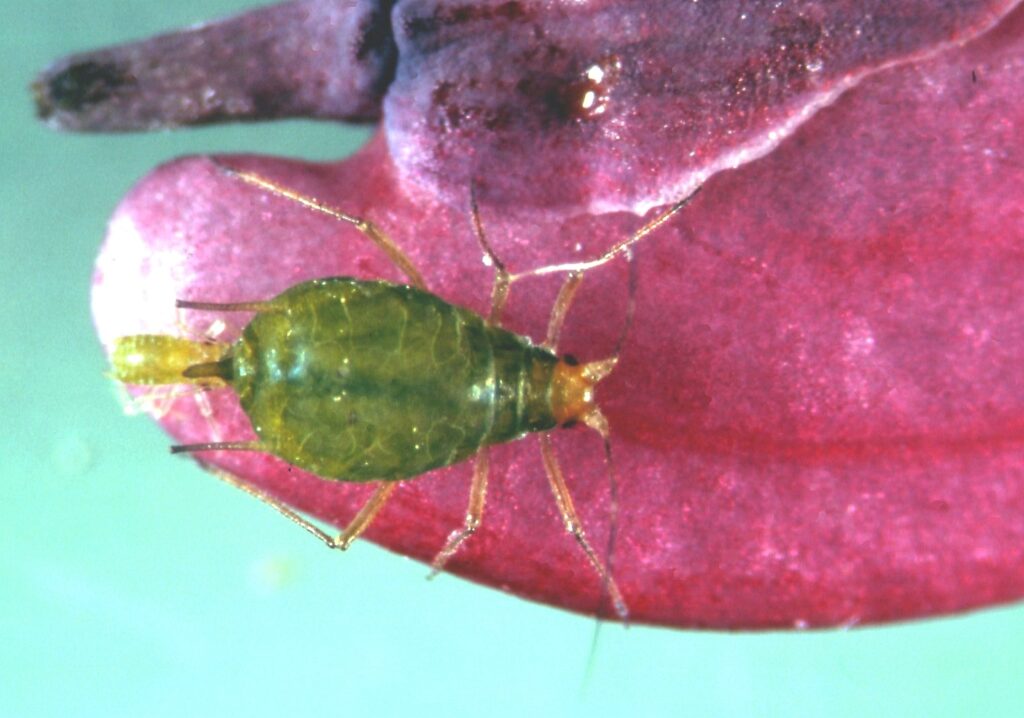
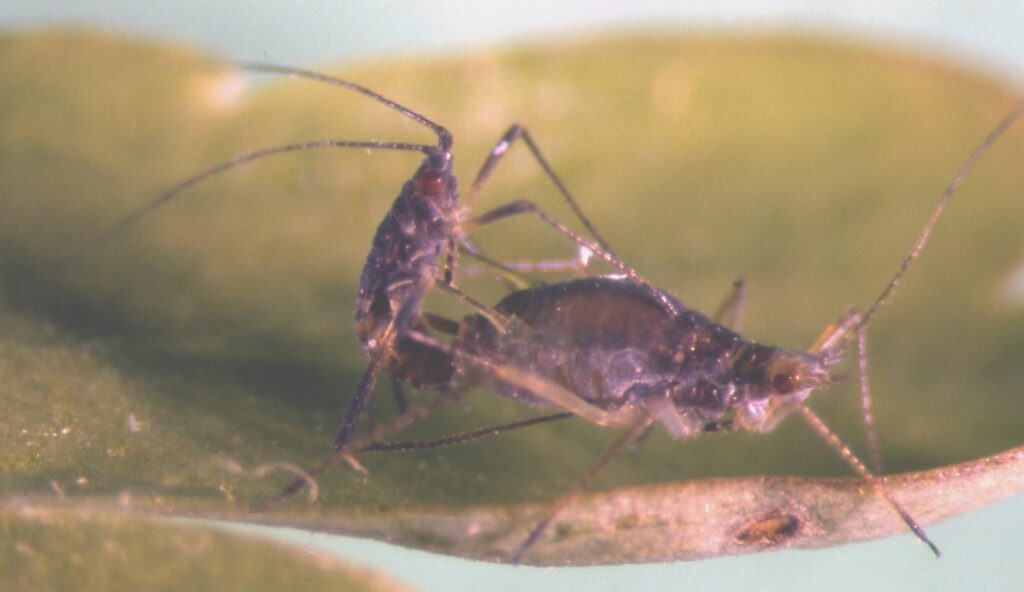
Macrosiphum creelii Davis
This species is one of many that are very similar morphologically to M. euphorbiae, but that have distinct biology and ecology. M. creelii specializes on legumes, particularly Vicia and Lathyrus. It is often bigger than a typical M. euphorbiae, but not always. During many years of pursuit, I eventually gathered material of all morphs from fundatrix to sexuales. One of my favorite habitats to collect this species are the famous public beaches of Oregon. Just at the edge of high-tide water line there often grows a large Vicia, and on that there is almost always the largest and most dramatic specimens of M. creelii. In our local southern Oregon Ponderosa pine forests, M. creelii was uncommon but widespread on native Vicia and Lathyrus growing in the shade of conifers. In the forests of Utah and Colorado this species is often on legumes in aspen groves.
I’ve enjoyed digging up the old descriptions of some of these species, so let’s have a look at Davis’ description of M. creelii. Remember the 4 line description of M. californicum by Clarke, shown above? Davis’ work was the opposite end of the spectrum, covering 7 pages in his 1914 description of this species, including 3 plates of very nice drawings, text discussing its life cycle and potential as a pest, and detailed data on antennal segment measurements for many individual specimens. At the time this aphid was known as a pest of alfalfa in Nevada and Utah. You might be mildly interested in my very first published paper, in which I discuss this species: Jensen, A.S. 1992. Exotic aphids in Oregon. The Northwest Environmental Journal. 8: 217-218. In it, I suggested that M. creelii may have been displaced as a pest of alfalfa by the invasion of pea aphid, Acyrthosiphon pisum (Harris). I have only seen one sample of M. creelii from alfalfa, and that was from an alfalfa seed field near Warden, Washington many years ago.
As with other aphid taxa, both species and genera, that seem to be specific to unusual host plants and that have more or less uniform appearance and morphology, we run the risk of lumping more than one species under a single name (see my coverage of M. californicum above). I suspect this may the case with M. creelii. We can easily slap the name M. creelii on all Macrosiphum specimens collected on Vicia and Lathyrus anywhere in North America as long as they look vaguely similar to each other and to their presumed close relative, M. euphorbiae. For example, in the dry aspen groves of the Southwest (i.e., Colorado, New Mexico, Arizona) we find a small legume, which I think is a Lathyrus, that often forms the main herb understory layer. Macrosiphum aphids are often common in these settings, and I file them with M. creelii, but they are very pale colored, relatively small, and give very different vibe to the more typical M. creelii found in the wetter forests and beaches of the Northwest. Are there two or more species represented here? I don’t know. It’ll take some creative work to figure that out.
I have collected this ‘species’ in Washington, Oregon, California, Idaho, Utah, Colorado, Wyoming, New Mexico, Arizona, Maine, and British Columbia.
Macrosiphum cyatheae (Holman)
This is a fern-feeding species first described from Cuba but subsequently collected on the mainland as well, in Venezuela, Costa Rica, and Mexico. Jaroslav Holman and I covered this species in our joint 2000 paper, and he kindly gave me some paratypes and one other sample from Cuba collected in 1965 and 1967. I recently remounted them from the water-soluble gum-based mountant into Canada balsam. The resulting specimens are actually quite good! In our paper we wrote: “Biology and distribution. This species was described from Cuba feeding on Cyathea balanocarpa DC. (Holman, 1974). It has also been found on Pteridium caudatum (L.) Maxon, and in Venezuela (Robinson, 1980). Most recently it was found on Pteridium and unidentified epiphytic ferns in eastern Mexico (Veracruz). All samples of this species were collected in the mountain cloud forest zone. Its life cycle is unknown. Holotype in the Institute of Zoology, Cuban Academy of Sciences, Havana. Paratypes in the BMNH, Institute of Zoology, Saint Petersburg, Russia and in the second author’s collection.
Systematic position. The siphunculi of this species often completely lack reticulation, and are remarkably smooth, explaining why the species has been placed in Acyrthosiphon. This lack of reticulation separates this species from nearly all other Macrosiphum. Also quite distinctive are its dark legs and antennae in both apterous and alate viviparae. Probably the most closely related species is M. clydesmithi, which also feeds on Pteridium, has reduced reticulation on the siphunculi and occurs far south into Mexico. Separation of the two species is easy using the characters just mentioned.”
Macrosiphum daphnidis Börner
I have collected this species only once, during a collaboration trip to visit Cho-Kai Chan in Vancouver, British Columbia back in 1993 while I was in graduate school in Oregon. He had discovered many adventive aphid species from Europe and Asia on the University of British Columbia campus, including M. daphnidis. This species is covered very nicely at InfluentialPoints.com.
Macrosiphum dewsler Jensen
This is one of my two new species described in 2017.
It is yet another example of a species I’ve known about for a long time, but spent 12 years gathering adequate information and specimens to support a good description. It is named after one of our deceased dogs, Dewey (also known as Dewsler, Mr. Dewsler, and Dewsldoerfer).
I wrote about this species: “This aphid
is monoecious holocyclic on its host Linum lewisii. As noted by Munz (1973), this plant occurs on dry slopes and ridges, mostly above 1,220 meters elevation in montane coniferous forests and pinyon-juniper woodlands. Personal observation makes it clear that this plant
begins its growing season early in the spring, and is highly drought tolerant through the summer and fall. The overwintering stage of the plant consists of
small above-ground shoots ready to grow immediately when conditions allow. The earliest collection I have made of M. dewsler was 3 June 2016 south of La Pine, Oregon. At this location, early June is very early spring in terms of plant growth, yet L. lewisii was in bloom and the aphid population thriving. I have not collected confirmed fundatrices of this aphid, the only possible specimens being these on 3 June 2016. I considered these specimens to most likely not be fundatrices, which means that egg hatch and population establishment must have happened remarkably early at this location. Aphid populations persist on the plant stems after petal fall and during fruiting, seemingly able to reproduce throughout the dry summer months. Alate viviparae are rare, possibly produced only during certain stages of the season or of plant growth, considering that my only alate specimens are from early in the growing season (early July in the mountains of northern New Mexico and early June in the mountains of southern Oregon). In life, this aphid is difficult to see on Linum plant stems, as individuals feed cryptically among the leaves.
Linum lewisii is naturally distributed throughout most of western North America (Munz 1973), and is closely related to the European Linum perenne L. (McDill et al. 2009). Although I have collected this aphid from only New Mexico, Oregon, and North Dakota (a sample from the latter state was secured while this manuscript was in review), it likely occurs where L. lewisii is found in similar habitats in Arizona, California, Nevada, Utah, Idaho, and Washington. McDill et al. (2009) analyzed the phylogeny of Linum and Linaceae, and found that L. lewisii is closely related to Linum species occurring in eastern Asia. Considering this and their estimated time of diversification of L. lewisii from its Eurasian relatives (3.8-3.3 million years ago), they thought it likely the ancestor of L. lewisii colonized North America via the Bering Land Bridge. It would therefore be interesting to study relatives of L. lewisii in eastern Siberia to determine whether they may serve as host to M. dewsler or a close relative.”
Since the paper was published I have collected confirmed fundatrices in the forests of southern Oregon on 8 May 2020. I now have material of this species from Oregon, Nevada, Colorado, New Mexico, and North Dakota. It almost certainly lives in neighboring states as well.
Macrosiphum dicentrae Jensen and Chan
This is the species mentioned above from the paper Cho-Kai Chan and I published in 2009. He had studied it for a few years in the 1980s before i found it in Oregon in the early 1990s. Back then we wrote about it: “Biology and distribution,- This species is monoecious holocyclic, feeding on Fumariaceae, mostly Dicentra formosa (Andr.) Walp., but also found on Dicentra sp. (UCB), Corydalis scouleri Hook. (WSU and ASJ), and Corydalis aurea Willd. (collected by the second author). Based on the known hosts, it is likely to be able to feed on other Dicentra and Corydalis species. A detailed description of the life cycle for populations in Benton County, Oregon on Dicentra formosa follows. Both authors, however, have found populations producing oviparae and males as early as July. These specimens in every way fit the description given above.
In the Corvallis Oregon area, egg hatch occurs in mid-to late February, and fundatrices mature by the end of March, feeding on the young, unfolding leaves. The second generation is apterous and matures in April. The third generation is composed mostly of alatae and matures in May. Individuals in these two generations are most dense on the flowers and fruits, but can be found on the lower surface of the leaves as well. In McDonald State Forest, most of the alatae maturing in a given location remain in the patch of host plants in which they were born, mature specimens usually remaining on the leaves. Apterae reproduce very slowly throughout the summer until leaf senescence begins in autumn, when a fall spurt of reproduction occurs. Nymphal oviparae and males were present in late September, 1992. Male nymphs are a steel bluish color, and nymphal oviparae are white. Sexuales feed primarily on the leaves, mature throughout October, and by early November all males are gone. Eggs have never been seen during observations in Oregon, but the second author has observed eggs laid on the leaves in British Columbia.
This aphid is rare in the Willamette Valley of Oregon. The reason for this may be that few patches of its host remain green until autumn, and it is only these patches that are utilized by this species. It seemed to be more easily found in Washington along Puget Sound and in British Columbia in and near Vancouver. These areas are wetter throughout the year than the Willamette Valley, which may be the factor that allows more Dicentra formosa plants to remain vegetative during the summer. The populations that produced sexuales in July and August, mentioned above, may be in the process of adapting to drier locations in which the host plants die back during the summer.
When disturbed, all morphs of this species are apt to drop from the plant.
This species is known from western British Columbia, Washington, Oregon, and California.”
We went further to say: “The chief characteristic that separates this species from M. corydalis, M. euphorbiae and more closely related species like Macrosiphum tolmiea Essig and Macrosiphum violae Jensen is the fact that setae on the antennae and dorsum of the body are finely pointed (Fig. 9, 10), even in carefully prepared specimens mounted in gum mountants.” The final statement there about mountant type is relevant because if clearing for mounting can be done without the use of a caustic agent like NaOH of KOH (e.g., clearing using chloral hydrate solutions) most Macrosiphum species are revealed to have expanded glandular tips to their dorsal setae, making the setae look slightly capitate.
Macrosiphum diervillae Patch
This is one of the several species of Macrosiphum associated with Caprifoliaceae that I think are a closely related lineage. Other members of this group include M. stanleyi, M. schimmelum, and M. oredonense, among a few others including one undescribed species from southern Oregon. I made M. diervillae a collection target during our 2015 trip to northeastern U.S.A. and was able to find it 4 times in Maine and New Hampshire on its known host, Diervilla lonicera.
Macrosiphum dryopteridis (Holman)
This is another fern-feeder that Jaroslav Holman and I covered in our 2000 paper. I think of it as the European version of the North American species Macrosiphum walkeri. Both species feed on a wide range of fern species, and they look very similar as well. In our paper we wrote: “Biology and distribution. This species was the first fern-feeding Macrosiphum to be described from Europe. Holman (1959) reported finding it on Dryopteris dilatata (Hoffm.) A. Gray (= austriaca), Dryopteris filix-mas (L.) Schott and Athyrium filix-femina (L.) Roth, in the mountainous parts of eastern and southern Bohemia, Czech Republic. It has since been found on Thelypteris phegopteris (L.) Slosson in the Czech Republic and on Athyrium distentifolium Tausch in the Kola Peninsula, Russia. It is monoecious holocyclic with alate males, producing sexuales in September and October in the Czech Republic (Holman, 1959).
This species has been recorded from the Czech Republic, Germany, Finland, Norway, Poland, Slovakia, Sweden and the European part of Russia (Heie, 1994; Holman collections). All five hosts from which it is known are circumboreal in distribution (Hitchcock & Cronquist, 1973), so little about the aphid’s distribution can be deduced from the host plants. Types are in the collection of the second author, BMNH and some other places.
Systematic position. Macrosiphum dryopteridis is remarkably similar to the North American species M. walkeri. The only characters known to separate them are the normal presence of eight or more caudal setae in apterous and alate viviparae of M. dryopteridis as opposed to M. walkeri which most commonly has seven setae. It is possible that they are synonymous, but a conclusion in that regard must await examination of material from throughout the full ranges of both species. This should include collecting on ferns across Russia and through Alaska south to Washington. Macrosiphum dryopteridis is also similar in many respects to M. miho, as discussed under that species.”
I have two slides from a single sample collected by Holman in Czechoslovakia in 1986. In 2008 I remounted the specimens from a gum mountant into Canada balsam.
Macrosiphum equiseti (Holman)
Embarrassingly, I was thinking that this was a species that Jaroslav Holman and I covered in our fern Macrosiphum paper of 2000. It feeds on Equisetum (horsetails), which are obviously not ferns, but I thought we’d covered it. Looking at the paper, it turns out we did not! Anyhow, it was described by Holman in 1961 from Equisetum silvaticum and Equisetum pratense collected in Czechoslovakia during 1960. This is another species that Cho-Kai Chan discovered in Vancouver, British Columbia. Many years ago I studied some of his specimens and compared them to Holman’s material. They are very similar, but I have to admit wondering whether the North American and European forms might be separate species, in a similar fashion to M. dryopteridis and M. walkeri on ferns in Europe and North America, respectively. Over the past 30 years I have tapped on scores of patches of Equisetum in all sorts habitat types from urban settings like Cho-Kai collected in, to mountain slopes, stream sides, and forest fire burn scars. I have found it twice: once in July of 2012 in the Uintah Mountains of Utah on a slope that was recovering from a fire about 10 years previous. The second time I found it was in the Wallowa-Whitman National Forest in eastern Oregon, living on streamside Equisetum in a very shady site. This work implies that it is widespread but uncommon. My other specimens are all from Vancouver when I was collecting there with Cho-Kai in 1993.
Macrosiphum euphorbiae (Thomas)
In May of 2021 I was scrolling through this collection of blurbs about species of Macrosiphum when I noticed that I’d never posted information about the most widespread and well known species of this genus! It’s time to correct that oversight.
Often known as potato aphid, Macrosiphum euphorbiae is native to North America and has spread throughout most of the world. It is one of the most polyphagous aphids known, with many hundreds of documented hosts, and almost certainly there are many hundreds of additional plants that would be acceptable hosts if this aphid were given the chance.
The basic host plant biology in temperate climates is heteroecious, with overwintering on Rosa followed by migration to its many summer hosts, which can be trees, shrubs, and herbs (both monocots and dicots). Many aphid collectors (including myself) have found oviparae and eggs of this aphid on herbaceous hosts, but whether and to what extent it can successfully overwinter on plants other than Rosa is not known. Indoors or in warm climates this aphid can be anholocyclic.
My sense is that M. euphorbiae is likely native across most of North America, but in my experience its prevalence and diversity of appearance and habits is most extreme in the northwestern U.S. states and western Canadian provinces. In these regions there are times when most aphids found in natural systems, such as forests and meadows, are M. euphorbiae on its many secondary hosts. This can render any search for less common aphids a frustrating affair because M. euphorbiae seems to displace many other species.
As a pest of potato in the northwestern states where my experience is greatest, this aphid is an early colonizer, arriving on potato in places like eastern Oregon and Washington shortly after crop emergence (e.g. mid-late May to early June). It rarely stays in the crop beyond July 1, after which green peach aphid (Myzus persicae) takes over. Its ubiquity in natural systems across much of northern U.S.A., however, means that most potato crops are growing near native populations of potato aphid that could pose a threat, especially as virus vectors.
Taxonomically M. euphorbiae is challenging due to its lack of unusual features and because of its extreme variability in both color and morphology. A practical consideration for a taxonomist like myself is whether Macrosiphum specimens found on an unusual plant are typical M. euphorbiae, or M. euphorbiae that look different due to stresses imposed by climate, host plant, or microhabitat, or whether the specimens belong to a separate species. There are now many well-understood species of Macrosiphum around the world that look remarkably similar to M. euphorbiae but that have distinctive biology and life cycle with very slight morphological differences.
Below I present a range of photos of this species, showing all its morphs and some of the range of variation in appearance.
Macrosiphum euphorbiellum Theobald
This species has been reported from one location in North America and I’m afraid I’m the guilty party. On 26 February 2015 I collected some unusual-looking Macrosiphum from an ornamental Euphorbia growing in the landscaping of Washington State University’s Mount Vernon research and extension center. This site is near the Pacific Coast, so late February is early spring there and many plants are actively growing. It is also a place with warm-ish winters that allow many plants to remain green throughout. My sample included both apterous and alate viviparae. These specimens immediately struck me as something other than M. euphorbiae because of the pigmentation of the legs and siphunculi, the short broad R IV+V, and the long-ish ANT VIa (Base). Using the key to aphids on Euphorbia provided by Blackman and Eastop, they run fairly smoothly to M. euphorbiellum except that the R IV+V appears to be a bit too short compared to the ANT VIa. Nonetheless, I still conclude that my identification is probably correct based on other features and the nice summary of the species provided by InfluentialPoints.com. If I end up deciding I was wrong, I will try to clarify that here.
Macrosiphum funestum (Macchiati)
Another species I have collected several times in Europe, this one feeds on Rubus, especially blackberry (e.g., R. fruticosus). The first time I collected it was in 1993 during my stay in Czechia for the one and only international aphid symposium I have attended (thanks to my co-major professors Gary Reed and Jack Lattin for the financial support of this trip). The aphid lived on the campus of the university where we stayed. It was quite an experience going to Czechia just a few years after the dissolution of Czechoslovakia. I was extremely uncomfortable in social situations (I often still am), and in a milieu where most people spoke languages other than English and were from unfamiliar cultures, I was a fish out of water. I also collected this species several times during our 2 trips to Europe in the 2010s. As is so often the case with European aphid species, InfluentialPoints.com has a nice page on this species.
Macrosiphum garyreed Jensen
This is the second new species I published in 2017. It is named after my undergraduate and graduate supervisor and mentor, Gary Reed.
Gary was an entomologist and superintendent of the Oregon State University Hermiston Agricultural Research and Extension Center in eastern Oregon. He supported me through 8 years of my life, including paying for my Ph.D. education and supporting my work in systematics of aphids.
I wrote about this aphid: “This species is monoecious holocyclic on its host plant, Geum triflorum. It was first discovered by Gary Reed in the early 1990s feeding among the developing achenes in the flower heads, but most of the season it feeds on the stems and leaves. This plant has a similar over-wintering strategy as L. lewisii, discussed above, in that it overwinters with basal leaves intact, and ready to grow immediately in spring. I have often observed flower heads extremely early in the spring, indicating that the plant must grow during warm spells in winter. This produces a situation wherein fundatrices of M. garyreed are able to develop and deposit their offspring on the flower stems and buds of a strongly growing plant early in the season. Although I have known about and collected this species since the early 1990s, it has been difficult to find the sexuales in the fall. After blooming and seed drop, G. triflorum enters a more or less dormant vegetative state during late summer and fall during which M. garyreed is hard to detect and collect due to low population densities. Until the fall of 2016 I had never collected this aphid late enough in the fall to find the sexuales. My single collection site of sexuales was on a place called Winter Rim in southern Oregon in early October (8 October 2016). As suggested by the place name, Winter Rim is a cold and windy high-elevation ridge. When I collected sexuales of M. garyreed there, almost all other aphids were gone, long previously either migrated away or in hibernation as eggs. Among the leaf litter were G. triflorum plants with both green and senescing leaves, the latter bearing many nymphs and adults of M. garyreed.
So far this aphid is known from only Oregon and Idaho in the U.S.A. Geum triflorum occurs throughout much of western North America and across northern U.S.A. and Canada as far east as New York State (Hitchcock and Cronquist 1973). I have looked for this aphid on its host across much of western North America, mostly without success, suggesting that it may have a restricted distribution in parts of Idaho, Oregon, and probably Washington and California (some of my collecting localities are very near state borders). It is possible that the aphid’s distribution is related to a relatively narrow forest ecosystem(s) as compared to the broad distribution of G. triflorum.”
I’ve found this aphid a few more times since the paper was published, and now have it from Oregon, Idaho, and Wyoming. Many more Geum triflorum patches have been searched in Colorado since we moved here in 2021, all without luck funding M. garyreed.
Macrosiphum gaurae (Williams)
Locally common, this aphid is probably a complex taxon composed of two to four species. Out west in my area, this aphid feeds on Gaura and can be found in various habitats. Its siphunculi are less reticulated apically than most Macrosiphum, and the tarsi look fat to me. In Maine it is mostly found on native Oenothera, and the siphunculi look rather different but the tarsi are still fat. In the south such as Florida and Texas, what might be called this species can be pink and have almost entirely dark siphunculi (much darker than in the photo below); these live on Oenothera and Gaura. In the old days of aphid taxonomy, there’s no question that they would all be described as separate species due to their morphological disparity. Today, after having many samples from across North America at my disposal (when I borrowed material from a couple collections), I still think there are likely 2 or more species, but can see why the current dogma is one of lumping: there IS a lot of variability across the continent but all specimens share some features like fat tarsi, convincing me of their relatedness.
Since moving to Colorado in 2021 we now have M. gaurae living on our property and along our country road. This allowed me to finally collect the fundatrix on 12 April 2023. These were living on the overwintering rosette stage of what I called Gaura parviflora but that I see may be a different species, now placed in Oenothera. To put this date into perspective, our site is in USDA Zone 5b (-ish) and our expected final frost date is around 1 June. So, to develop to adult by 12 April these fundatrix eggs must have hatched in mid- to early March, a time that well and truly feels like winter here. I also have secured more sexuales on our road, collected on overwintering rosettes in mid-October.
From the lumper’s perspective, I have material of this ‘species’ from Oregon, California, Colorado, New Mexico, Maine, New Brunswick, Quebec, and Texas.
Macrosiphum gei (Koch)
This is a European species that I collected several times during our two European trips in the 2010s. I also have three slides from a Lithuanian sample kindly sent to me by Rimantas Rakauskas. It feeds on Geum and apparently also various Apiaceae. My samples are from both families. It is not morphologically very distinctive, but its hairs on antennae, head, and legs seem unusually long and the subgenital plate has a few hairs on its disc in addition to the usual anterior pair and posterior row. This name was for many years in the early 20th century used for M. euphorbiae in the U.S.A., so older records should be viewed with caution. It has supposedly been introduced to North America, but I have not knowingly seen it yet. The chaps at InfluentialPoints.com have done a nice page about this species.
Macrosiphum ginajo Jensen
The description of this species marked the 20th Macrosiphum I’ve named. I first found this aphid in 2008 on a hike with my sons in the Cascade Mountains of Washington State. It lives on sticky members of the plant genus Silene, and can be hard to find even in likely locations with appropriate host plants. I was lucky to live in southeastern Oregon for several years and to find some localities where M. ginajo is abundant, allowing me to collect all life stages and better understand its natural history. As I wrote about it in the paper:
“Etymology. The species name is in honor of Gina Rone, who has supported hikes and camping outings aimed at finding this species for the past twelve years, waiting patiently in the forest as I search for Silene and its aphids. A geologist and forest soil scientist, Gina has helped me understand the ecology of this and many other aphids. For the purposes of the rules of nomenclature, the name should be considered an arbitrary combination of letters and treated as indeclinable.
Biology and Distribution. This aphid lives without host alternation on glandular–sticky members of Silene, especially Silene oregana S. Watson. The full host range of M. ginajo is not known because the author has not been able to make accurate species identifications of all sampled plants. One sample from Shoshone County, Idaho was
recorded as feeding on a Silene with pink flowers. This may have been Silene scouleri Hook., which is sticky like S. oregana, occurs across the known range of M. ginajo, and has pink flowers. Many stands of non–sticky Silene (probably Silene douglasii Hook.) have been searched for M. ginajo over the years, but without success. In the forests of Lake County, Oregon, where this aphid has been most thoroughly studied in the field, its S. oregana host plant occurs most commonly in association with white pine (Pinus monticola Douglas ex D. Don) or sugar pine (Pinus lambertiana Douglas) and often on soils associated with rhyolitic parent material.
So far, this aphid is known from Washington, Oregon, California, and Idaho. The range of S. oregana also includes parts of Montana, Wyoming, and Nevada (Hitchcock & Cronquist 1973), indicating that M. ginajo may occur in those states as well.”
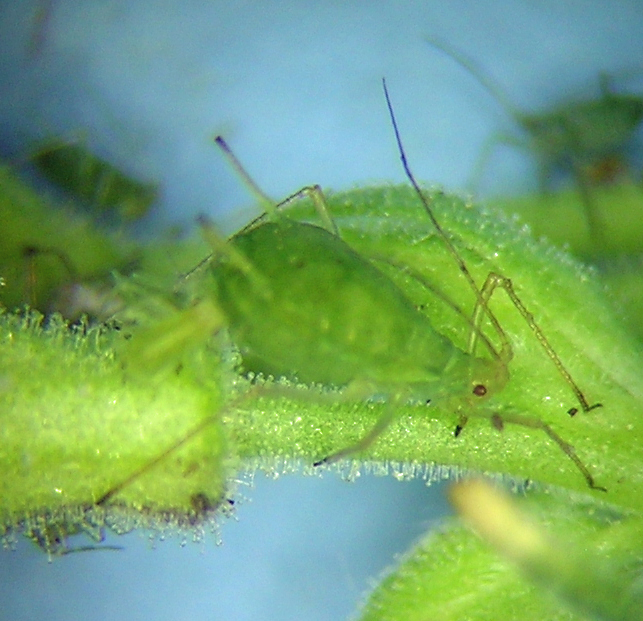

Macrosiphum glawatz Jensen
I’ve been gathering field observations and specimens of this species off and on since the early 1990s. Being ant-tended, it is very unusual for its genus. I was finally able to gather enough material to publish it recently. As I wrote about it in the paper, “Etymology.—This species is named in honor of Claus and Helga Glawatz, parents of Gina Rone. Despite living in Germany and speaking little English, Claus and Helga have seen more of the United States than almost anyone, including much of the habitat of M. glawatz.
Biology and distribution.—This aphid lives throughout the growing season on Potentilla gracilis in meadows and edges of dry forest. Much collecting effort over the years has not yet yielded any sexuales, and none of the apterae collected so far can be confidently labeled as fundatrices. Despite these facts, it is extremely likely that M. glawatz is monoecious holocyclic on P. gracilis. Evidence supporting this idea are the collections of apterae of this species in early spring. At the time of these collections, such as 16 May or 30 May, P. gracilis in eastern Oregon is just entering its pre-flowering growth stage and is in perfect condition for aphid reproduction. At the same time, shrubs and trees that might be host to an undiscovered primary host life stage are just beginning growth and would be very unlikely to support two spring generations of an aphid that then migrates to P. gracilis by early May. The lack of success in finding sexuales is related to two primary issues: the phenology and growth habit of P. gracilis and the nearly ubiquitous cattle grazing of relevant habitats.
The life cycle of P. gracilis is similar to the hosts of two other recently described Macrosiphum species from similar habitats, Macrosiphum dewsler Jensen on Linum lewisii Pursh and Macrosiphum garyreed Jensen on Geum triflorum Pursh (Jensen 2017), in that it overwinters as a basal rosette and begins growing in early spring, flowers during the summer, and then survives the late summer drought as a basal rosette with very small leaves. It is likely that the sexuales of M. glawatz develop on these late summer rosette leaves but searching for them is challenging in part due to heavy cattle grazing and trampling that decimates M. glawatz habitat every summer. If a good site could be located that is free of grazing, M. glawatz could be followed from early spring through its presumed sexual stage in that site, but we have not been lucky enough to find such a place.
Macrosiphum glawatz is unusual among Macrosiphum and similar genera in that it is almost always tended by ants. The only other western North American Macrosiphum that is usually ant-tended is Macrosiphum rhamni (Clarke) when it is feeding on its secondary host, Pteridium aquilinum (L.) Kuhn. Only a few samples of the ants tending M. glawatz have been collected, but these all belong to the genus Formica L.”
UPDATE June 2020: I was lucky to finally find the fundatrices of this species in our local Fremont-Winema National Forest. They were found on a robust specimen of Potentilla gracilis that was growing in a little-used gravel road at about 1,900 meters elevation at the top of a cool drainage. The fundatrices were on the developing stems near the base of the plant. The granules of soil around the base of the plant indicated the presence of the tending ants.
I now have material of this species from Washington, Oregon, California, Idaho, Nevada, and Wyoming.

Macrosiphum hartigi Hille Ris Lambers
This fairly distinctive species feeds on Silene in mountainous parts of Europe like the Austrian Alps where I found it along the side of a road as we finished a hike into the hills from Ötztal. Hilariously, almost our whole trip to Austria in 2014 was under cover of clouds and rain, so most of the views we had of the mountains were up close, whatever was right in front of us. My sample of this aphid is now on two slides, including 1 alate and 7 apterous viviparae.
Macrosiphum hellebori Theobald & Walton
This is one of many aphid species that has been accidentally introduced to North America, first found in western Washington. It lives on Helleborus, also known as Christmas rose because some cultivars bloom in the winter. This aphid is fairly easy to find in western Washington pretty much throughout the year (I have samples from February through August). I also found it twice in Germany in the landscaping of our bed and breakfast hosts. It likes to live in and on the flowers of its host plants. InfluentialPoints.com has a nice summary of this species.
Macrosiphum holodisci Jensen
I was the first to notice this aphid as new, and oddly it seemed to appear where it was not before in my normal aphid stomping grounds of McDonald State Forest in Oregon. I have collected aphids on Holodiscus very thoroughly for over 30 years now throughout western North America, and this species is extraordinarily uncommon. I have collected it now in only four locations, 3 in Idaho and 1 in Oregon, and seen material from Washington and California. I published this species in 2000 and wrote about it, “Macrosiphum holodisci was originally discovered on its host, Holodiscus discolor (Pursh) Maxim. (Rosaceae), in the forests west of Corvallis, Oregon. Several specimens were collected during the fall of 1991, including some oviparae and males. Several oviparae were enclosed in the field in a thin cloth bag, and allowed to oviposit on the leaves and branches within the bag. The bag and its contents remained undisturbed throughout the winter, and the spring generations were reared within the bag until May, 1992. Interestingly, the oviparae laid their eggs on the leaves, twigs, buds, etc., yet the first instar nymphal fundatrices found each other upon hatching, and developed in tight clusters on the buds and young leaves through their second instar. This is in contrast to many other Macrosiphum, whose nymphal fundatrices tend to be more dispersed. The early instar fundatrix of this species is also unusual in that it has pairs of dark sclerites on the abdominal tergites, and because it is a striking yellow color, while the adult is white.”
Macrosiphum impatientis (Williams)
This is a species I studied extensively in the field and lab during my postdoctoral work at the U.S. national insect collection in Beltsville, Maryland, just outside the Washington, D.C. “beltway.” I published my results in 1998, when I wrote: “History — Williams (1911) described this aphid from material collected in Nebraska on Impatiens pallida Nutt. He considered it to be a variety of Siphonophora carnosa Buckton (=Microlophium carnosum), a Palearctic Urtica-feeding species. Macrosiphum impatientis has not been mentioned again outside of several species lists and host-plant indexes (Wilson and Vickery 1918, Patch 1938, Eastop and Hille Ris Lambers 1976, Smith and Parron 1978). The specimens of Macrosiphum from Impatiens mentioned by MacGillivray (1968) in her discussion of Macrosiphum pallidum (Oestlund), were in fact M. impatientis. Correspondence records in the Systematic Entomology Laboratory show that MacGillivray understood the correct placement and identity of M. impatientis, but was unable to complete her study of it. MacGillivray designated paralectotypes from the cotypic material in the National Collection of Aphidoidea (located at the Systematic Entomology Laboratory, USDA, Beltsville, Maryland, USA), and these were examined during this study.
Biology — Until now, M. impatientis has been collected only from species of Impatiens, but studies of M. impatientis in Maryland in the summer and fall of 1996 and spring 1997 showed it clearly has a heteroecious life cycle. Several generations of apterous and alate viviparae were studied in two locations in Beltsville, Maryland, from 24 July through November, 1996. The aphids were found on Impatiens capensis Meerb. and generally occurred in small aggregations composed of one or two adults and several nymphs. In October a generation of apterous viviparae, which had been brought into the laboratory, produced first a series of alate viviparae, then males. About the same time, a single alate vivipara was collected in the field on Rosa multiflora Thunb., a common exotic shrub. Therefore, alate viviparae were transferred to R. multiflora and several other common broadleaf shrubs to test the aphid’s host acceptance on potential primary hosts. Alate viviparae were also transferred to Vaccinium, Sambucus, and Cornus, as well as two other unidentified shrubs located near I. capensis plants. Only the aphids on R. multiflora successfully reproduced, their nymphs developing into oviparous females. Fundatrices of this species were then discovered on many different R. multiflora plants during April 1997. Progeny of one of these fundatrices were successfully transferred to I. capensis in May 1997. The success of this transfer along with the discovery of many naturally colonizing alate viviparae proved that M. impatientis has a heteroecious life cycle between Rosa and Impatiens. The discovery on Impatiens of a small colony composed of oviparae suggested that this species may sometimes overwinter on its secondary host, much as does M. euphorbiae.
The historical rarity of this species is evidenced by the paucity of older material in the National Collection of Aphidoidea. Prior to this study, there were several collections made, but these amounted to only a handful of slides. Examination of all available material collected from Rosa or Impatiens and identified as Macrosiphum sp. or M. euphorbiae uncovered a few specimens from Impatiens, and only one specimen from rose. It appears, however, that the rarity of this species may be changing. It was common and easily found on I. capensis during the summer of 1996 in Maryland, and in the spring of 1997 it was common and abundant on R. multiflora and Rosa carolina L. growing near I. capensis. These were the only rose species growing in areas where this aphid was commonly found in 1996 and 1997, the former being a much more common, invasive exotic, and the latter a small, uncommon, native rose. Rosa multiflora is becoming more widespread in disturbed and undisturbed habitats. It is likely that M. impatientis has become more common in Maryland as R. multiflora has invaded Impatiens habitat.
Further biological work should be done to determine the pest potential of this aphid on cultivated roses. No transfers of this aphid were made to cultivated roses, but considering that M. impatientis can feed on the exotic R. multiflora, it is quite likely that it could also feed on other species of exotic cultivated roses.
Distribution — Macrosiphum impatientis is known from Illinois, Maryland, Missouri, Nebraska, Ohio, Pennsylvania, Virginia, and Wisconsin. Given this extensive known distribution, it is likely to live in much of northeastern and midwestern North America.”
InfluentialPoints.com secured some photos of this species and have a nice summary of it.
Macrosiphum knautiae Holman
I have some affection for this species because I corresponded about it with a valued colleague in Lithuania (Rimantas Rakauskas) back in 2003 or 2004, when he sent me a couple samples for my collection. I then had the chance to collect it myself on our 2014 trip to Germany and adjoining countries. It is monoecious on Knautia, a genus common in Europe, its beautiful flowers dotting the meadows and roadsides of Germany. This aphid is very similar to Macrosiphum rosae, which is heteroecious between Rosa and Dipsacus, a close relative of Knautia.
Macrosiphum lambi Robinson
This is one of the species Jaroslav Holman and I covered in our 2000 paper on fern-feeding Macrosiphum. It is known mostly from eastern Canada and U.S.A. on Athyrium, but has apparently also been collected on Thelypteris in Alaska (a record I would be skeptical of until I see the specimens). Like most of fern-feeders, its cauda is on the short side, the abdominal dorsum is clear but sclerotized, and it tends to have a lot of rhinaria on ANT III. Compared to similar species like M. ptericolens, it has a short R IV+V. As we wrote in 2000, “Macrosiphum lambi’s only host appears to be Athyrium filix-femina, but sexuales have not been recorded, leaving open the possibility that this aphid is heteroecious. Concerted collecting on ferns and broadleaf shrubs in the areas that this aphid is known to occur may lead to the discovery of a wider host range on ferns, or its primary host, if such exists.” I have one sample of two apterous specimens from Ontario, Canada in August of 1991.
Macrosiphum longirostratum Jensen & Holman
Here is yet another species covered in the joint paper I did with Jaroslav Holman. He had been able to collect extensively in Mexico and found this species in Michoacan feeing on Woodsia mollis in 1981. We wrote about it: “Biology. Lives on the underside of the leaves, usually solitarily or in groups of 2-3 on the midrib. Monoecious, holocyclic.
Systematic position. Closely related to M. woodsiae from which it differs in having longer u.r.s. (0.18-0.21 mm in M. longirostratum vs. 0.12-0.15 mm in M. woodsiae). The u.r.s./metatarsal II ratio is also usually larger in M. longirostratum (1.54-1.95 in M. longirostratum apterous and alate viviparae, vs. 1.40-1.60 in M. woodsiae). It should be noted that although there is minor overlap in this ratio, there is strong separation in absolute lengths of the u.r.s. In other species of Macrosiphum studied here (M. osmaroniae, M. ptericolens and M. pteridis), we have observed that biologically distinct species are separated morphologically based largely on absolute measurements. Thus we feel confident in separating this new species from M. woodsiae using the differences in u.r.s. length and absence of rhinaria on a.s. IV of the alate vivipara in M. longirostratum.”
The samples I have of this species were all from Holman’s original material and are considered paratypes.
Macrosiphum manitobense Robinson
This aphid is a source of embarrassment for me because it is one Macrosiphum species whose full host plant biology has eluded me for my whole aphid research career. It was one of the first Macrosiphum species I studied in the field outside Corvallis, Oregon in McDonald State Forest.
It was common there in spring and fall on Cornus stolonifera. It was obvious that a secondary host was utilized in the summer: all colonies in spring matured into alate viviparae and emigrated in April and May, and in September and October alate viviparae and males returned to Cornus. This was seen year after year. Since that time I have collected this aphid elsewhere, in far flung places like Moses Lake, Washington, and Jemez Springs, New Mexico. But, after 27 years of aphid collecting, I still have not turned up this aphid on its secondary host. Its short cauda has lead me to speculate that it may utilize the lower parts or underground parts of a secondary host. Even with this idea in mind, I have not found it anywhere but Cornus in spring and fall. It is locally common, and obviously widespread, but in almost all places I look at Cornus stolonifera this aphid is not apparent. The most obvious explanation for this patchy distribution is the aphid’s likely tie to a secondary host. But what is that plant??
Blackman and Eastop imply that there may be two similar species on Cornus that might be confused under this name. I agree that my material differs slightly from Robinson’s original description, but I think characters such as the unusually short cauda almost certainly indicate at least a close relationship between Robinson’s M. manitobense and mine. Recent study of the type of Macrosiphum potentillae (Oestlund) made me hypothesize in print (Jensen and Rorabaugh, 2020) that M. potentillae and M. manitobensis are closely related. The latter may in fact be the primary host form of the former.
I now have this species from Washington, Oregon, Utah, and New Mexico.
Macrosiphum melampyri Mordvilko
I found this species a few times during our 2014 trip to Germany. I remember thinking that it looked like yet another Macrosiphum of a similar overall appearance to many others I’d seen on the trip. Indeed, many of these Macrosiphum species in Europe look similar in life and on slides, much like many of the North American species I study look similar. My samples of M. melampyri were a mixture of green and red individuals, contrary to Blackman and Eastop’s note that the species is green. I remember finding it on its Melampyrum hosts along trails that we walked through patches of forest.
Macrosiphum mentzeliae Wilson
This interesting aphid feeds on the strange plant genus Mentzelia (Loazaceae), the species of which in my region are strangely sticky. I think the sensation of stickiness is actually caused by a thick covering of trichomes (see photo). I have only been collecting this aphid for a couple decades because it was only then that I learned how to recognize and find Mentzelia in my collecting. It is an unusual plant in that it is most commonly found in dry places along roads in the northwestern U.S.A. — in such places I don’t spend much time collecting. The most common host for this aphid in central Washington is the very showy Mentzelia laevicaulis, and I have collected it several times from a more diminutive species, probably M. albicaulis, and in New Mexico I’ve gotten it from a tall Mentzelia with big white flowers. I have material of this species from Washington, Oregon, Idaho, Colorado, New Mexico, and Arizona.

Macrosiphum mertensiae Gillette & Palmer
I wrote a little about this species in my essay on recognizing Macrosiphum euphorbiae due to the extreme similarity of the two species when comparing cleared and mounted specimens. Gillette and Palmer described M. mertensiae in 1933 based on a single sample collected in Fort Collins, Colorado in June of 1917. Their description was reasonably thorough by the standards of the day, but provides little useful information to separate this species from the range of Macrosiphum diversity known today. They compared M. mertensiae to Macrosiphum niwanistum, which also feeds on leaves of Mertensia, but did not include M. euphorbiae in their comparisons presumably because the latter had not yet been recognized on Mertensia. In the field this species is easy to recognize by its very pale color (nearly white) and its habit of feeding on lower leaves of large species of Mertensia. When I find M. euphorbiae on Mertensia, often in the same or similar habitats, it is green or pink and lives on the growing tips and inflorescences. Some possible distinctions from M. euphorbiae include M. mertensiae‘s effort to have small spinal tubercles on head and abdominal tergites VII and VIII, and its tendency toward more imbrications on ANT III. My samples of M. mertensiae are from Idaho, Utah, and Colorado. Frustratingly, I have several samples from Washington, Oregon, and Idaho that on slides look more like M. euphorbiae but could possibly be M. mertensiae.
Macrosiphum miho Jensen & Holman
This species was covered thoroughly in our joint paper from 2000. In it we wrote, “The specimens upon which this species is based were described by Hottes & Frison (1931) as M. adianti (see that species, above). Therefore, these descriptions will briefly supplement the descriptions of Hottes & Frison (1931). Some specimens described by them as apterous viviparae are apparently fundatrices, and are described as such below.”
Further, we wrote, “Biology and distribution. This species is apparently monoecious holocyclic, based on the presence of fundatrices in May. Its host plant is not at all clear, since no ferns in Illinois are currently placed in Aspidium, the name given to the host plant of this species by Hottes & Frison. According to the Flora of Illinois (Jones 1963), there are nine species of ferns in that state that grow in rock walls, the habitat of this species. Two of these, Dryopteris marginalis (L.) Gray and Polypodium virginianum L., used to be placed in Aspidium. Both of these occur in Starved Rock State Park. Based on the information at hand, it seems likely that the host plant of M. miho is one of these two plants. Further collecting in Illinois is required to solve this problem with certainty.
Systematic position. The new species differs from all other fern-feeding Macrosiphum except M. adianti and M. dryopteridis in that its a.s. IV is nearly always shorter than a.s. V. In M. dryopteridis a.s. IV is usually about equal to a.s. V, often slightly shorter. Macrosiphum miho can be separated from M. dryopteridis by its short u.r.s. (about equal to or shorter than metatarsal II), and by the fact that its a.s. IV is usually about half as long as a.s. III, while M. dryopteridis has a.s. IV about three-fourths as long as a.s. III. The new species is very similar to M. adianti in general appearance, and in many particulars. The two species can be separated by the relatively short antennae, femora and tibiae of M. adianti coupled with its long tarsi (see measurements, above). In M. adianti the metatarsal II is distinctly longer than the u.r.s., while the two are subequal in M. miho. Qualitatively, the siphunculi of M. adianti have a distinctly different shape, often being narrowest at the base (compare Figs 3G and 10E).”
Since this paper was published I was able to collect this species once in Wisconsin on a fern growing among rocks. My sample is composed of 3 slides and 8 apterous viviparae.
Macrosiphum niwanistum (Hottes)
I still vividly remember the first time I found this aphid — it was in the Blue Mountains near the border of Washington and Oregon. We’d camped in a cool drainage that doubled as a trailhead for a major cross-wilderness trail for hunters and backpackers.
The forest was alive with beasts, probably all deer, but in the dark of night, one never knows. In the morning I arose to collect aphids as always, mostly right near camp among all the big fleshy wetland plants such as this aphid’s host, Mertensia (blue bells). To my delight, the aphid was abundant and looked just like I read about in Hottes original description. Most specimens live on the lower leaves of the plant, are covered in a light wax, and drop very readily from the plant when disturbed. As I worked my way back toward the tent where Gina and Bumble still lounged, a man and a dog came down the trail! The other end of the trail I knew to be about 17 km away, and the man and dog had no pack or water. The dog arrived, and slumped immediately into a puddle in the trail at my feet. The man carried a gun in a holster, and nothing else. He explained that he was a trail maintenance contractor and had walked the full length of the trail that morning to scout how much work was needed to renovate the trail. I offered him food and water, which he declined except for a couple gulps of water, he called his dog, and they headed back. Ever since then I call him the hiking man — doing more hiking in the morning before breakfast than I want to do in a whole weekend.
This is another case of a ‘species’ being quite variable in morphology, especially lengths of siphunculi and other appendages. This variation seems to correlate with geography. Is this a single species or perhaps two? Hard to say without quite a bit more field work and morphological study.
This aphid turns out to be quite common and widespread. I have it from Washington, Oregon, Idaho, Utah, and Colorado.
Macrosiphum occidentale (Essig)
This is one of the species I worked on extensively during my graduate school years in the forests of western Oregon. I published my results in 2000, when I wrote, “Biology and Distribution — This species was described by Essig from Prunus emarginata (Dougl.) Walk. (Rosaceae), collected on the University of Washington campus in Seattle. I have collected the species only from Oemleria occidentalis (Rosaceae). While it is possible that this aphid feeds on both host plants, I suspect that Essig’s record may be incorrect. Both plants have similar inflorescences, and can have black fruits. They also co-occur in western Washington. Essig’s specimens were collected from plants growing “under larger trees,” the exact type of condition one expects to find Oemleria. At present it cannot be confidently stated whether the aphid feeds on only one or on both plants.
This species is monoecious holocyclic, with alate males. Eggs hatch somewhat later than M. osmaroniae, with adult fundatrices usually found in the Corvallis area in early April. These live on the older, more mature leaves, i.e. generally not on the expanding leaves of growing shoots. Aphids can be found reproducing throughout the summer in the shaded locations where this species always lives.
Macrosiphum occidentalis is known from British Columbia (C.K. Chan collections), Washington and Oregon (ASJ collections), and California (UCB material).
Remarks — This species has been confused over the years with M. osmaroniae, and has been placed in Macrosiphum and Illinoia Wilson most recently. Eastop & Hille Ris Lambers (1976) were apparently the first to synonymize the two species, placing them in Macrosiphum. Smith and Parron (1978) followed the earlier decision to synonymize, but placed the species in Illinoia, apparently because of its slightly swollen siphunculi. Close examination of many species of Macrosiphum and Illinoia has suggested to me that species such as M. occidentalis are better placed in Macrosiphum for several reasons. First, species that are truly related to the type of Illinoia, I. liriodendri (Monell) possess swollen and reticulated siphunculi, but the reticulations are usually restricted to the part distad of the swollen area; i.e. the swollen area and the reticulated area are distinctly demarcated. In contrast, the few species of Macrosiphum with swollen siphunculi show a reticulated area that gradually blends into the more basal swollen area. Second, Illinoia species have only 2 pairs of dorsal setae on protarsal II, whereas M. occidentalis and its relatives have 3 or more such setae. Third, nearly all Illinoia species have relatively short a.s. VIa, being less than 0.3 times a.s. V, while M. occidentalis and its relatives have this ratio greater than 0.3. There are a few other general rules that I have observed that serve to separate Illinoia from Macrosiphum. Hopefully these can be addressed more fully in a later paper, and all the species in the two genera placed in the correct genus.
It is clear that M. occidentalis and M. osmaroniae are different species. First, in the field they inhabit different parts of the plant, have different types of life cycles, and adopt different postures, i.e. adults of M. occidentalis often feed with their antennae directed forward and slightly to the side, whereas M. osmaroniae adults have the typical Macrosiphum habit of folding the antennae back along the body. Secondly, their morphology is drastically different in some respects. For example, the u.r.s. of M. occidentalis is much shorter (shorter than metatarsal II in M. occidentalis, equal to or longer than metatarsal II in M. osmaroniae), and its cauda is more setose (normally 10 or more setae in M. occidentalis, less than 10 in M. osmaroniae), among other things.
A truly similar species is Macrosiphum parvifolii (Richards). The two species are similar overall, but can be separated by specific characters as follows. Macrosiphum occidentalis has less swollen siphunculi (only slightly swollen in M. occidentalis, distinctly swollen basad of the reticulations in M. parvifolii), a.s. V not longer than a.s. III (a.s. V often longer than a.s. III in M. parvifolii), and much smaller spinal and lateral tubercles (lateral tubercles in M. occidentalis about as wide as a setal base, in M. parvifolii much wider than a setal base). Macrosiphum willamettense n. sp. is also similar, but its apterae and alatae have only 7-9 caudal setae as opposed to 9-14 in M. occidentalis.
Illustrations by Essig (1942) are adequate, but note that the abdominal dorsum in the apterae has sclerotized bands as in Essig’s figure, but these bands are pale, not pigmented as drawn. The type specimens from which the drawings were made are stained, which made the pale sclerotized bands more apparent than they would be otherwise. Other notes that can be added: the ocular tubercles and interfacetal spaces are pale or only slightly pigmented; the compound eyes are small, with a large gap between them and the antennal bases, much as in M. holodisci (similar to Fig. 17); the ventral surface of the head has only a few spinules; the a.s. III of the aptera often lacks sensoria altogether; protarsal II with more than 3 pairs of dorsal setae.”
Macrosiphum olmsteadi Robinson
As I noted years ago on my Flickr page, Macrosiphum-like aphids I collect on Eurybia conspicua are probably best identified as Macrosiphum olmsteadi Robinson. The other possibly correct species name is Illinoia (Masonaphis) magna (Hille Ris Lambers). As far as I can tell from review of paratypes of M. olmsteadi and the original descriptions of both species, the main discrepancy between the two is number of setae on tarsal segments 1: 5 on I. magna and 3 on M. olmsteadi. The two share distinctive characters such as the slightly clavate siphunculi, spinulose tarsi, setose tibiae and rostrum, etc. Both are recorded from species of aster in the genus Eurybia. Obviously this is another case of the muddled taxonomy of Illinoia vs. Macrosiphum that underlies our current aphid classification.
The aphids I identify as M. olmsteadi live on Eurybia conspicua in the interior mountains and foothills of Idaho and neighboring states and provinces. This plant is interesting on its own — being a perennial herb that commonly grows on the forest floor and rarely blooms. My interpretation of its biology is that it establishes in forests and grows only vegetatively until an opening in the forest canopy from tree fall allows adequate light for it to bloom. This aphid is common on its host plants in shaded forest and also on the rare flowering specimens, feeding mostly on the undersides of leaves. I have specimens from Idaho, Washington, Oregon, Montana, British Columbia, and Alberta.
Macrosiphum opportunisticum Jensen
This species I finally described recently after many years of collecting it occasionally in its mountain habitats. It was only after the paper came out in 2012 that I realized how long the species name is and that it hardly fits on a slide label and is a real bugger to write repeatedly.
As I wrote back then, “This species is monoecious holocyclic, but unusual in the breadth of its overwintering host range. It has been collected mostly in the mountainous areas of Oregon, Washington, Idaho, and western Montana, but also near sea level in the Seattle, Washington and Vancouver, British Columbia metro areas.
Host plants so far recorded for M. opportunisticum include: Altingiaceae – Liquidambar styraciflua L.; Caprifoliaceae – Symphoricarpos sp.; Celastraceae – Paxistima myrsinites (Pursh) Raf.; Ericaceae – Menziesia ferruginea Sm., Phyllodoce empetriformis (Sm.) D. Don, Phyllodoce sp., Rhododendron albiflorum Hook., Vaccinium membranaceum Douglas ex Torr., Vaccinium parvifolium Sm., Vaccinium scoparium Leiberg ex Coville, Vaccinium sp.; Rosaceae – Holodiscus discolor (Pursh) Maxim., Luetkea pectinata (Pursh) Kuntze, Sorbus sitchensis M. Roem., Sorbus sp., Spiraea thunbergii Sieb. ex Blume, Spiraea sp.

This host range, which includes a non-native tree (Liquidambar), is broader than most aphids, and might be viewed at first with skepticism. Observing M. opportunisticum in nature, however, puts this host range in perspective. This aphid normally lives in montane habitats dominated by shrubs of various kinds. Observations indicate that it is able to develop on many broadleaf shrubs available in its habitat. For example, in a harsh winter snow may linger well into July, preventing some shrubs from growing until mid-summer. Other shrubs, however, may be taller, or live in microclimates that are less affected by snow.
Over several seasons, when searching an area in the earliest parts of the growing season, whenever that occurs as dictated by snow pack and weather, M. opportunisticum can be found on any shrub in the list above (and perhaps others) that are in the best stage of development. The use of Liquidambar as a host in the Vancouver area supports the hypothesis that this aphid takes advantage of many available host plants. This aphid is widely dispersed on its host plants, with rarely more than one specimen on a leaf or twig. It drops readily from the plant when disturbed. An unusually large proportion of specimens in any given patch of infested host plant are alate or alatoid, and lone alates are frequently found throughout the short summers in its mountain habitat.” Since this paper, I also found M. opportunisticum on Pedicularis recemosa in Washington and Colorado and Tsuga mertensiana (mountain hemlock) saplings along a mountain road in northern Idaho — a most unexpected host association.
I now have this species from British Columbia, Washington, Oregon, Idaho, Wyoming, Colorado, and Utah.
Macrosiphum oredonense Remaudière
This is one of several similar, and probably closely related, species across the northern hemisphere that feed on Caprifoliaceae, that I briefly mentioned under the species currently placed in Illinoia called Illinoia (Amphorinophora) crystleae. I was able to collect M. oredonense twice in 2014 in Austria and Switzerland. It is definitely similar to the Caprifoliaceae-feeding species in North America. From the perspective of the fantasy land in which the taxonomy and diversity of aphids mattered to humanity in any way, it would be interesting and valuable to study and document this group of related species. Their morphology, life cycles, host plant affiliations, and historical biogeography could be a very cool case study.
Macrosiphum oregonense Jensen
This aphid has a special warm place in my heart, one of the oddest finds I made during my Ph.D. work. It lives on the giant and charismatic plant known as Lysichitum americanum (skunk cabbage). It is another species I published in 2000, and then I wrote, “This species is monoecious holocyclic on its host, Lysichitum americanum Hultén & St. John (Araceae). This plant is a semiaquatic herb with large broad leaves (some leaves reaching more than a meter in length), often growing in seeps, roadside ditches, and seasonally flooded areas. The particularly interesting thing about this aphid is that it can be found in the latter type of site. One collection in Benton County, Oregon was from a plant that is completely submerged during the winter. Whether the aphid overwinters in this site was never determined, but the possibility is most intriguing. Aphids feed on the undersurface of the leaves or among the bases of the leaves near the ground.”
This aphid is known from British Columbia, Washington, and Oregon.
Macrosiphum osmaroniae Wilson
This is one of the 4 species of bracken fern-feeding Macrosiphum aphids that I studied during my Ph.D. work in Oregon. I was the first to show host alternation in any of the fern feeding aphids, and it was even more unusual to study 4 related congeners utilizing the same host plant in the same general habitats. As I wrote about this back in 2000 (see reference above): “The heteroecious life cycle of this species is reported here for the first time. The primary host is Oemleria cerasiformis (= Osmaronia cerasiformis), and the secondary host is P. aquilinum. Egg hatch coincides with bud break in early to mid February in western Oregon. Fundatrices mature from mid March to early April. There is a second generation of apterous viviparae on the primary host, followed by alate migrants in late April and May. These migrants move to Pteridium, and produce small populations on this host. Throughout the summer this species is uncommon, a situation that leads to very few return migrants in the fall. Macrosiphum osmaroniae is often difficult to find on Oemleria in the fall, but in 1993 it was quite common in one area of McDonald State Forest. Gynoparae and males have not been found on Pteridium despite extensive searching. Gynoparae arrive on O. cerasiformis in September and early October, followed by males in late October and early November. Oviparae can be found in late October and November. Transfers of this aphid to a species of Dryopteris and to A. filix-femina were not successful. Late instar nymphs could complete development on these ferns, but did not reproduce.
Fundatrices feed among the leaves of the unfurling bud. They move to the undersides of leaves and to stems of actively growing shoots only after the bud is nearly unfurled, usually during the development of the second generation. Oemleria plants used as hosts are usually located in deep shade and near streams. The likely reason for this is that plants in this situation retain their leaves much longer into the autumn, and therefore are capable of supporting the autumn generations. When on Pteridium, M. osmaroniae lives on large plants growing in cool, shaded areas.
The developing fundatrices are often heavily parasitized by an aphidiine (Braconidae) wasp, Harkeria rufa Cameron. The adult of this wasp is orange-yellow throughout, slightly darker in the thorax. The later generations on Oemleria are also parasitized, but their numbers are rarely dramatically affected. Another aphidiine parasitoid found on this aphid in Washington was Aphidius polygonaphis (Fitch).
This species was observed to wave its body about in response to disturbance with a simultaneous release of siphuncular alarm pheromone. Individuals are also apt to drop from the plant when disturbed.”
I still have this species from only British Columbia, Washington, and Oregon.
Macrosiphum parvifolii Richards
This is a large, common aphid on Vaccinium species across northwestern North America. It was originally collected on Vaccinium parvifolium (red huckleberry), a common species west of the Cascade Mountains, but I have since seen it on several other Vacciniums including V. scoparium, V. membranaceum, and V. ovalifolium. I have also collected it on Menziesia ferruginea, another Ericaceae in the same habitats as infested Vaccinium species. In late 2016 I am starting to suspect that this taxon is more complicated than originally thought, picking up some rather distinctive specimens on an unidentified Vaccinium in southern Oregon. I suspect that more collecting and a closer look at the morphology and biology may elucidate at least one other similar species living on Ericaceae near the west coast. I have material from Washington, Oregon, Idaho, and Montana. Alate viviparae are exceedingly rare — I’ve seen only 3 of them in all these years (my first samples are from 1991).
Macrosiphum pallens Hottes & Frison
I have a single apterous vivipara of this what I identified as this species from New Brunswick, Canada. I was not certain of the host plant identification, but I thought it was probably Aster (=Symphyotrichum) novae-angliae. My specimen matches quite well what Hottes and Frison wrote in their 1931 description except for the weird mention of “absence of marginal sensoria on the sixth antennal segment;” it is hard to imagine an aphid not having these standard sensoria (=rhinaria) present across all (almost all?) of Aphidinae, and indeed, my specimen has the normal contingent of sensoria on ANT VI. Perhaps I’ll focus on finding this species again if I ever again go collecting in the upper Midwest of the U.S.
Macrosiphum pallidum Patch
This species I have had to touch on quite a few times in my research in Macrosiphum, trying to figure out what M. pallidum is in relation to other forms and species I see. I especially worked on it when resurrecting the name Macrosiphum impatientis and describing its biology in my 1998 paper. MacGillivray (1968) covered the situation quite well apart from my later recognition of M. impatientis.
I have samples of this apparently polyphagous species from New York, Washington, and British Columbia. The latter samples were from Rosa, the sample from New York was on a lakeside Epilobium, and the Washington sample was from a composite that I tentatively called Agoseris. Considering the geographic separation, these samples are remarkably similar morphologically. The apterous viviparae have dark-ish siphunculi and antennae, large lateral tubercles, spinal tubercles on head and ABD VII and VIII, and oddly long hairs on the tibiae, especially near the middle dorsum of the metatibiae. My guess is that the species is heteroecious (perhaps facultatively heteroecious?) with Rosa as primary host, and various herbs as secondary hosts. But it seems to me some concerted study in a few localities across the continent, throughout one or more growing seasons, may be necessary to untangle the situation.
Macrosiphum potentillae (Oestlund)
For many years this species was a substantial puzzle for and others trying to deal with North American aphid diversity. Because of the very poor original description and the several Macrosiphum species known to feed on Potentilla, we had a hard time knowing what forms to call M. potentillae. Here is Oestlund’s description, apparently based on a single alate vivipara presumably collected near Minneapolis, Minnesota in the 1880s: “Antennae longer than body, black; III 0.80 mm, IV 0.65mm, V 0.50mm, VI 0.15 mm, VII 0.85 mm. Beak long and stout, 0.60mm. Head and thorax shining pale brown. Wings with narrow veins; second branch midway. Abdomen of a very pale brown color, somewhat darker in the middle and along the margins. Honey-tubes concolorous with the abdomen, about 0.60mm long. Style rather short, not more than 0.20mm long, pale. Length of body 2.60mm; to tip of wings 5mm. Found on the under side of the leaves of Potentilla anserina.” For many years the thought was that this is the species found on Potentilla gracilis by Hille Ris Lambers in southern Oregon. However, i showed that this Oregon form was a new species and described it as Macrosiphum glawatz. I was able to gain confidence in this decision when I found what is almost certainly Oestlund’s species on a Potentilla consistent with P. anserina in Quebec, Canada in 2013. As noted under my discussion of M. manitobense, the two forms look very similar and this find along the banks of the Saguenay River made me consider that Potentilla could be the long-sought secondary host of M. manitobense. Alas, much searching has not shed any light on this possibility since 2013.
Macrosiphum prenanthidis Börner
This is another of many similar species of Macrosiphum I was lucky enough to find during our 2014 trip to Europe. At the time I was finding a Macrosiphum living on what looked like a wild lettuce of some kind growing along trails and roadsides. It took a while to figure out what the plant was, i.e., Prenanthes, and get from there to the identity of the aphids. With this one and a few others I was really pleased and lucky to get relatively unusually collected species, not just the super common ones.
Macrosiphum (Neocorylobium) pseudocoryli Patch
This species is an occasional find on hazelnuts (Corylus spp.) most places I’ve seen these bushes/trees. Although Blackman and Eastop state that it occurs only in eastern North America, I have specimens from Washington, Oregon, Minnesota, and New Hampshire. I looked through my specimens today and see no indication that west and east coast look different in any way. The subgenus Neocorylobium is, I think, implying more certainty and distinctiveness than actually exist. If a couple species of Macrosiphum on Betulaceae deserve a subgenus, then certainly the species on Caprifoliaceae, ferns and allies, etc. also need separate subgenera. If it were up to me I probably would not use any subgenera in Macrosiphum until all species are adequately studied for groups of similar/related species in terms of morphology, ecology, and genetics. InfluentialPoints.com has a nice summary page, and MacGillivray (1968) also covered it well.
Macrosiphum ptericolens Patch
Yet another species Jaroslav Holman and I covered in our 2000 paper. We wrote: “Biology and distribution. Throughout most of its range M. ptericolens is monoecious on P. aquilinum, and in North America only occurs east of the Rocky Mountains. Interestingly, there are two slides in the USNM containing alate viviparae, oviparae and a male that were collected in Pennsylvania from Ilex verticillata (L.) Gray. These specimens are similar in every way to M. ptericolens from P. aquilinum. Thus it appears that M. ptericolens may have at least one heteroecious population, or that there exists at least one heteroecious sibling species in eastern North America.
We have seen specimens or records of this species from U.S.A. (Connecticut, Maine, New York, Pennsylvania), Canada (Manitoba, New Brunswick, Ontario, Quebec), England, Germany, Czech Republic, Poland and Brazil. It was introduced into England about 20 years ago, and was first found in the Czech Republic in 1986.
Systematic position. This species is one of three very closely related species, also including M. pteridis and M. osmaroniae. Morphologically it can be separated from these by its shorter tarsi (see measurements), and most obviously by its dusky to brown tibiae in apterous viviparae. These species are most easily separated by their distinct life histories and distributions.
Taxonomic notes.Patch (1919) described only the alate viviparae of this species collected from P. aquilinum and A. filix-femina in Orono, Maine, 3-VII-1913. MacGillivray (1968) pointed out that the specimens from Athyrium belonged to a separate species, which Robinson (1980) described as M. lambi. MacGillivray compared M. ptericolens to M. pteridis, concluding that they should remain as separate species. The material of M. pteridis used by MacGillivray probably included no genuine M. pteridis. The paratype alate vivipara of M. pteridis she illustrates is M. clydesmithi, based on examination of the specimen in the USNM. Other M. pteridis material she had was from Polystichum munitum (Kaulf.) Presl or P. aquilinum collected in California and Vancouver, Canada. The aphids from P. munitum were almost certainly M. walkeri, and those from P. aquilinum were probably M. rhamni or M. clydesmithi since the true identity of M. pteridis was not known at that time (see the discussions under these species, below). Historically, material identified as M. ptericolens from the west coast of the U.S.A. is mostly M. pteridis, as explained under that species.”
I now have specimens from England, Lithuania, New York, Maine, and New Hampshire. InfluentialPoints.com has a couple nice photos.
Macrosiphum pteridis (Wilson)
My goodness there are a lot of fern-feeding Macrosiphum! This is one that I studied extensively in the forests of western Oregon during my Ph.D. research. In 2000 Jaroslav Holman and I wrote, “Biology and distribution. Macrosiphum pteridis is heteroecious between Holodiscus discolor and P. aquilinum. In western Oregon the fundatrices hatch in late winter (early February to early March). The second generation, which is composed almost entirely of alate viviparae, matures in late April or early May. This generation migrates to P. aquilinum, where it gives rise to a third generation composed of apterous and alate viviparae. In summer, this species is found on large, shaded Pteridium plants, usually on the lower parts, and generally in small numbers. The return migration begins in late summer (early September) and extends into mid-autumn (early November). Males appear in mid-late October or early November. Oviparae begin maturing by mid-October, and can be found with males until all leaves have dropped in late November. Males and alate viviparae of this species are apt to drop when disturbed, the apterous forms and nymphs somewhat less so.
This species is known from British Columbia, Washington, Oregon and California. It probably occurs wherever H. discolor can be found in reasonable proximity to Pteridium. Since Pteridium is a nearly cosmopolitan plant, the aphid’s distribution is controlled by its primary host. The distribution of H. discolor is B.C. to southern California, east to western Montana, northern Idaho and northeast Oregon (Hitchcock & Cronquist, 1973). It is possible that the aphid co-occurs with this plant. However, since there are other species of Holodiscus that are distributed well into Central America, it is also possible that the aphid occurs much farther south than California, feeding on the more southern species of Holodiscus.
Systematic position. Macrosiphum pteridis is one of five species of Macrosiphum that feed on P. aquilinum. The apterous and alate viviparae can be separated from related species as set out in the keys. The most similar species are M. ptericolens and M. osmaroniae. Macrosiphum pteridis is intermediate between the two regarding length of tarsi, and separating it from them poses some difficulty. Fundatrices on Holodiscus sometimes co-occur with M. clydesmithi. These two can be separated at this stage by the reduced siphuncular reticulation, and the short dorsal setae in M. clydesmithi (Figs 4C, 13C). Oviparae of M. clydesmithi on Holodiscus are easily separated from M. pteridis by the thin siphunculi with reduced or absent reticulation. The males of four species of Macrosiphum may co-occur on Pteridium. Macrosiphum pteridis is easily separated from M. clydesmithi and M. rhamni by its relatively long setae on the frons, and by its more strongly developed siphuncular reticulation. It can be separated from M. osmaroniae by the latter’s tendency to large numbers of rhinaria on a.s. IV (17-31 in M. osmaroniae, normally fewer than 10 in M. pteridis), a larger, more heavily pigmented cauda, and the differences in metatarsal II length used in the key.
Taxonomic notes. Wilson (1915) described this species from Oregon, USA, based on the apterous and alate viviparae. Robinson (1966) and MacGillivray (1968) noted the similarity between the paratype alate vivipara of this species in the USNM collection and M. ptericolens. Robinson (1966) also noted that the structure of the setae varied among the samples of M. pteridis he had seen from western North America. Subsequently Robinson (1980) split off some of these western specimens and described them as M. clydesmithi. In the same paper, Robinson’s key to fern-feeding Macrosiphum clearly indicates that he considered M. pteridis to be what is here reported to be the secondary host form of M. rhamni. Examination of all the type material of M. pteridis in the UMN showed that Wilson’s material included a mixture of M. clydesmithi and the species here considered to be M. pteridis. The single aphid on the holotype slide is an alate vivipara of the latter species. This specimen is clearly the species described as Sitobion blackmani from H. discolor (Forbes & Chan, 1993), necessitating that S. blackmani be placed as a synonym of M. pteridis.”
Since then I have also found this species in Idaho.
Macrosiphum rebecae Jensen & Holman
Jaroslav Holman and I described this species in 2000 paper that covered fern-feeding Macrosiphum of the world. Jaroslav had collected it in Michoacán, Mexico in 1981. We wrote: “Biology. This species lives on pedicels of the leaves and midribs on the lower side of the leaflets of Adiantum sp. All the samples were collected in autumn and their structure (apterous and alate viviparae together with males in absence of oviparae) as well as the morphology of the males (alate, large, with very numerous secondary rhinaria) suggest the existence of host-alternation in M. rebecae.
Systematic position. Related to M. adianti with which it shares relatively short u.r.s., lack of or very few (1 or 2) secondary rhinaria in apterous viviparae and congeneric host-plants (Adiantum). Macrosiphum rebecae differs in having clusters of unusually large spinules on the head and a.s. I (Figs 3E, 14C), in the much more prominent antennal tubercles and longer siphunculi (viz. the key). Other related species include M. miho, M. walkeri and M. dryopteridis. Macrosiphum rebecae differs from these species by its larger ventral spinules on the head and a.s. I, in the distinctly pigmented head in the apterous viviparae and in its short u.r.s.”
Jaroslav kindly gave me some of his material, which are now paratypes.
Macrosiphum rhamni (Clarke)
I know I say it all the time, but this aphid is truly my favorite. The reason? This is the first aphid I conducted my own research on. I was practically a pimply-faced kid when I started collecting this aphid, especially finding the beautiful oviparae on Rhamnus purshiana in the fall.
In those days this species was thought to be monoecious on that plant, which grows as a small tree in the forests of western North America. Just as I began grad school in 1990 I was beginning to suspect that the story was more complex. What was then considered to be Macrosiphum pteridis on bracken fern, Pteridium aquilinum, seemed to me to be morphologically identical to M. rhamni. So, further study ensued and in 1993 I published on the host alternation of this species, followed by clarification of the nomenclature of the similar fern-feeding Macrosiphum with Jaroslav Holman in 2000, when we wrote of M. rhamni, “The heteroecious life cycle of this species was reported by Jensen et al. (1993), who included evidence from morphology, phenology and host plant transfers. In western Oregon, egg hatch begins during mid February and probably continues through March, depending on location. Adult fundatrices can be found in the Corvallis area from mid-March to late April. There is usually a second generation of apterous viviparae, followed by a third generation made up almost entirely of alate viviparae that settle on Pteridium. In some locations, a small number of individuals remain on Rhamnus throughout the summer. Gynoparae and males mature during late September and early October, and after returning to Rhamnus, can be found until mid-November. Oviparae can be found abundantly from mid-October to late November.
One collection of oviparae together with males was made from Pteridium on the Oregon State University campus on 7.x.1990. It is not known if these reproduced successfully, or if any resulting fundatrices were able to survive on Pteridium. A single collection of two apterous viviparae was made from Polypodium hesperium Maxon in Seattle, Washington on 27.vi.1975 by H.G. Walker.
Males and alate viviparae sometimes drop when disturbed, but apterous forms rarely do. This is the only species of Macrosiphum known to us that is tended by ants. It is frequently ant-tended on both hosts when populations are dense in the spring and fall. The first author has seen it tended by unidentified species of Formica L. and Camponotus Mayr.”
I have specimens from British Columbia, Washington, Oregon, Idaho, California, and New Mexico.
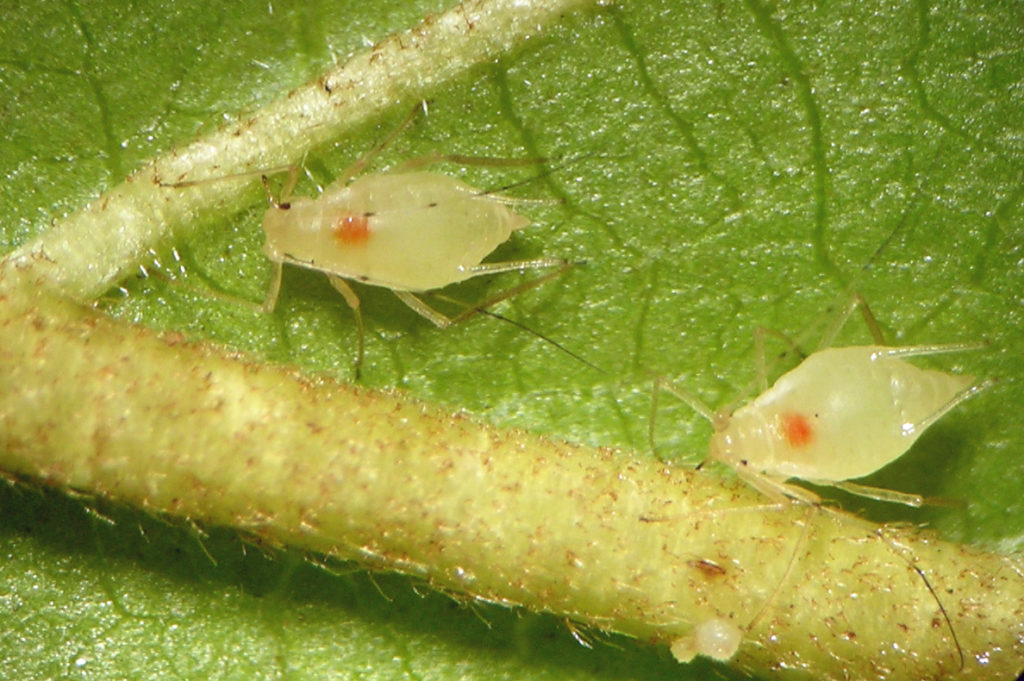
Macrosiphum rosae (L.)
Quite possibly, this is the most widely known aphid species in the Northern Hemisphere.
Almost everyone who has a garden, or knows somebody with a garden, or walks by other people’s gardens, knows about rose aphid, Macrosiphum rosae. It is the aphid that occurs across most of the world on cultivated roses. What even some entomologists don’t know, however, is that this aphid also feeds on teasel (the genus Dipsacus), and sometimes other plants such as Potentilla, Epilobium, and Ilex (holly). This aphid is native to Europe, where a close relative (Macrosiphum knautiae) lives throughout the year on Knautia — a close relative of Dipsacus. In most places I’ve lived, M. rosae lives without a sexual cycle throughout the year on roses, or migrates in from places where this is possible. That said, I do have two fundatrices in my collection, indicating a sexual cycle sometimes occurs in northwestern U.S.A.

Macrosiphum rudbeckiarum (Cockerell)
I still remember the first time I found this species after many years of looking on Rudbeckia (its host) everywhere I went. It was in northern Idaho along a meandering stream that at intervals broke out into wide marshy ponds. Moose were nearby, and I found this aphid on the lower leaves of tall Rudbeckia plants adjacent to a moose trail that crossed the stream. Just as described by earlier authors, this aphid lives on the lower leaves of its host, and appears to be mostly restricted to the more interior mountains of Idaho and adjoining states.
Like so many species of Macrosiphum in North America, it is generally similar to M. euphorbiae, but in life appears to be more long bodied and bigger in general, and finding it on the lower leaves in cool shaded locations is also a good hint. In one location in Utah, in the hills above Salt Lake City in the fall, I was collecting Macrosiphum on the leaves of both Rudbeckia and Agastache in the same location as was M. euphorbiae. After mounting, I found just how similar these species are. It seems to me that Macrosiphum has recently diversified in the West, leaving biologically distinct species very similar in morphology.
I now have this species from Idaho, Montana, Utah, Colorado, and New Mexico.
An amendment to all of this as of February 2025 is that I should always value the intuition of some of my talented predecessors such as Miriam Palmer. As I was looking through all my undetermined material and writing the section at the bottom of this page for putative undescribed species, I was prompted to compare one of them to M. rudbeckiarum, which prompted me to study all my samples of the latter species more carefully. What I found is that there are clearly two taxa mixed among my samples identified as M. rudbeckiarum. They are quite easily separated by relative lengths of the R IV+V and hind tarsus, degree of spinulation ventrally on the head, and numbers of rhinaria on ANT III (possibly among other things, were I to dig deeper). Interestingly, back in 1949 F.C. Hottes published a redescription of what he had thought was M. rudbeckiarum. He did this because Cockerell’s description was incredibly brief, as was the way in 1903. This work by Hottes was read my Miriam Palmer who noticed a distinction between what Hottes had studied and what Cockerell had written (and I think that she had seen when studying Cockerell’s specimens), especially in terms of the number of rhinaria on ANT III. She contacted Hottes and suggested that what he described was in fact probably a different species. Hottes then in 1950 responded to her suggestion by coining a new name for what he described in 1949, calling it Macrosiphum cockerelli. In 1952 Palmer covered these two forms quite well in her book Aphids of the Rocky Mountain Region, then very little was said about these forms until 2005 when Eastop and Blackman declared M. cockerelli to be a junior synonym of M. rudbeckiarum. They stated that “there are no other significant differences” and that no specimens with low numbers of rhinaria as in Cockerell’s specimens had since been collected and that therefore “It is highly unlikely that there are two separate species.” Well, it looks to me like Palmer was probably right. I have material that fits Cockerell’s side of the picture from New Mexico and Utah, while material fitting Hottes side is from Idaho, Oregon, Montana, and Colorado. To be even more certain on this page or in publication, I would require additional collecting especially in New Mexico near Las Vegas where Cockerell studied in the early 1900s.
Macrosiphum salviae Bartholomew
Sadly, I have never collected this species nor seen it alive despite having to study it a lot for my Ph.D. thesis and other contemplation of generic-level classification. It feeds on Salvia and related members of the mint family (Lamiaceae) in warm climates like southern California, Mexico, etc. There is continuing debate about whether it should be considered a member of Macrosiphum or Sitobion. My view is that either genus is fine and it doesn’t really matter either way because both genera are assemblages of species with questionable levels of relatedness. Until a thorough evaluation of relatedness can be completed, generic placement is a matter of convenience for the sake of communication among humans, and I think M. salviae fits fine in either category when that purpose is in mind. It fits Sitobion well because it has a sclerotized abdominal tergum that is usually pigmented to varying degrees in a very similar fashion to typical members of Sitiobion such as S. avenae. On the other hand, apart from this pigmentation, it looks much like the species currently placed in Macrosiphum that have sclerotized but pale abdominal terga. So, the debate might revolve around whether this is a Sitobion, deviating from the normal monocot-feeding biology and morphology of that genus, or a Macrosiphum of the kind common in western North America except for developing pigmentation in the sclerotized abdominal tergum. Anyhow, although I’ve never collected this species, I have three slides (and samples) from southern California kindly sent to me by Jesse Rorabaugh, an avid amateur naturalist who helped me with a couple papers several years ago.
Macrosiphum schimmelum Jensen
I described this species after many years of collecting it and getting to know its biology in the field. In my 2015 paper I wrote, “This species has been found almost everywhere that I have seen its host, L. utahensis. Fundatrices live singly on the undersides of leaves, and are dusted with highly variable amounts wax, as are their offspring. Recent presence of the aphid can often be detected by the waxy residue left on the leaf surfaces. Aphids congregate on flowers and fruits when they become available, until fruits are fully mature. Alatae seem to be produced primarily during fruiting of the host plant. In any given forest location this aphid is usually widespread but in low numbers on each host shrub, living both in heavily shaded areas and exposed slopes and clearings. Lonicera utahensis is known from southern British Columbia and Alberta in the north to Wyoming and Utah in the south (Kershaw et al. 1998).
Fundatrices have been collected in May and well into July; the latter dates are not understood, considering the fundatrices found in May were from a similar habitat and elevation. It is possible that egg hatch occurs over a protracted period in this species, perhaps due to its montane habitat, and it is also possible that the fundatrices collected in July were simply long-lived and intermingled with their daughters and granddaughters on the plants.”
I have material from British Columbia, Washington, Oregon, Idaho, and Wyoming.
Macrosiphum stanleyi Wilson
This common species is one of the biggest and spindliest aphids I know. It feeds on elderberries, genus Sambucus (Caprifoliaceae), and is found from the Rocky Mountains to the ocean coast. I’ve seen it in habitats from dry steep slopes of mountains in New Mexico to the deepest darkest understory of western Oregon rain forests. The alates are striking, with very pale body except a dark brown thorax.
I have material of this aphid from British Columbia, Washington, Oregon, Idaho, Utah, and Colorado. I saw a colleague collect it in New Mexico as well.
Macrosiphum stellariae Theobald
This species name has been used for Macrosiphum collected on quite a variety of host plants in British Columbia that do not conform with the idea mentioned elsewhere that it feeds mostly on Caryophyllaceae. Many of the slides I remember seeing of it from B.C. were so badly made that I don’t know how species identification was possible. I have identified the species twice, once in Seattle, Washington where I found the specimens on what I thought was an ornamental Lonicera, and once in Berkeley, California on what I thought was a giant ornamental Pedicularis. These two samples are substantially similar and sure seem to be conspecific. And, they look like many of the other European Macrosiphum species I’ve mentioned above (i.e., they are not M. euphorbiae). So it seemed reasonable to me to file them under M. stellariae until a better idea comes along.
Macrosiphum tenuicauda Bartholomew
This form was described from California feeding on Urtica. Although the description is relatively lengthy for its time, it is not adequate to tell whether Bartholomew was looking at M. euphorbiae or a different species actually worth describing as new. I have avidly collected on Urtica for decades and have only found something that might be M. tenuicauda 5 times in central Oregon to northern California. Blackman and Eastop’s online key to aphids on Urtica suggests that M. tenuicauda has a longer R IV+V compared to HT II than does M. euphorbiae. My specimens trend in this direction, but with many specimens considered from much of M. euphorbiae‘s range in time and space I think the ratios they use in the key will not hold true. My specimens filed under this name do indeed seem to have long-ish setae, and they also tend to have more spinules on the ventral surface of the head between clypeus and antennae. Long story short, this species might be legitimate and I might have 5 samples of it from Oregon and California.
Macrosiphum thermopsaphis Knowlton
This species name is officially considered a synonym of M. zionense, but I disagree with this assessment. I cover the details of my opinion above under M. albifrons, to which this species is very similar in life. Originally described from Thermopsis in central Colorado, I have samples on Thermopsis from Colorado, Utah, and New Mexico. These include all morphs: fundatrix, apterous and alate females, oviparae, and alate males. Because these samples are easily separated from M. albifrons and M. zionense (sometimes collected together with the latter species on Thermopsis), I think it best to highlight this fact by using Knowlton’s species name. By no means do I consider this to be an official nomenclatural act — remember that this website is solely for entertainment!
Macrosiphum tolmiea (Essig)
I worked on the field biology of this species for several years in grad school, it being one of the aphids I searched for during my weekly trips to McDonald State Forest outside of Corvallis. During that time and in that location, it seemed to be anholocyclic on its hosts in the Saxifragaceae (e.g. Tolmiea, Tellima, and Mitella), almost completely disappearing during the summer and appearing seemingly from nowhere in the spring. Since that time I was lucky enough to find M. tolmiea in the fundatrix stage on the lower slopes of Mt. Baker in Washington, confirming that at least sometimes it is holocyclic. I still have material only from British Columbia, Washington, and Oregon in the wet forests west of the Cascade Mountains.
Macrosiphum tonantzin Peña-Martinez, Muñoz-Viveros, & Jensen
This is an aphid I had the pleasure to work on with colleagues I’ve never met in Mexico (and California!). They found M. tonantzin living on the non-native tree Pittosporum undulatum in Mexico City. In the paper describing this species, we wrote, “So far this aphid is only known from a single site in Xochimilco area of southern Mexico City. Here, it lives throughout the year on the growing tips of ornamental trees of P. undulatum. The second and third authors have observed that P. undulatum is not a common plant in Mexico City, and the site where they find M. tonantzin is the only site they have seen this plant. Further, they note that Pittosporum tobira (Thunb.) W.T. Aiton is common in Mexico City but despite extensive searching they have not been able to find M. tonantzin feeding on it. The production of alate males starting in December, in the absence of oviparae, suggests that this aphid’s native biology may be heteroecious. The species is, however, so far not known from any native plants. … The species is meant to honor the Nahuatl name for an Aztec mother goddess.” My hypothesis presented in this paper was that M. tonantzin is a species native to Mexico that has successfully acquired P. undulatum as host. An alternative hypothesis, that this aphid is native to Australia or another place where Pittosporum grows naturally, cannot be entirely discounted, however.
Macrosiphum tuberculaceps (Essig)
This is another species I really enjoyed working on. Essig did a great job of describing M. tuberculaceps, but the samples he worked from were not associated with a known host plant. I covered this species in my 2000 paper, as follows, “The description and figures by Essig (1942) are adequate. At the time of his description, the actual host plant of this species was not known, which probably led to its never being identified since. It should be noted that the dorsal head tubercles for which Essig named this species are not the usual condition for the species. The single available alate vivipara has large spinal tubercles on the head, but these are in the normal position, not as drawn by Essig.” And, “This species is monoecious holocyclic on its only known host plant, Achlys triphylla (Smith) DC. (Berberidaceae). In the Corvallis area, egg hatch occurs in March. Fundatrices mature in April. Alatae are rarely produced. Oviparae and the rarer alate males can be found in October and November. Populations are dispersed, with few aphids on any given plant. The aphid is rare and difficult to find at times. Adults are apt to drop when plants are disturbed.”
I know this species from British Columbia, Washington, and Oregon.
Macrosiphum valerianae (Clarke)
In 2012 I published a paper that included what i knew about this interesting aphid:
Jensen, A.S. 2012. Macrosiphum (Hemiptera: Aphididae) Update: One New Species, One Synonymy, and Life Cycle Notes. Proceedings of the Entomological Society of Washington 114: 205-216.
In that paper I wrote, “Host plants I have witnessed this aphid reproducing on in nature include: Apiaceae – Lomatium sp.; Asteraceae – Taraxacum officinale; Brassicaceae – Arabis sp.; Melanthiaceae – Zigadenus sp.; Onagraceae – Epilobium angustifolium L.; Rosaceae – Geum macrophyllum, Geum rivale, Geum triflorum Pursh, Potentilla sp., Rosa acicularis; Scrophulariaceae – Pedicularis groenlandica, Penstemon sp.; Valerianaceae – Valeriana sp. Additional hosts recorded in the literature include: Asparagaceae – Camassia scilloides (Raf.) Cory; Asteraceae – Hymenoxys hoopesii (A. Gray) Bierner, Rudbeckia sp.
This aphid is monoecious holocyclic, probably with several overwintering hosts. On 29 May 2010 at about 1000 meters elevation, many Zigadenus plants were supporting colonies of M. valerianae that had been established by alate viviparae. A few colonies were found that were older and had a single fundatrix and an occasional apterous vivipara. It was clear in that site and time that fundatrices were quite old, and that most of their first generation offspring had been alate.
Macrosiphum valerianae is known from most U.S. states and Canadian provinces in the western half of North America. It is most often found in mountains and foothills.”
In 2020 I published my finding that Macrosiphum potentillicaulis Miller is a junior synonym of M. valerianae. It was really nice to finally resolve that question, originally brought up during my work with Macrosiphum impatientis in the 1990s.
Since my 2012 publication I’ve added more host plants to the list: Orobanchaceae: Castilleja; Rosaceae: Dryas; Saxifragaceae: Saxifraga. In addition to these are some collections from plants that I did not recognize at the time and did not, or was not able to, get genus identifications for.
I now have two slide boxes devoted to this species, having collected it from British Columbia, Quebec, Washington, Oregon, Idaho, Colorado, Wyoming, and New Mexico. I was lucky enough to get some good photos over the years as well.
Macrosiphum vancouveriae Jensen
Another fondly remembered aphid, this is also one I was the first to discover during the early 1990s. It is striking that this species and M. tuberculaceps often live in the same forests, on related and peculiar herbs in the Berberidaceae. In the McDonald State Forest where I studied aphids for grad school, this aphid was fairly easy to find, but outside of that habitat I have searched hundreds or thousands of its hosts, Vancouveria hexandra, and found it in only a few additional sites. Any time a species I’ve described is so hard to re-collect after the description is published, I start to wonder whether the whole thing was my imagination. This feeling has been particularly acute with M. vancouveriae until September of 2019 when I finally found it again on the Rogue-Umpqua Divide in Jackson County, Oregon. I still have material only from Oregon.
Macrosiphum venaefuscae Davis
Davis (1914) provided a nice description of this species, much like the one mentioned above for M. creelii. It is known from various genera of Polygonaceae in eastern North America. It is fairly distinctive in that part of North America by having dark siphunculi and antennae, and the tips of femora and most of tibiae trying to be brown. It has spinal tubercles on abdominal tergites VII and VIII and its abdominal lateral tubercles are quite large. I have collected it twice, once in Quebec and once in Maine.
Macrosiphum violae Jensen
Another obscure and uncommon species I discovered in McDonald State Forest in Oregon during my Ph.D. thesis work. I published on it in 2000, commenting as follows, “This species is monoecious holocyclic on its host Viola glabella Nutt. Egg hatch in the Corvallis area occurs as the leaves are unfolding in March. Fundatrices mature by mid-April. Aphid numbers reach their peak during flowering in late-emerging plants and fruiting in earlier-emerging plants. Apterae reproduce slowly throughout the summer, rarely producing alatae. Sexuales are produced in September and October.
Attempts to transfer this species to Vancouveria hexandra and Viola sempervirens Greene were both unsuccessful. The transfer to V. sempervirens was done in the laboratory, where after one day the transferred fundatrix left the plant, and its single deposited nymph was dead. Transfers to V. hexandra were attempted in the field, where adult females survived for several days, but did not settle or reproduce.”
Like a number of aphids that live on herbs in the forest, this species is found only in microhabitats where the host plant is able to remain vegetative throughout the summer into fall. In many sites Viola glabella dies back well before fall due to dry soil.
I still have only found this aphid in Oregon and Washington.
Macrosiphum walkeri Robinson
This is one of the fern-feeding species that I studied extensively for my 2000 paper with Jaroslav Holman. At the time I believed it to be anholocyclic with a wide host range on various ferns. Since that time I published on the heteroecious life cycle of this species in the southwestern U.S., where it uses Holodiscus (Rosaceae) as primary host. In that paper I wrote the following about this species.
“The biology and complex history of M. walkeri, and the name previously incorrectly used for many samples of aphids from miscellaneous ferns in western North America, Macrosiphum adianti (Oestlund), was covered in detail by Jensen and Holman (2000). At the time there was no proof of a holocycle for this species and in fact it was definitively shown to be anholocyclic in western Oregon on the common forest ferns Polypodium glycyrrhiza D.C. Eaton and Polystichum munitum (Kaulf.) Presl. Jensen and Holman (2000) noted that some samples identified as M. clydesmithi in dry areas such as eastern Oregon and Washington, and New Mexico and Arizona did not conform well with most M. clydesmithi, having thicker siphunculi, longer setae, and sometimes secondary rhinaria on ANT IV in alatae. Over the years I gradually accumulated samples from New Mexico (during annual autumn vacations), collecting on Holodiscus, that looked like migrants of M. walkeri. This suggested that there were heteroecious holocyclic populations of M. walkeri outside of the warm and wet forests west of the Cascade Mountains and Coast Range. This made sense considering a few samples of fern aphids from cold high–elevation locations where anholocycly is unlikely. This mystery was definitively settled in 2019 when I found a dense infestation of M. walkeri on a tall H. discolor shrub adjacent to the Trampas Creek Trail in the Carson National Forest of New Mexico. The leaves of this plant were coated in aphids: alatae, oviparae, and males (Fig. 35). This find prompted a vigorous search for aphids on all ferns living nearby, aiming to confirm that aphids were emigrating from one of them. On a steep slope adjacent to a stream near the trail, from an unidentified small fern, I was able to recover a single apterous vivipara, three males, and numerous nymphs. Later microscopic inspection showed that the samples from Holodiscus and the unidentified fern were conspecific and fit the concept of M. walkeri. It was later discovered that some specimens collected from Holodiscus (uncertain species due to intermediate leaf size) from the San Isabel National Forest near Maysville, Colorado were also M. walkeri.”
Since then it has become clear that the mystery surrounding M. walkeri has not been completely solved. I have several samples of what might be identified as this species from various ferns east of the Cascade Mountains that are almost certainly exhibiting a monoecious life cycle on ferns and that can be morphologically separated from the heteroecious forms in the Southwest and the anholocyclic forms west of the Cascades. For example, at a dry Ponderosa pine site in SE Oregon called Devil’s Garden a small fern grows along intermittent stream courses under the shade of trees. This fern is green during the spring and early summer, dying back in the late summer to dry crispy fronds. On this fern lives an M. walkeri-like aphid. Another example is a very similar aphid living on Cystopteris next to a waterfall in the forest south of Twin Falls, Idaho.
I now have material of this ‘species’ from Washington, Oregon, California, Idaho, Colorado, New Mexico, and British Columbia. As always, this pattern reflects where I’ve lived and collected more than it shows the true distribution of this animal.
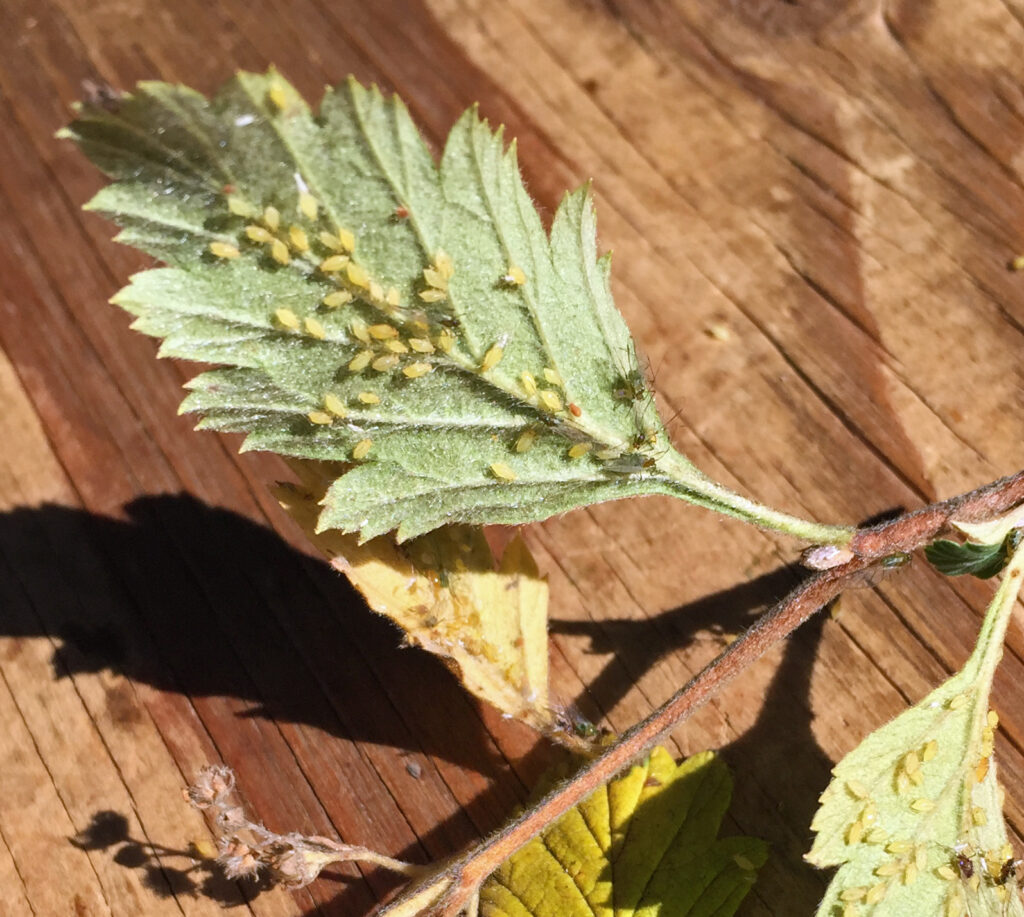
Macrosiphum willamettense Jensen
I discovered this species during my Ph.D. thesis work, originally in the wet flat land of the central Willamette Valley of Oregon, hence the species name. It was published in 2000 (see my list of publications above).
This is what I wrote about the species back then, “This species is monoecious holocyclic on its host Spiraea douglasii Hook. It is often difficult to find, even on plants that are infested. The aphids seem to prefer the freshest growth of the plants. This fresh growth is often on the water sprouts around the edges of the plant patch. The plant is an inhabitant of wet places like swamps and wet meadows, but in practice the commonest place to see it is in roadside hedgerows. Macrosiphum willamettense sometimes lives together on the same plants with Illinoia spiraeae (MacGillivray).”
Since the original description I have found this aphid in many other places, and its known range now includes British Columbia, Washington, Oregon, Idaho, and Montana.
Macrosiphum wilsoni Jensen
I named this species after one of my heros of aphid taxonomy, H.F. Wilson, who worked in Corvallis, Oregon in the early 20th century. I described this species in 2000 and since have had a little remorse about the decision — I am not sure how many species we have in northwestern North America on the big forest lilies. It seemed clear during my Ph.D. work that there were two, M. wilsoni, and Macrosiphum insularis Pergande. However, several samples I have seen from Idaho and British Columbia have made me doubt my judgement back then. Anyhow, maybe more field work will resolve the issue.
Back in 2000 I wrote about M. wilsoni, “This species has a simple monoecious holocyclic life cycle on species of Disporum. It has been collected on Disporum hookeri (Torr.) Nicholson and Disporum smithii (Hook.) Piper. Both of these plants are perennial, and remain vegetative throughout the summer months. Alatae migrate readily from their home plant upon emergence. The species is often difficult to find in McDonald State Forest because it is not faithful to particular patches of plants year to year, as are some other species described above.”
I now have identified this species from Oregon, Washington, British Columbia, and Idaho.
Macrosiphum woodsiae Robinson
Here is the final fern-feeder that Jaroslav Holman and I published on back in 2000. Back then we wrote: “Biology and distribution. This species was described from Canada in the Northwest Territories and Manitoba, quite far north for many insects. It appears to be associated with ferns in colder habitats such as high latitudes or high altitudes, based on the collections we have seen. Little is known about the biology of this species. It has been found on Woodsia ilvensis (L.) R. Br., Woodsia oregana D.C. Eat., Woodsia scopulina D.C. Eat., Cryptogramma crispa (L.) R. Br. and Pellaea. One ovipara is known from W. ilvensis, suggesting a monoecious, holocyclic life cycle, but no firm conclusions can be drawn from this fact (see the biology of M. rhamni). In Oregon it was found living on very small Cryptogramma plants growing out of cracks in a rock road-cut facing east at about 1000 m elevation. In another Oregon site it was on W. oregana growing out of cracks in a small lava outcrop in a Pinus ponderosa Dougl. forest at about 800 m elevation.
This species is known from the Northwest Territories, Manitoba (Robinson, 1980) and British Columbia, Canada and Oregon and Pennsylvania in the United States. Types are in the CNC, with paratypes in the USNM.
Systematic position. This species is easily separated from other fern-feeding Macrosiphum except M. longirostratum by the very setose u.r.s., and rhinaria spread over the length of a.s. III in apterous viviparae. Aside from M. longirostratum, it is probably most closely related to M. cystopteris. Both species have a relatively setose u.r.s., rhinaria on a.s. IV of alate viviparae, and M. woodsiae sometimes has dorsal pigmentation similar to M. cystopteris. The two species can be separated by the darker dorsal pigmentation in M. cystopteris, and the normal presence of rhinaria throughout the length of a.s. III in apterous viviparae and usually more setose u.r.s. in M. woodsiae. M. woodsiae and M. longirostratum are obviously very closely related, sharing congeneric host plants, extremely setose u.r.s. and rhinaria on the antennae of apterous viviparae often scattered the whole length of a.s. III. The u.r.s. of M. woodsiae is distinctly shorter than in M. longirostratum (viz. the key), and the alate viviparae have 5-11 rhinaria on a.s. IV (the single alate vivipara of M. longirostratum lacks rhinaria on a.s. IV).”
Since this paper I have also collected this species in Washington, Idaho, Wyoming, and Colorado.
Macrosiphum zionense Knowlton
This is a really fabulous aphid, probably a close relative of M. albifrons. Although the specimens in the photos are yellow and green, M. zionense is often a beautiful orange color, with striking dark siphunculi and tibiae. It feeds on a plant called Thermopsis (‘golden pea’) in the mountains of the interior west of North America.
Throughout most of the season the aphids are found on the upper stems of the plant, but later in fall as the plants decline and the aphids transition to the oviparous female and male stages, they are found on the lower stems of the plants, just above the soil level, or on stems of plants that have fallen over during the growing season.
For additional discussion of this species, see above under M. albifrons.
I have specimens from Oregon, Idaho, Colorado, and Utah.
Putative Undescribed Species in My Collection
Macrosiphum sp. apparently specific to Agastache and Monardella
I have about 100 slides of specimens from these two Lamiaceae hosts collected in Oregon, California, Idaho, Utah, and Nevada. They are similar to Macrosiphum euphorbiae, but I could come up with diagnostic characters if I put my mind to it. The key reason I have not published this as a new species is that I am not sure whether the forms on Agastache and Monardella are not in fact different species; specimens on Monardella are usually smaller than those on Agastache but otherwise look very similar. When we lived in southern Oregon I did extensive field observation and collecting on these two plants, but I was not able to make strong conclusions. I have a few fundatrices and even fewer sexuales, making me worry a bit whether I understand the life cycle(s) of this form(s).
Macrosiphum sp. apparently specific to Oplopanax horridus
The host plant of this form is one of the most dramatic plants in western North American forests. Known as devil’s club, it is a member of the Araliaceae that grows in wet shady places in appropriate forest ecosystems along the Pacific coast, with disjunct populations near the Great Lakes. It can reach heights of 5 meters, is coated in spines, and has large palmate leaves and large clusters of red berries. I find both this Macrosiphum and a species of Aphis on this plant practically every time I find it in flower or in fruit. I was able to find the fundatrix near Mt. Jefferson in Oregon in 2018. Frustratingly, its morphology is not very distinct, seems to vary a bit, and in many respects is similar to M. euphorbiae and a few other North American species. Based on the material I have at the moment (16 slides based on 7 samples, all from Oregon and Washington), writing a good description and diagnostic notes would be challenging.
Macrosiphum sp. apparently specific to Vaccinium scoparium
Because of work on several other species (e.g., Macrosiphum opportunisticum, Macrosiphum parvifolii), I have avidly collected on Vaccinium (Ericaceae) everywhere I go for 3 decades now. Along the way I occasionally got this form that did not fit anything else I was getting. After accumulating 11 samples, all from Vaccinium scoparium, across the west (Oregon, Idaho, Montana, Utah, Wyoming, and Colorado), a consistent, recognizable taxon has become apparent. I have 24 slides representing those 11 samples, including 1 fundatrix, many apterous viviparae, and a few oviparae. This is one of the many species in North America that has a pale sclerotized tergum and short setae on dorsum and appendages. The siphunculi have relatively reduced reticulations with an oddly flared apical flange, the R IV+V is very short with few setae, among other distinctive features. If I could find some alate viviparae I’d probably consider my set of samples adequate to describe a new species.
Macrosiphum sp. apparently specific to Trautvetteria caroliniensis
This aphid is distinctive mostly because of its appearance in life and its widespread but not common host plant in the buttercup family (Ranunculaceae). In life this aphid can take two color forms, most of my samples being a weird dark purple color, and one sample being bright orange. The aphids live in small groups on the flowering stalks when available, but otherwise live on the large palmate leaves, usually singly along the leaf margins. It has long hairs generally and a pale membranous dorsum. It often has spinal tubercles on ABD VII and VIII. I have 4 samples of this form from British Columbia, Idaho, and Oregon, represented by 11 slides. When I chance upon a patch of this plant, I often must search dozens of plants to find just a few specimens.
Macrosiphum sp. apparently specific to Oxalis
My samples of this aphid are all from groves of redwood trees in southern Oregon and northern California. Its Oxalis host (Oxalidaceae) is a common understory plant in redwood groves. In life it is more or less white or pale yellow. On slides it is rather bland, without many distinctive features except the alatae having only about 5 secondary rhinaria on ANT III. It would be challenging, but probably possible to write a useful description and diagnosis of this form, but I would prefer to have far more samples. I have searched Oxalis in many habitat types other than redwood groves without success. I have 4 samples on 7 slides, including apterous and alate viviparae.
Macrosiphum sp. collected from a pale-colored Vaccinium(?) in the Uinta Mountains
Back in July of 2012 we made the arduous drive to up to the highest elevations that roads marginally adequate for high-clearance 4-wheel drive trucks can take one into the Uinta Mountains of Utah. There I tapped on a shrub that I think was a Vaccinium with unusually pale greyish foliage. On it were many medium-sized pink and green Macrosiphum-like aphids that don’t look like anything I’ve seen elsewhere or on other plants. It has short siphunculi, fairly big lateral (abdominal II-VI) and spinal tubercles (abdominal VII and VIII), a very short R IV+V with few hairs, and a membranous abdominal tergum. I have only 2 slides representing 9 specimens.
Macrosiphum sp. collected from a Streptopus(?) New York
For a few years I made a habit of scheduling an extra day into my work-related trips around the country to collect aphids (my work was in potato production research, not aphid science). In August of 2008 a work trip took me to Buffalo, New York and on this extra day I rented a car and visited Allegany State Park. There I found a Macrosiphum living on what I thought was a Streptopus, but could have been some other genus of Liliaceae. Anyhow, the aphid is medium sized, pale, with long thin siphunculi, a sclerotized abdominal tergum, short R IV+V with few setae, and an unusual small patch of spinules ventrally on the head just lateral to the clypeus. I have 5 apterous viviparae on 4 slides.
Macrosiphum sp. collected from Thalictrum (Ranunculaceae) in Utah
I have a few weird samples of Macrosiphum that were living on Thalictrum (meadowrue). Two of these samples were from Utah in and near the Uinta Mountains. They are not particularly distinctive morphologically, having long thin siphunculi, a thick hairy cauda, membranous abdominal tergum, distinct imbrications on the ANT III, and a fairly long ANT VIa (Base). I collect on Thalictrum practically everywhere I see it, which is often, and Macrosiphum have been rarely found. It’s hard to say whether these aphids are specific to this plant.
Macrosiphum sp. collected from Thalictrum (Ranunculaceae) in Idaho
Now here is a really weird one; I have only one slide with 2 apterous viviparae on it, but it is distinctive enough to deserve a mention here. I found these specimens on Bishop Mountain in far eastern Idaho in August of 2012 feeding on a Thalictrum. Morphologically they are a mashup of Macrosiphum and Illinoia. They are very pale, have cylindrical siphunculi but 5 setae on tarsal segments I, have a very short hairy R IV+V, and rhinaria scattered along more than the basal 1/2 of ANT III. One of these specimens has 5 small parasitoid wasp larvae inside it, leaving open the possibility that these specimens are morphologically aberrant (e.g., possibly the siphunculi shape) due to parasite load, a reasonably common supposition I make in evaluating all the material I mount on slides.
Macrosiphum sp. apparently specific to Heracleum (Apiaceae)
This form has really perplexed me over the past 11+ years since I first found it. It lives on the lower, yellowing leaves of Heracleum lanatum (cow parsnip) in mid-elevation mountain settings. At first I suspected it to be an unusual form of Macrosiphum euphorbiae, but evaluation of the morphology of my samples shows it is clearly distinct. I also considered whether it is an alternate host of form of M. rudbeckiarum, but this seems to be ruled out by the very numerous scent plaques on the hind tibiae of oviparae compared to M. rudbeckiarum which has very few all clustered near the base. This form is characterized by a long-ish R IV+V, antennae very pale except the tip of ANT V and around the rhinaria on ANT VI, a thick cauda with very dense ventral spinules, and the very extensive scent plaques on hind tibiae of oviparae just mentioned. What is perplexing about this form is that I have found it only 3 times despite searching on almost every yellowing leaf of Heracleum I find, and the simple fact that it lives on yellowing leaves. Does it ever live on growing tips? Maybe the new stems as they emerge in spring? I dunno; I’ve failed to find any such thing so far. I have 3 samples of this form representing 8 slides from Oregon, Utah, and Colorado.
Macrosiphum sp. living on Dicentra in the Cascade Mountains of Oregon
In early September of 2016 we took a late summer camping outing to the Umpqua Divide, a sort of ridgeline along the crest of the Oregon Cascade Mountains. This was the camp when a deer walked by at night, looked into our tent window, and drank the dogs’ water just outside the tent door. Anyhow, it was up there that I found 4 small Macrosiphum specimens on a Dicentra (Fumariaceae). These did not match the other two species on Dicentra in the region, Macrosiphum corydalis and Macrosiphum dicentrae. They have very short antennal hairs, a lightly sclerotized abdominal tergum, thick siphunculi that are thicker just basad of the apical reticulation, and almost no spinules ventrally on the head except a few large ones on antennal tubercles.
Macrosiphum sp. apparently specific to Lonicera cauriana (Caprifoliaceae)
This is another of the group of similar and presumably closely related species in North America and Europe that all feed on Caprifoliaceae. Some day I should do a separate essay on this group of species so I can thoroughly explain what I mean. I first found this in September of 2016 on the Umpqua Divide in the Cascade Mountains of Oregon. At the time I was not sure about the host plant because fruits and flowers were not present. When I found it again in July of 2017 in the mountains west of Lakeview, Oregon, I was able to identify the plant as Lonicera cauriana. It has the usual features of this related group of species, i.e., siphunculi with a slight swelling basad of the apical reticulated section, large lateral and spinal tubercles (head and ABD VII and VIII), long ANT VIa, a pointed hairy R IV+V, among other things. I have 8 samples representing 20 slides all from Oregon.
Mysterious Macrosiphum species living on ferns in specialized sites
As noted above under my discussion of Macrosiphum walkeri, there appears to be at least one more species of fern-feeding Macrosiphum to describe from western North America. Many of the samples I’d previously identify as M. walkeri from east of the Cascade Mountains now appear to me to be different from M. walkeri west of the Cascades. For example, the form that lives on a small fern in dry Ponderosa pine sites in eastern Oregon, and the form that lives on Cystopteris next to a waterfall in southern Idaho. Among such samples I am confident that there is at least one more distinct species, but much more field work will be necessary to work out the details.
Not all my putative undescribed species are listed here
Note that a few probable new species are not listed here but mentioned elsewhere on this page such as the coverage of Macrosiphum californicum and Macrosiphum geranii. Also, I have two slide boxes of miscellaneous troublesome unidentified slides of Macrosiphum. Many of these are similar to M. euphorbiae but different enough that I thought it worthwhile to keep them in the undetermined section of my collection for easier reference.
Macrosiphum sp. # 1 living on Prunus serotina subsp. capuli (Rosaceae) in Mexico
Several years ago I collaborated with colleagues in Mexico to describe a new species we placed in Macrosiphum, M. tonantzin, which lives on an introduced Asian plant (Pittosporum) in the Mexico City area. As part of that work they kindly sent me samples of some other unidentifiable Macrosiphum species from Mexico. Two of these were collected on what they recorded as Prunus capuli but that we are apparently supposed to consider as a subspecies, Prunus serotina subsp. capuli. The first of these species is characterized by a sclerotized tergum, many spinules ventrally on the head, and short antennal setae, all much like many of the obscure species I’ve studied in the western U.S.
Macrosiphum sp. # 2 living on Prunus serotina subsp. capuli (Rosaceae) in Mexico
This second Mexican form living on Prunus serotina subsp. capuli is very different from the first, featuring thick siphunculi with oddly reduced apical reticulation, a membranous tergum, and practically no spinules ventrally on the head. Based on the timing of samples I have, I am guessing that this form lives without host alternation on this Prunus. Much more collecting on this species of Prunus could be very interesting. In March of 2025 we hope to find another subspecies of this plant in Arizona such as Prunus serotina subsp. virens.
Macrosiphum sp. living on Canna (Cannaceae) in Mexico
The samples I have of this form are from the Mexico City area. They are morphologically near M. euphorbiae, but are probably distinct based on host plant, location, habitat, pigmentation, and other minor features. Much more material from numerous sites would be necessary to be sure about this form’s status and features. Interestingly, one specimen of this form is unique among the many thousands of aphid specimens I’ve evaluated: it is an alate oviparous female! This specimen has hind tibiae fully ornamented in scent plaques, and also the additional hairs and other features typical of Macrosiphum oviparae, but it has fully developed wings and associated ultrastructure. I also have a typical apterous ovipara of this form, indicating that the alate condition is not consistent.
Macrosiphum (subgenus Unisitobion?) sp. living on Alnus (Betulaceae) in Mexico
Among the samples shared with me by my Mexican colleagues are several of an odd species that lives on Alnus in the Xochimilco region of Mexico City. It has a dark sclerotized dorsal patch on the abdomen, making it possibly a better fit in the subgenus Unisitobion or possibly the genus Sitobion (whatever that is, a whole other kettle of fish).

